Getac Technology 017 Notebook with WLAN and Bluetooth User Manual Revised
Getac Technology Corp. Notebook with WLAN and Bluetooth Users Manual Revised
Users Manual Revised

ML900
Operation Manual
Part Number: 7990 0114 3001 R00
(June 2005)

TRADEMARKS
All brand and product names are trademarks or registered trademarks of their
respective companies.
NOTE
Information in this manual is subject to change without notice.

i
Table of Contents
Preface......................................................................................vii
Chapter 1 Getting Started.....................................................1-1
Getting the Computer Running................................................1-2
Unpacking..........................................................................1-2
Connecting to AC Power ...................................................1-3
Opening the Cover .............................................................1-4
Turning On and Off the Computer.....................................1-5
Taking a Look at the Computer...............................................1-6
Right-Side Components.....................................................1-6
Left-Side Components .......................................................1-7
Rear Components...............................................................1-8
Front Components............................................................1-10
Bottom-Side Components................................................1-11
Top-open Components.....................................................1-13
Where to Go from Here.........................................................1-16

Chapter 2 Operating Your Computer.......................................... 2-3
Starting and Stopping the Computer...............................................2-4
Starting the Computer................................................................2-4
Stopping the Computer ..............................................................2-4
Using the Keyboard.........................................................................2-6
Typewriter Keys.........................................................................2-6
Cursor-Control Keys..................................................................2-7
Numeric Keypad ........................................................................2-7
Euro Symbol ..............................................................................2-8
Windows Keys...........................................................................2-8
Function Keys............................................................................2-8
Fn Key........................................................................................2-9
Hot Keys ....................................................................................2-9
Using the Touchpad ......................................................................2-11
Configuring the Touchpad .......................................................2-13
Using the Touchscreen (option)....................................................2-14
Using the Hard Disk Drive............................................................2-15
Using the DVD/Combo/DVD Dual Drive ....................................2-16
Installing the DVD/Combo/DVD Dual Drive..........................2-17
Inserting and Removing a Disc................................................2-18
Using the Video Features..............................................................2-19
Configuring the Display Modes...............................................2-19

Using the Audio Features..............................................................2-21
Connecting Audio Devices.......................................................2-22
Using the Communication Features ..............................................2-23
Using the LAN .........................................................................2-23
Using the Wireless LAN (option) ............................................2-24
Using the Modem.....................................................................2-25
Using the Wireless Modem (option)........................................2-26
Using the GPS (option) ............................................................2-28
Using the Bluetooth (option)....................................................2-29

iii
Chapter 3 Managing Power ..................................................3-1
AC Adapter..............................................................................3-2
Battery Pack.............................................................................3-3
Charging the Battery Pack .................................................3-3
Initializing the Battery Pack...............................................3-4
Checking the Battery Level................................................3-4
Replacing the Battery Pack................................................3-5
Battery Low Signals and Actions.......................................3-6
Power Management .................................................................3-7
Hibernation ........................................................................3-8
Power-Saving Tips ..................................................................3-9
Chapter 4 Expanding Your Computer..................................4-1
Connecting an External Monitor .............................................4-2
Connecting a USB Device.......................................................4-3
Connecting a Serial Device .....................................................4-4
Connecting an IR Device.........................................................4-5
Connecting a Bluetooth-compliant Device (option)................4-7
Connecting a Video Capture Device .....................................4-10
System Memory Upgrade......................................................4-11
Chapter 5 Setup Configuration Utility (SCU).......................5-1
When and How to Use the SCU Program................................5-2
When to Use.......................................................................5-2
Starting SCU......................................................................5-2
Moving Around and Making Selections............................5-4
Main Menu ..............................................................................5-5
Advanced Menu.......................................................................5-8
Security Menu..........................................................................5-9
Boot Menu.............................................................................5-13
Exit Menu ..............................................................................5-14
Chapter 6 Installing Software Drivers..................................6-1
How to Use the Driver CD ......................................................6-2

iv
Installing the Fingerprint Driver ........................................6-6
Installing the Video Capture Driver.................................6-10
Chapter 7 Caring for the Computer .....................................7-1
Protecting the Computer..........................................................7-2
Using the Password............................................................7-2
Using an Anti-Virus Strategy.............................................7-2
Taking Care of the Computer ..................................................7-3
Location Guidelines ...........................................................7-3
General Guidelines.............................................................7-3
Cleaning Guidelines...........................................................7-4
Battery Pack Guidelines.....................................................7-4
When Traveling .......................................................................7-5
Chapter 8 Troubleshooting...................................................8-1
Preliminary Checklist ..............................................................8-2
Solving Common Problems.....................................................8-3
Battery Problems................................................................8-4
Bluetooth Problems.................................................................
DVD/Combo/DVD Dual Drive Problems..........................8-4
Display Problems ...............................................................8-5
Fingerprint Recognition Problems .....................................8-7
Hardware Device Problems................................................8-7
Hard Disk Drive Problems.................................................8-7
Infrared Problems...............................................................8-8
Keyboard, Mouse, and Touchpad Problems ......................8-8
LAN Problems ...................................................................8-9
WLAN Problems................................................................8-9
Modem Problems ...............................................................8-9
Power Management Problems..........................................8-11
Printer Problems...............................................................8-12
Software Problems ...........................................................8-12
Sound Problems ...............................................................8-13
Startup Problems..............................................................8-14
Other Problems.................................................................8-15

v
Resetting the Computer .........................................................8-16
Appendix A Specifications ................................................... A-1
Appendix B Fingerprint Recognition System ..................... B-1
Finger Placement .................................................................... B-2
Using the Fingerprint Recognition System Utility ................. B-3
Appendix C Regulatory Information..................................... C-1
On the Use of the System ....................................................... C-2
Class B Regulations .......................................................... C-2
Safety Notices ................................................................... C-3
On the Use of RF Device........................................................ C-6
USA and Canada Safety Requirements and Notices......... C-6
European Union CE Marking and Compliance Notices ... C-9
Federal Communication Commission Interference Statement
This equipment has been tested and found to comply with the limits for a Class B
digital device, pursuant to Part 15 of the FCC Rules. These limits are designed to
provide reasonable protection against harmful interference in a residential installation.
This equipment generates, uses and can radiate radio frequency energy and, if not
installed and used in accordance with the instructions, may cause harmful interference
to radio communications. However, there is no guarantee that interference will not
occur in a particular installation. If this equipment does cause harmful interference to
radio or television reception, which can be determined by turning the equipment off
and on, the user is encouraged to try to correct the interference by one of the
following measures:
- Reorient or relocate the receiving antenna.
- Increase the separation between the equipment and receiver.
- Connect the equipment into an outlet on a circuit different from that to which
the receiver is connected.
- Consult the dealer or an experienced radio/TV technician for help.
This device complies with Part 15 of the FCC Rules. Operation is subject to
the following two conditions:
(1) This device may not cause harmful interference, and
(2) This device must accept any interference received, including interference
that may cause undesired operation.
INFORMATION TO USER
To assure continued compliance, (example - use only shielded interface
cables when connecting to computer or peripheral devices) any changes or
modifications not expressly approved by the party responsible for
compliance could void the user’s authority to operate this equipment.
IMPORTANT NOTE:
FCC Radiation Exposure Statement:
This equipment complies with FCC radiation exposure limits set forth for an
uncontrolled environment. This equipment should be installed and operated with
minimum distance 20cm between the radiator & your body.
This transmitter must not be co-located or operating in conjunction with any other
antenna or transmitter.

vii
Preface
This manual contains information that will help you operate the
computer. It is divided into 8 chapters and 3 appendices.
Chapter 1, Getting Started, takes you through the process of setting
up the computer and identifying its external components.
Chapter 2, Operating Your Computer, tells you how to use the
computer’s components and features.
Chapter 3, Managing Power, provides information on power.
Chapter 4, Expanding Your Computer, provides information on
installing and using peripheral devices.
Chapter 5, SCU (Setup Configuration Utility), describes the SCU
program that configures the computer’s BIOS settings.
Chapter 6, Installing Software Drivers, describes how to install the
drivers and utilities supplied with the computer.
Chapter 7, Caring for the Computer, gives you tips in care and
maintenance.
Chapter 8, Troubleshooting, gives solutions to common problems
you may encounter when using the computer.
Appendix A, Specifications, gives a brief specification of the
computer.

viii
Appendix B, Fingerprint Recognition System, provides
information on using the system’s fingerprint recognition system.
Appendix C, Regulatory Information, provides regulatory
statements and safety notices on your computer.
Notational Conventions
Throughout this manual, the following conventions are used to
distinguish elements of text.
NOTE: identifies additional information that requires special attention.
CAUTION: identifies important information which, if not followed, may result in loss of
data or damage to the computer.
Keyboard keys are shown in a bold typeset. For example:
Press Enter to complete.
When keys are joined by a plus sign (+), press the first key, and, while
keeping the first key down, press the remaining keys, finally release all
the keys. When necessary, keys are also shown in graphics.
A title, command, setup item, or button that you can see on the screen is
shown in boldface. A value or an option that you can select for a setup
item is shown in italic. For example:
Select Power Management, set it to Enabled, and then click the
OK button.

CHAPTER 1
Getting Started
Congratulations on purchasing this computer.
This high performance notebook computer is especially designed for the
practical applications of warehouses, automobiles, vehicles, public
security, repairing, assisting the handicapped, and other demanding
situations where conventional notebook computers just cannot measure
up.
This chapter first tells you step by step how to get the computer up and
running. You will find instructions for these procedures:
Unpacking
Connecting to AC power
Opening the cover
Turning on the computer
Turning off the computer
Then, you will find a section briefly introducing the external components
of the computer. And the last section navigates you to the information
you may need after the computer is ready for use.

1-2 Getting Started
Getting the Computer Running
This section guides you through the procedures for getting the computer
ready for operation.
Unpacking
After unpacking the shipping carton, you should find these standard
items:
Notebook computer
Accessories:
− AC adapter (100~240 VAC, 50/60 Hz)
− AC power cord (US/CE/UK/SA)
− Driver CD
− This Operation Manual
Inspect all the items. If any item is damaged or missing, notify your
dealer immediately.
Keep the shipping carton and packing materials in case you need to ship
or store the computer in the future.
Connecting to AC Power
The computer operates either on the external AC power or internal
battery power. It is suggested that you use AC power when you start up
the computer for the first time.
CAUTION: Use only the AC adapter included with your computer. Using other AC
adapters may damage the computer.
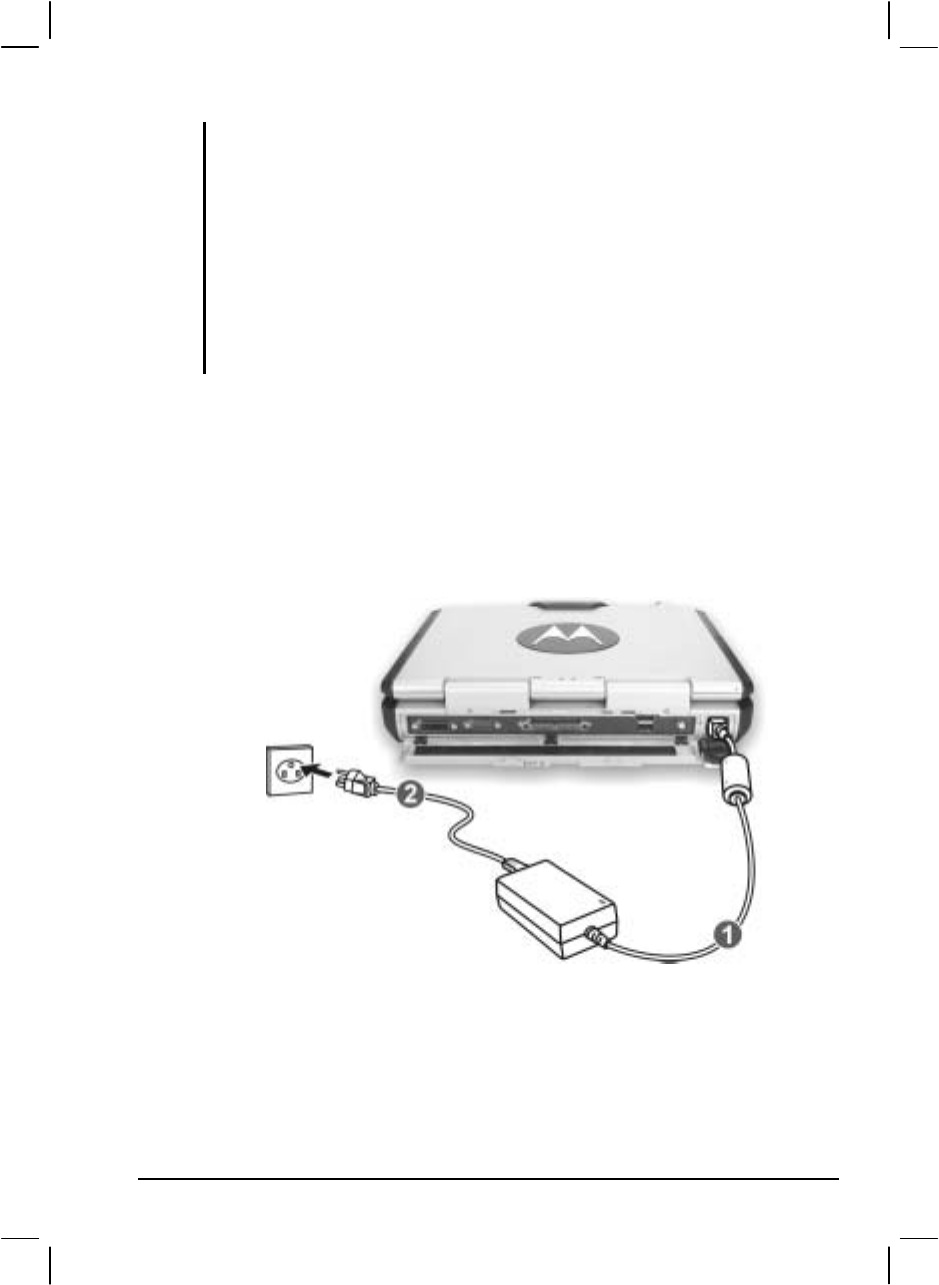
Getting Started 1-3
NOTE:
Power Supply Cord: (optional) Detachable, minimum 1.5 m long. Listed, rated
minimum 125 V, 7 A, having a 2/18 AWG, type SVT flexible cord. One end terminates
with a parallel blade, molded-on, attachments plug with a 7 A, 125 V (NEMA 1-15P)
configuration; other end terminates with a molded-on appliance coupler.
Alternative: (optional) Detachable, maximum 4.5 m (14.76 ft) long. Listed, rated
minimum 250 V, 6 A, having a 3/18 AWG, type SVT flexible cord. One end terminates
with a Tandem blade, grounding, listed molded-on, attachments plug with a 6 A, 250 V
(NEMA 6-15P) configuration; other end terminates with a molded-on appliance
coupler.
1. Make sure the computer is turned off.
2. Plug the DC cord of the AC adapter to the power connector on the
rear side of the computer () .
3. Plug the female end of the AC power cord to the AC adapter and the
male end to an electrical outlet () .
4. When the AC adapter is connected, the indicator on the AC adapter
lights up, indicating that power is being supplied from the electrical
outlet to the AC adapter and onto your computer. Now, you are ready
to turn on the computer.
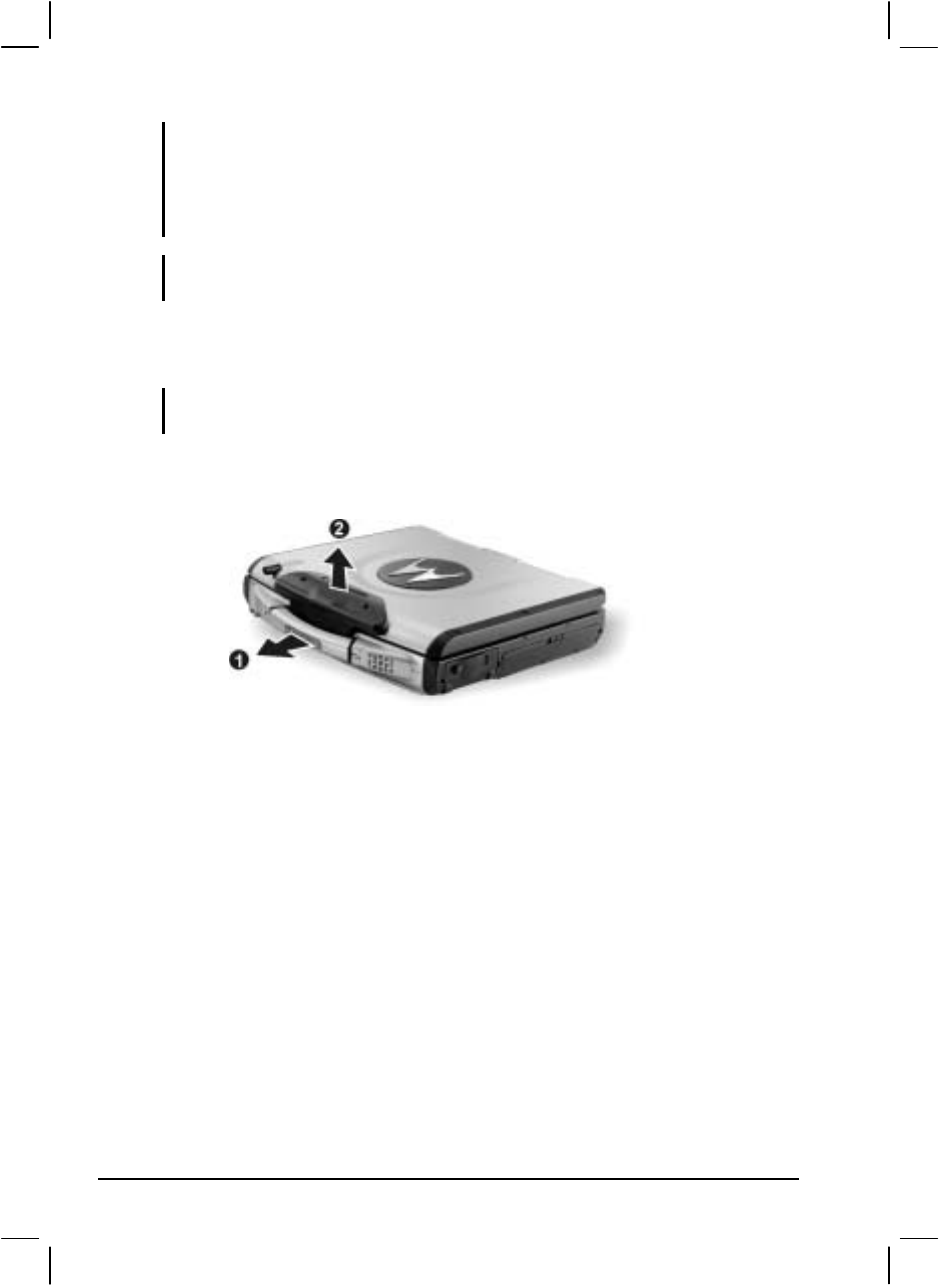
1-4 Getting Started
CAUTION:
When you disconnect the AC adapter, disconnect from the electrical outlet first and
then from the computer. A reverse procedure may damage the AC adapter or the
computer.
When unplugging the connector, always hold the plug head. Never pull on the cord.
NOTE: When the AC adapter is connected, it also charges the battery pack. For
information on using battery power, see Chapter 3.
Opening the Cover
CAUTION: Be gentle when opening and closing the cover. Opening it vigorously or
slamming it shut could damage the computer.
1. Open the top cover by pulling on the handle, inserting your index
finger, and then pulling on the cover latch.
2. Lift up the cover. You can tilt the cover forward or backward for
optimal viewing clarity.
Turning On and Off the Computer
Turning On
1. Make sure the computer is connected to AC power.
2. Press the power button.
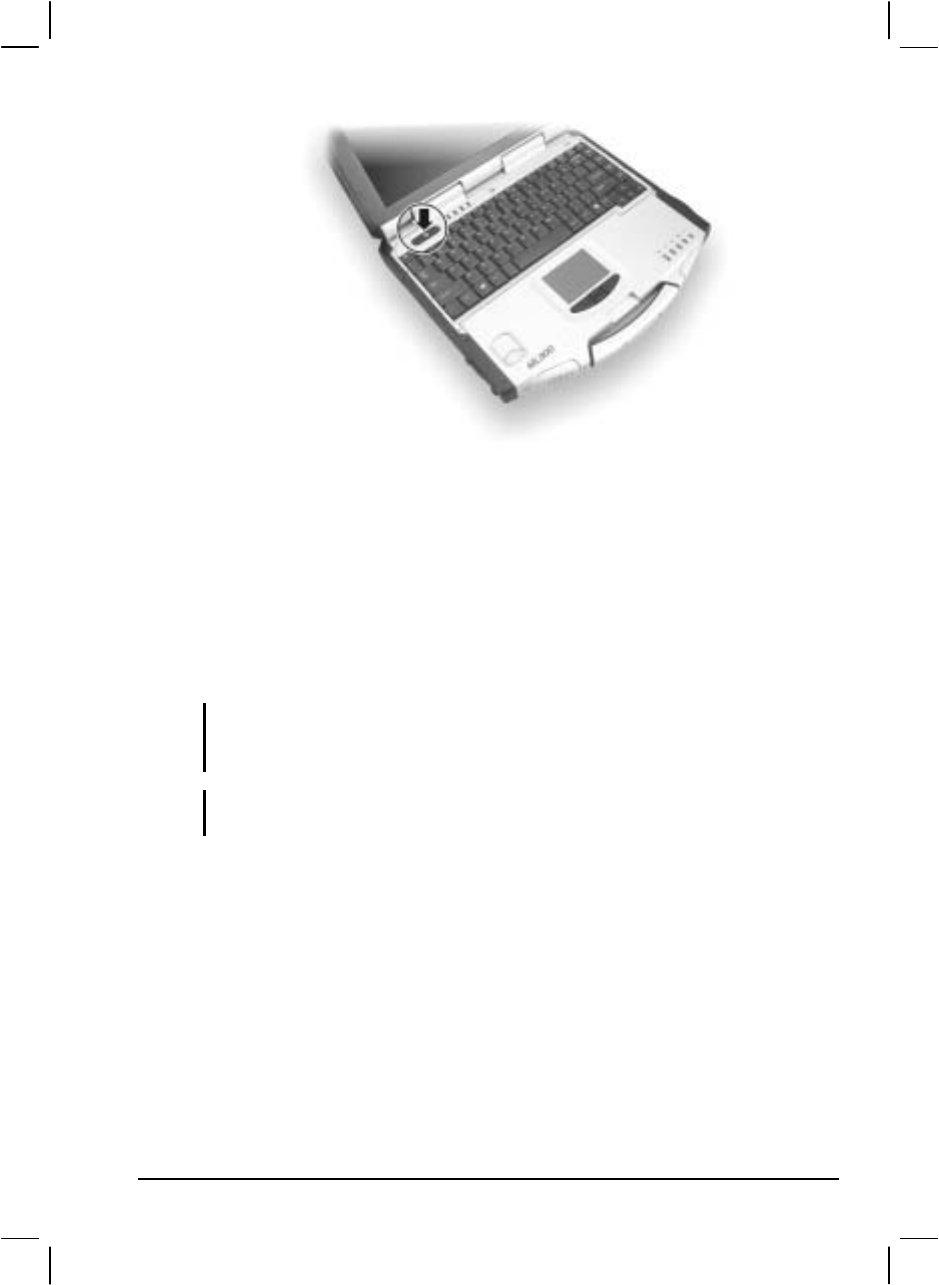
Getting Started 1-5
3. Each time the computer is turned on, it performs a Power-On Self
Test (POST), and the operating system such as Windows should
start.
Turning Off
To turn off the computer power, use the “Shut Down” command of your
operating system.
NOTE: There are other ways you can stop the computer so that you will be back to
where you left off when you next turn on the computer. (See “Stopping the Computer”
in Chapter 2 for information.)
CAUTION: If you have to turn the computer on again immediately after turning it off,
wait for at least five seconds. Turning the computer off and on rapidly can damage it.
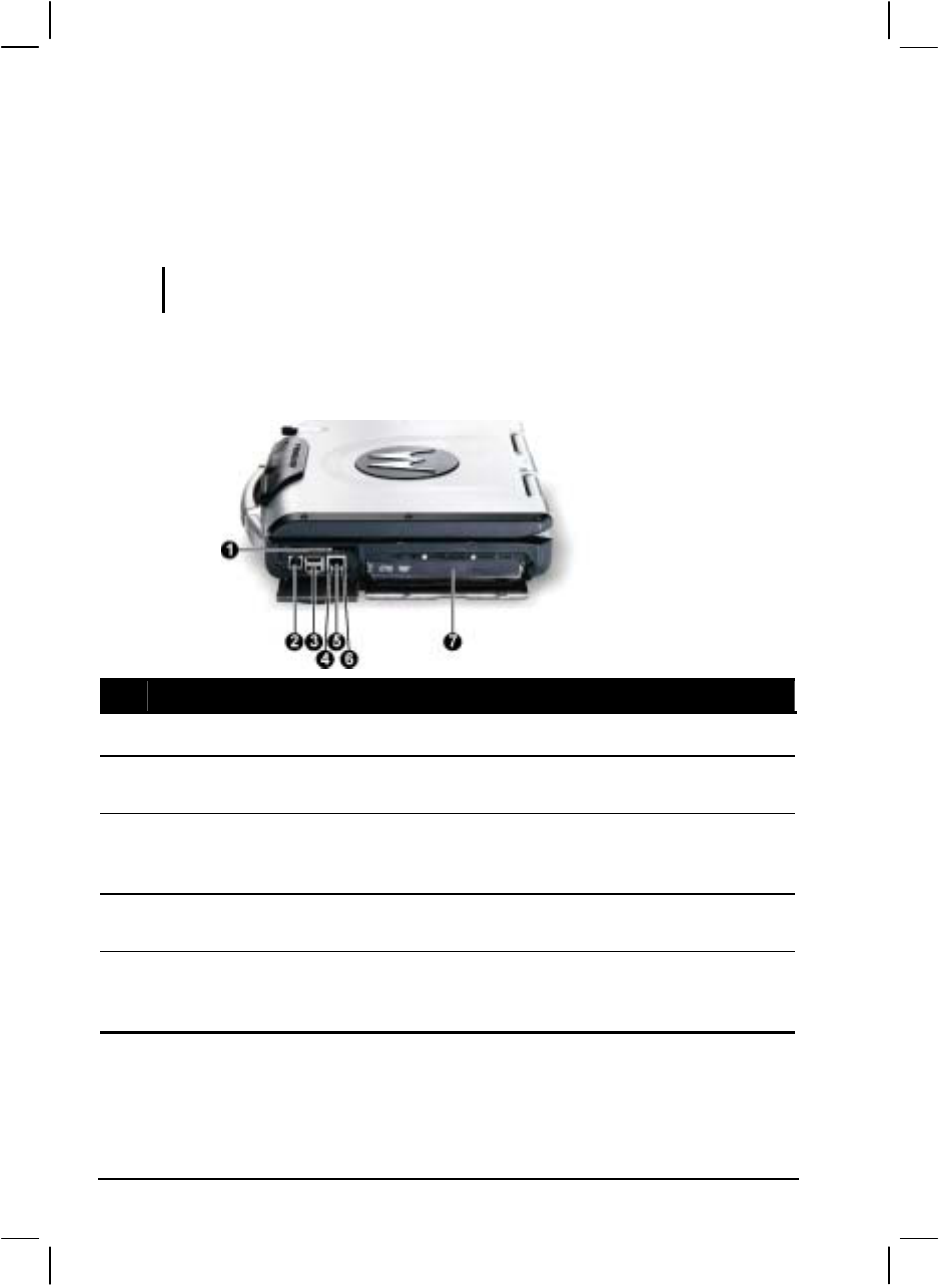
1-6 Getting Started
Taking a Look at the Computer
This section identifies the external components of the computer and
briefly describes the function of each component.
NOTE: Depending on the model you purchased, the appearance of your computer may
not exactly be the same as those shown in this manual.
Right-Side Components
Ref Component Description See Also
PC Card Slot Accepts a PC card for additional functions. P. 4-5
RJ-11
Connector Connects the telephone line. P. 2-19
USB Ports Each of the two ports connects a USB device,
such as a USB floppy drive, printer, digital
camera, joystick, and more.
P. 4-3
RJ-45
Connector Connects the LAN cable. Includes a Link
Indicator and an Active Indicator. P. 2-21
DVD/Combo/
DVD Dual
Drive
Accepts a compact disc (CD) for installing or
loading software, accessing data, and playing
music/video.
P. 2-14
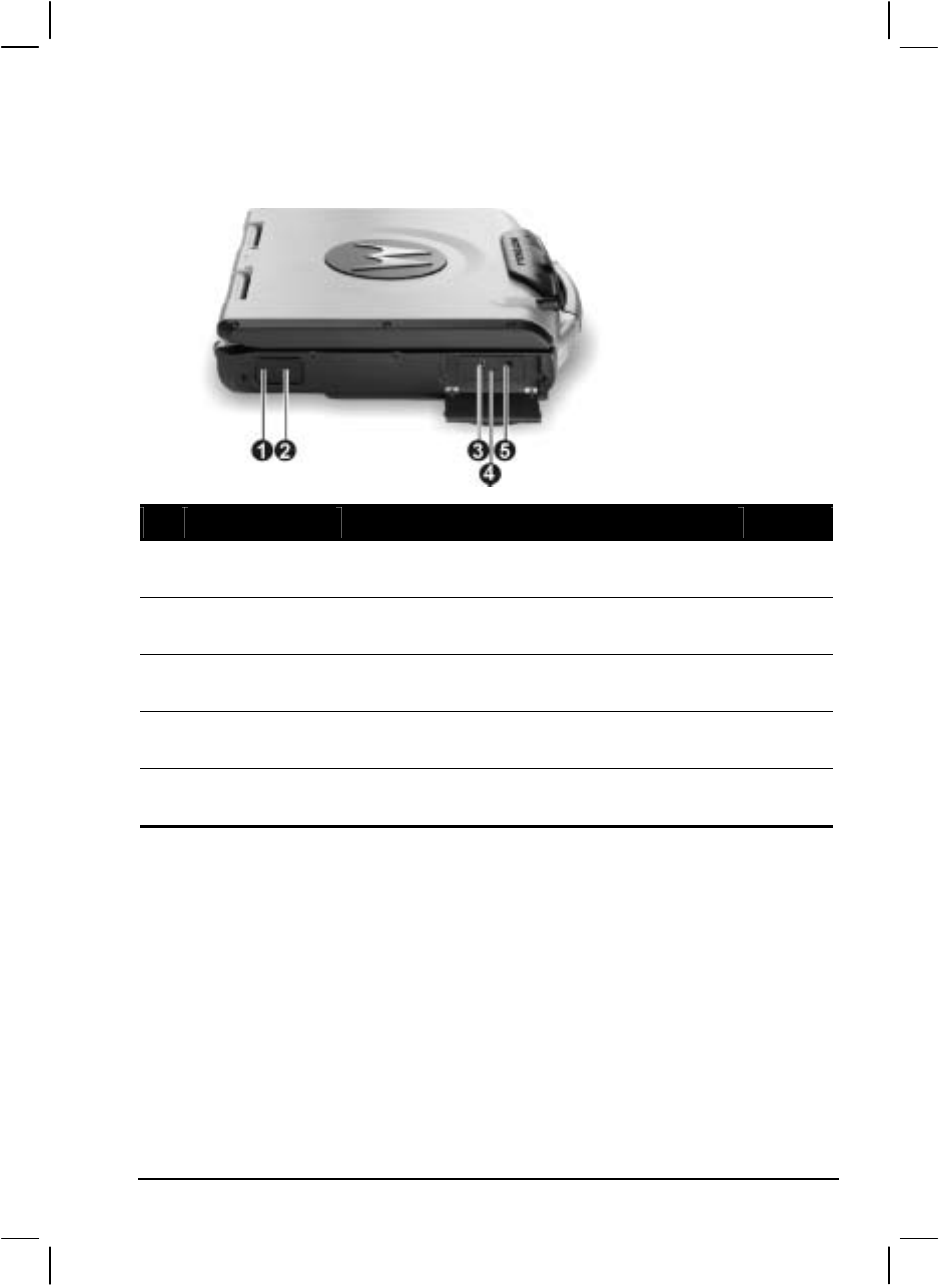
Getting Started 1-7
Left-Side Components
Ref Component Description See Also
IR Port Connects an IrDA-compliant device for wireless
data transfer. P. 4-5
Bluetooth
Antenna Serves as the antenna for the Bluetooth.
Microphone
Connector Connects an external microphone. P. 2-20
Keyboard BIOS
Reset Switch Use this to turn off the system when resetting the
system using Ctrl+Alt+Del does not work. P. 8-17
Audio Output
Connector Connects a set of headphones, external speakers
with amplifier, or an audio recording device. P. 2-20
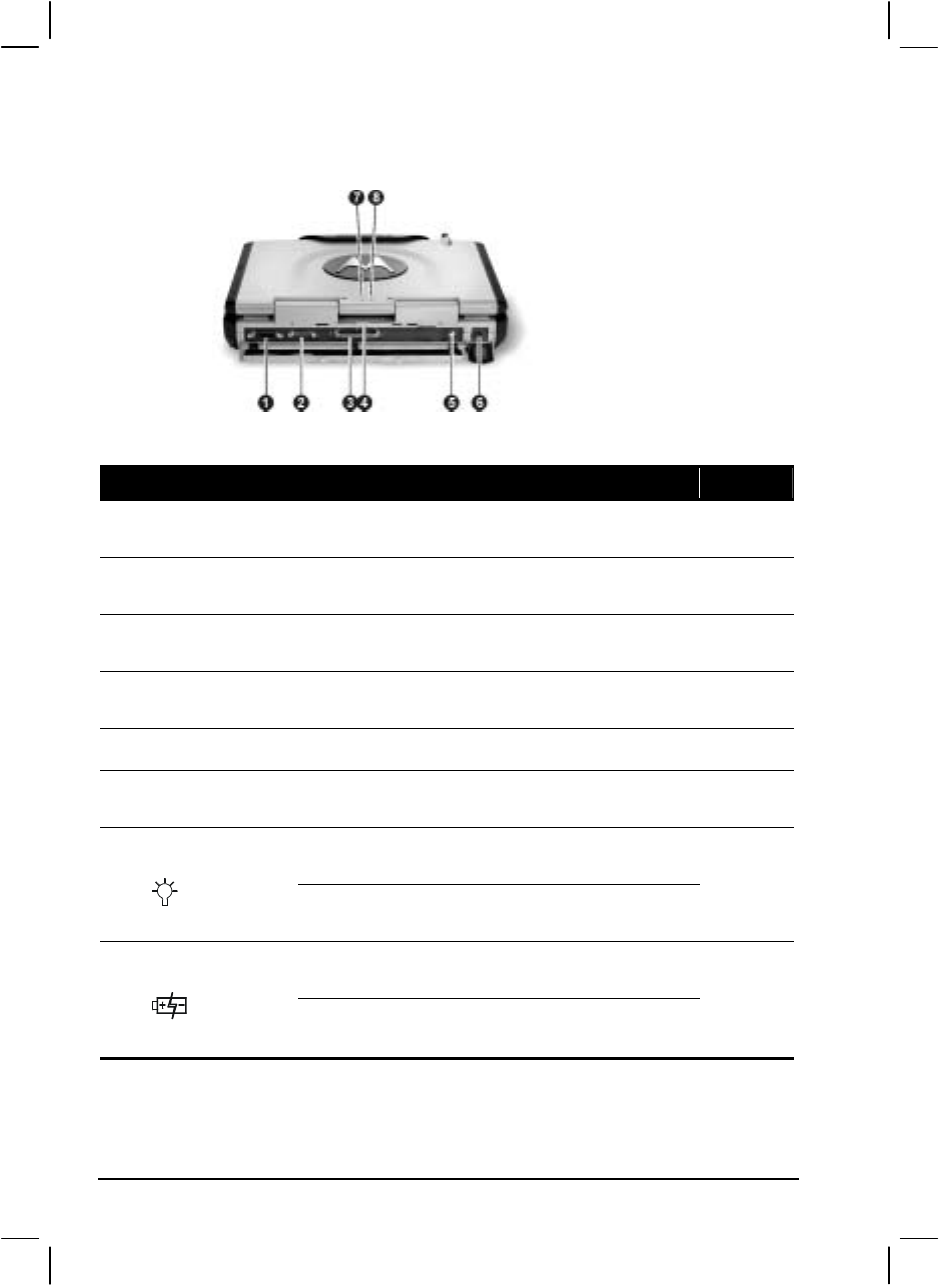
1-8 Getting Started
Rear Components
Ref Component Description See Also
DVI-I Port Connects an external monitor with a DVI
interface. P. 4-2
Serial Port Connects a serial device, such as an external
modem. P. 4-4
Docking Port For connecting to a Port Replicator / car mount
(both are available as an option).
Rear Cover
Latch Locks the rear cover.
AV Input Port Connects to a video recording device. P. 4-8
Power
Connector Connects the AC adapter. P. 1-3
Glows green when the computer is using AC
power.
AC Power
Indicator
Blinks amber (orange) when the computer, using
AC power, is in Standby mode.
P. 1-4
Glows green when the battery is fully charged
and connected to AC power.
Battery Charge
Indicator
Glows amber (orange) when the battery is being
charged.
P. 3-3
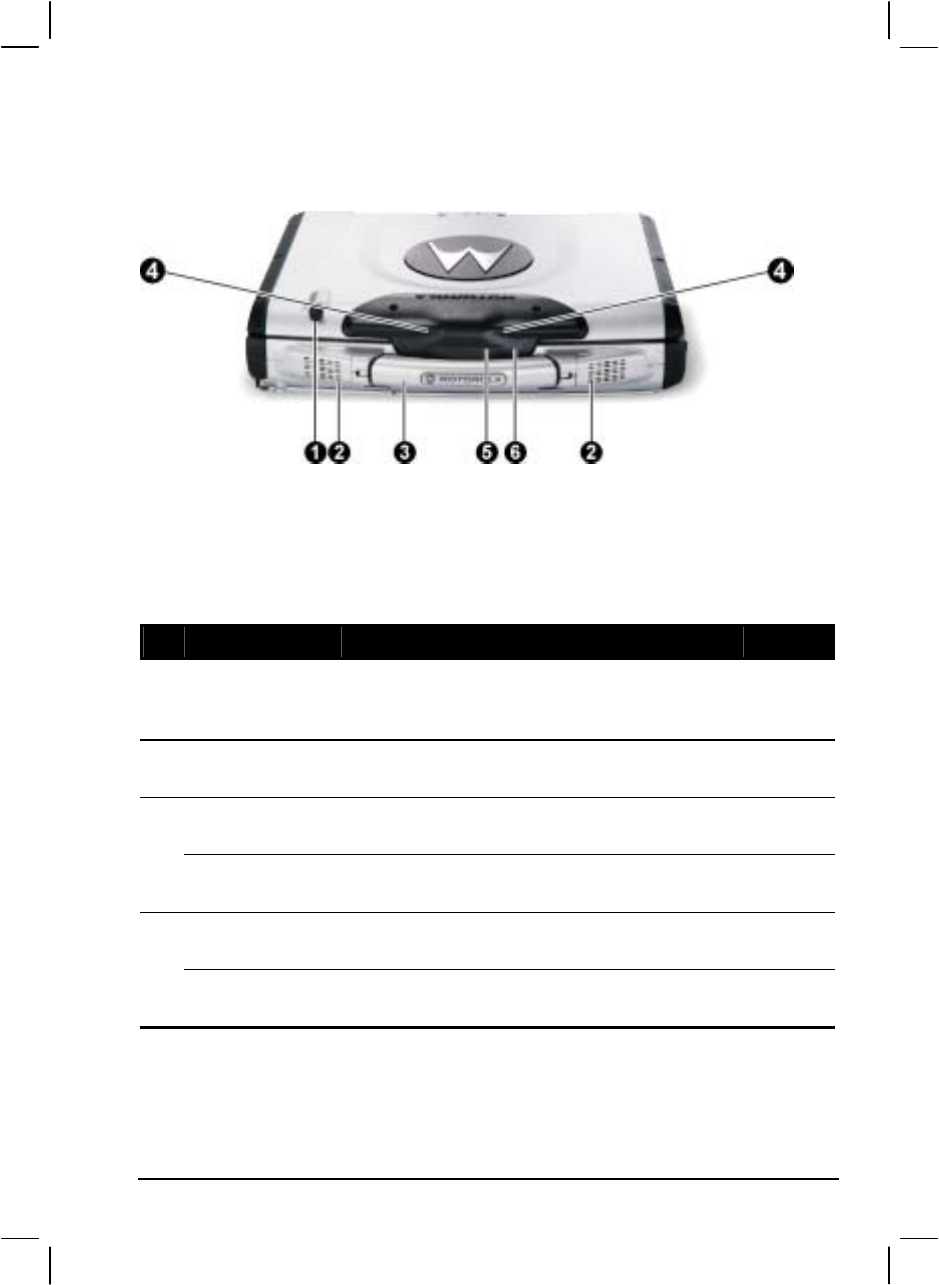
Getting Started 1-9
Front Components
Ref Component Description See Also
Wireless
Modem
Antenna
Serves as the antenna for the optional wireless
modem (RDLAP, GPRS, iDEN, and CDMA). P. 2-23
Stereo Speaker
Set Sends out sound and voice from the computer. P. 2-20
Handle Allows you to carry your computer for an easy
grip.
Wireless LAN
Antenna Serves as the antenna for the WLAN. It is
built-in the handle. P. 2-22
GPS Antenna
(option) Serves as the antenna for the Global Positioning
System (GPS). It is built-in the top cover latch. P. 2-24
Top Cover
Latch Locks the top cover. P. 1-4
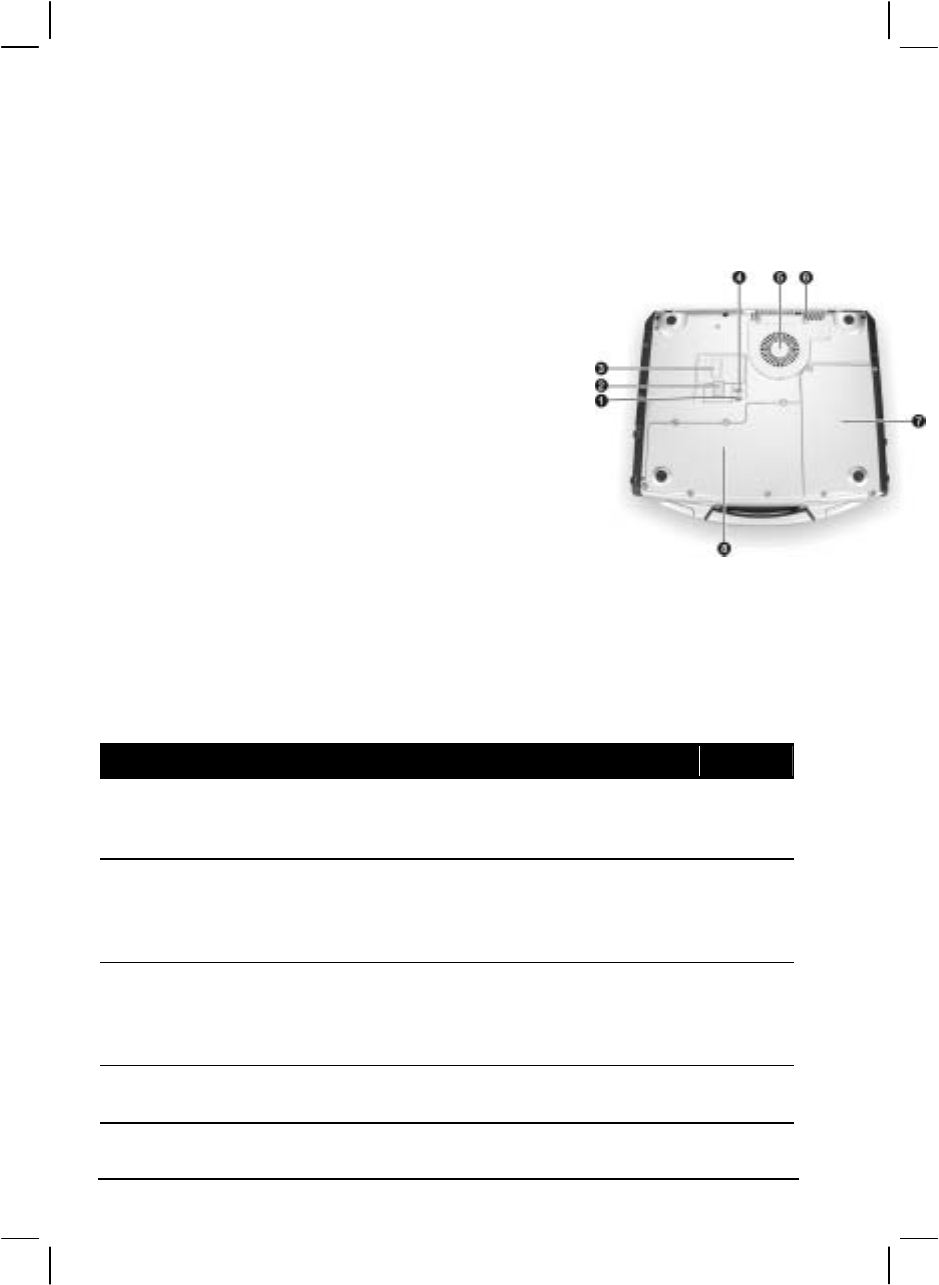
1-10 Getting Started
Bottom-Side Components
Ref Component Description See Also
X-bay Module
Antenna
Connector
Serves as the interface between the system and
antenna of the optional X-bay module.
DVD/Combo/
DVD Dual
Drive Lock/
Unlock Switch
Allows you to lock the DVD/Combo/DVD Dual
drive in place. P. 2-15
DVD/Combo/
DVD Dual
Drive Eject
Latch
Allows you to remove the DVD/Combo/DVD
Dual drive. P. 2-15
GPS Antenna
Connector Serves as the interface between the system and
external GPS antenna. P. 2-24

Getting Started 1-11
Ref Component Description See Also
CPU Socket and
Sealed CPU
Cooling Fan
Inside is the CPU of your computer and cooling
fan to protect it from overheating.
Ventilation
Openings Do not cover or block the ventilation openings
for air circulation thus preventing overheating.
Battery Pack Supplies power to your computer when external
power is not connected. P. 3-3
X-bay Interface
(top right) Connects additional wireless modem (GPRS/
GSM or iDEN).
Hard Disk
Drive
Compartment
(top left)
Contains the hard disk drive of your computer. P. 2-13
Memory Slot
(bottom left) Contains the memory slot for expanding the
memory size of your computer. P. 4-9
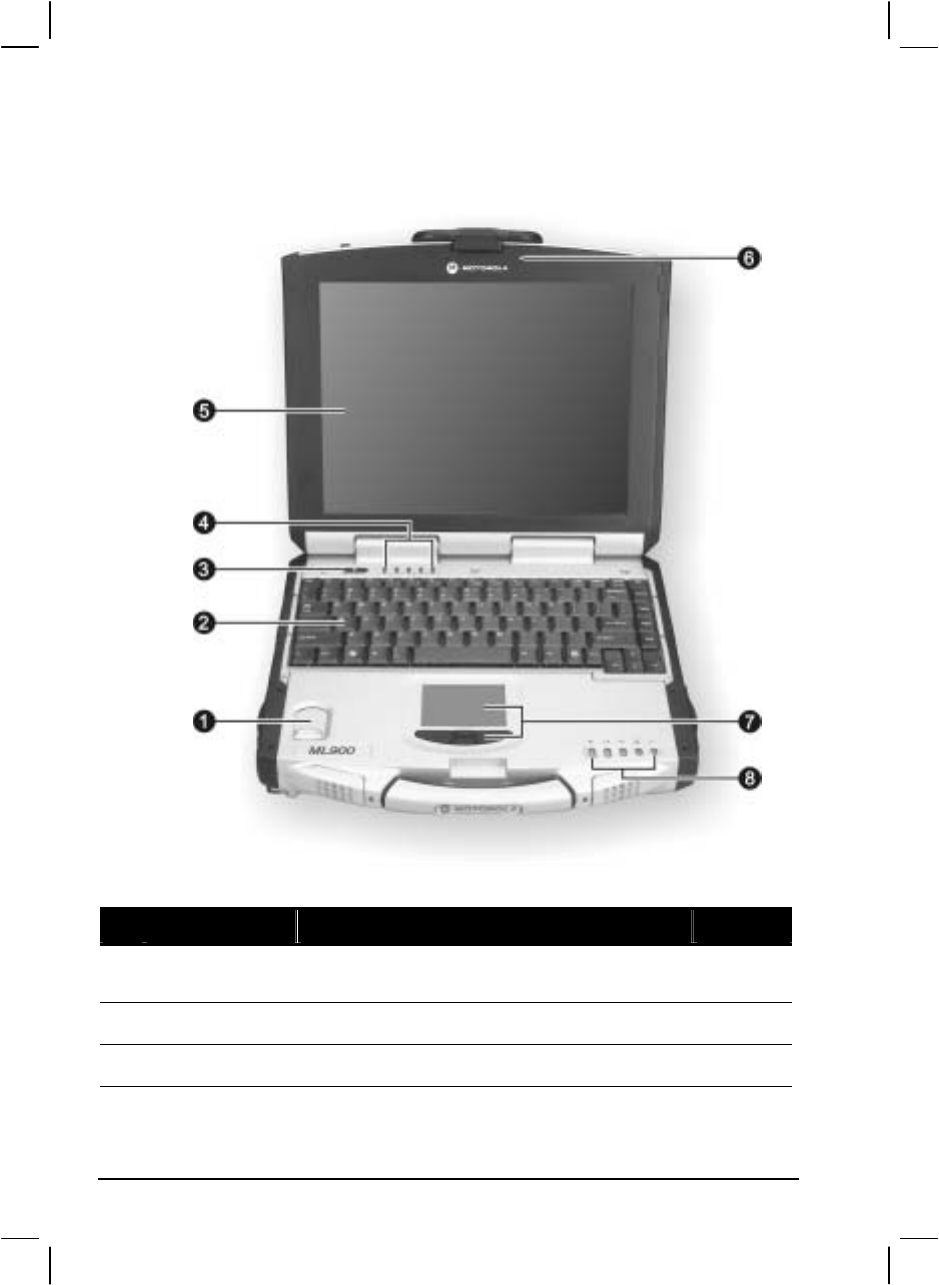
1-12 Getting Started
Top-open Components
Ref Component Description See Also
Fingerprint
Scanner Contains the fingerprint sensor. P. B-1
Keyboard Serves as the data input device of the computer. P. 2-4
Power Button Turns the computer power ON and OFF. P. 1-5

Getting Started 1-13
Ref Component Description See Also
Device
Indicators Show the current status of the computer’s
devices.
Power on / Standby mode indicator P. 1-3
Hard disk drive in-use indicator P. 2-13
Num Lock indicator P. 2-6
Caps Lock indicator P. 2-4
Scroll Lock indicator P. 2-4
LCD Screen Displays the output of the computer. P. 2-17
Light Sensor Automatic light sensor for dimming the
display’s backlight. Will function only if your
system comes with the optional sunlight
readable transflective LCD display and/or
keyboard with optional backlight function.
P. 2-17
Touchpad Serves as the pointing device of the computer. P. 2-9
Device
Indicators Show the current status of the computer’s
devices.
DVD/Combo/DVD Dual drive in-use indicator P. 2-14
Battery power indicator –
Glows green when the computer is using battery
power.
Blinks green when the computer, using battery
power, is in Standby mode.
Blinks amber (orange) when the battery is
almost completely discharged.
P. 3-3
Battery charge indicator –
Glows green when the battery is fully charged
and connected to AC power.
Glows amber (orange) when the battery is being
charged.
P. 3-3
Touchpad indicator –
Glows red when the touchpad is disabled. Can
be enabled/disabled using the hot keys Fn+F7.
P. 2-9

1-14 Getting Started
Ref Component Description See Also
AC in and HDD heater on indicator –
Glows green when the computer is connected to
AC power.
Blinks red when the hard disk heater is on.
P. 1-4
P. 2-13

Getting Started 1-15
Where to Go from Here
As your computer is ready for operation, you may want to do any of the
following now:
For this purpose… Do this…
To know more about the computer… Go on to the next chapter.
To install the operating system if your
dealer has not already done so… See the operating system manual.
To know more about the operating
system… Read the operating system manual.
To install the drivers if your dealer has
not already done so… See Chapter 6.
To set a power-on password… See “Security Menu” in Chapter 5.
To charge the battery pack for the first
time… See “Charging the Battery Pack” in
Chapter 3.

CHAPTER 2
Operating Your Computer
This chapter provides information about the use of the computer.
If you are new to computers, reading this chapter will help you learn the
operating basics. If you are already a computer user but are new to
notebook computers, you may choose to read only the parts containing
information unique to your computer.
Described in this chapter are the operating basics of these components:
Keyboard
Touchpad
Touchscreen
Hard disk drive
DVD/Combo/DVD Dual drive
And these features:
Starting and stopping the computer
Video features
Audio features
Communication features

2-2 Operating Your Computer
Starting and Stopping the Computer
There are a number of ways to start and stop the computer.
Starting the Computer
You always start the computer using the power button.
A computer starts up with an operating system (OS) existing on the
storage device such as the hard disk; or from a CD if you have the
respective modules installed. The computer will automatically load the
OS after you turn it on. This process is called booting.
NOTE: An operating system is the platform for all your software application programs to
run on. The most widely used operating system today is Microsoft Windows.
Stopping the Computer
When you finish a working session, you can stop the computer by turning
off the power or leaving the computer in Standby or Hibernation mode:
To stop in
this mode… Do this… To start up or
resume again
Off Follow the shutdown procedure of your
operating system. This can prevent loss of
unsaved data or damage to your software
programs.
If the system is locked up because of
hardware or software problems, press the
power button to turn off the computer.
Press the power
button.
Standby Depending on your settings in Windows,
you can place the computer in Standby
mode by:
• Closing the display cover
• Pressing the power button
Press any key.

Operating Your Computer 2-3
To stop in
this mode… Do this… To start up or
resume again
Hibernation Depending on your settings in Windows,
you can place the computer in
Hibernation mode by:
• Closing the display cover.
• Pressing the power button
Press the power
button.
If you choose to stop in Standby or Hibernation mode, you can return to
where you left off the next time you start up the computer. (See “Power
Management” in Chapter 3 for more information.)

2-4 Operating Your Computer
Using the Keyboard
Your keyboard has all the standard functions of a full-sized computer
keyboard plus a Fn key added for specific functions.
The standard functions of the keyboard can be further divided into four
major categories:
Typewriter keys
Cursor-control keys
Numeric keys
Function keys
Typewriter Keys
Typewriter keys are similar to the keys on a typewriter. Several keys are
added such as the Ctrl, Alt, Esc, and lock keys for special purposes. When
the lock keys (Caps Lock, Num Lk, and Scroll Lk) are pressed, their
corresponding indicators light up.
The Control key is normally used in combination with other keys for
program-specific functions. The Alternate key is normally used in
combination with other keys for program-specific functions. The Escape
key is usually used for stopping a process. Examples are exiting a
program and canceling a command. The function depends on the program
you are using.
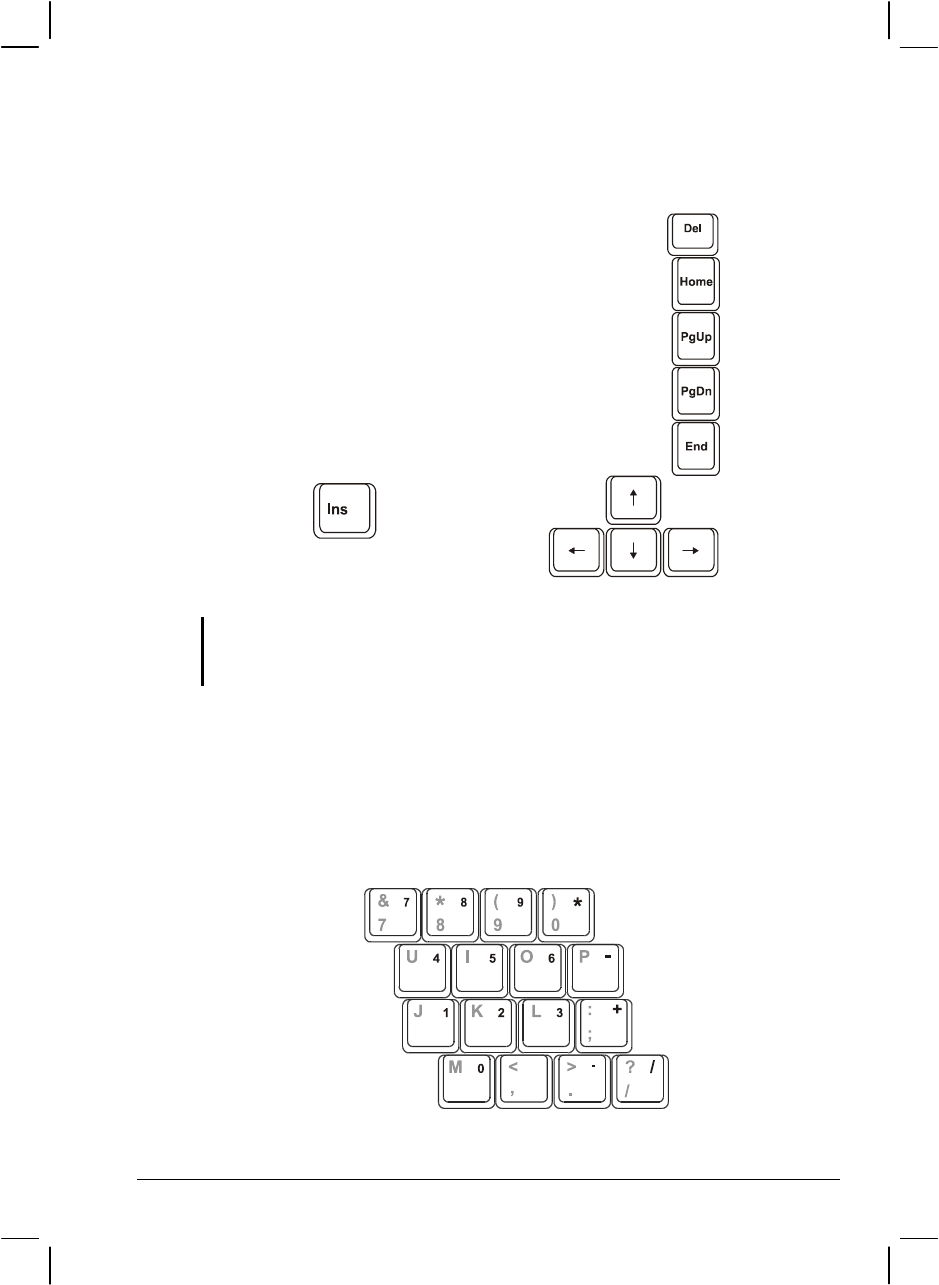
Operating Your Computer 2-5
Cursor-Control Keys
NOTE: The word “cursor” refers to the indicator on the screen that lets you know
exactly where on your screen anything you type will appear. It can take the form of a
vertical or horizontal line, a block, or one of many other shapes.
Numeric Keypad
A 15-key numeric keypad is embedded in the typewriter keys as shown
next:
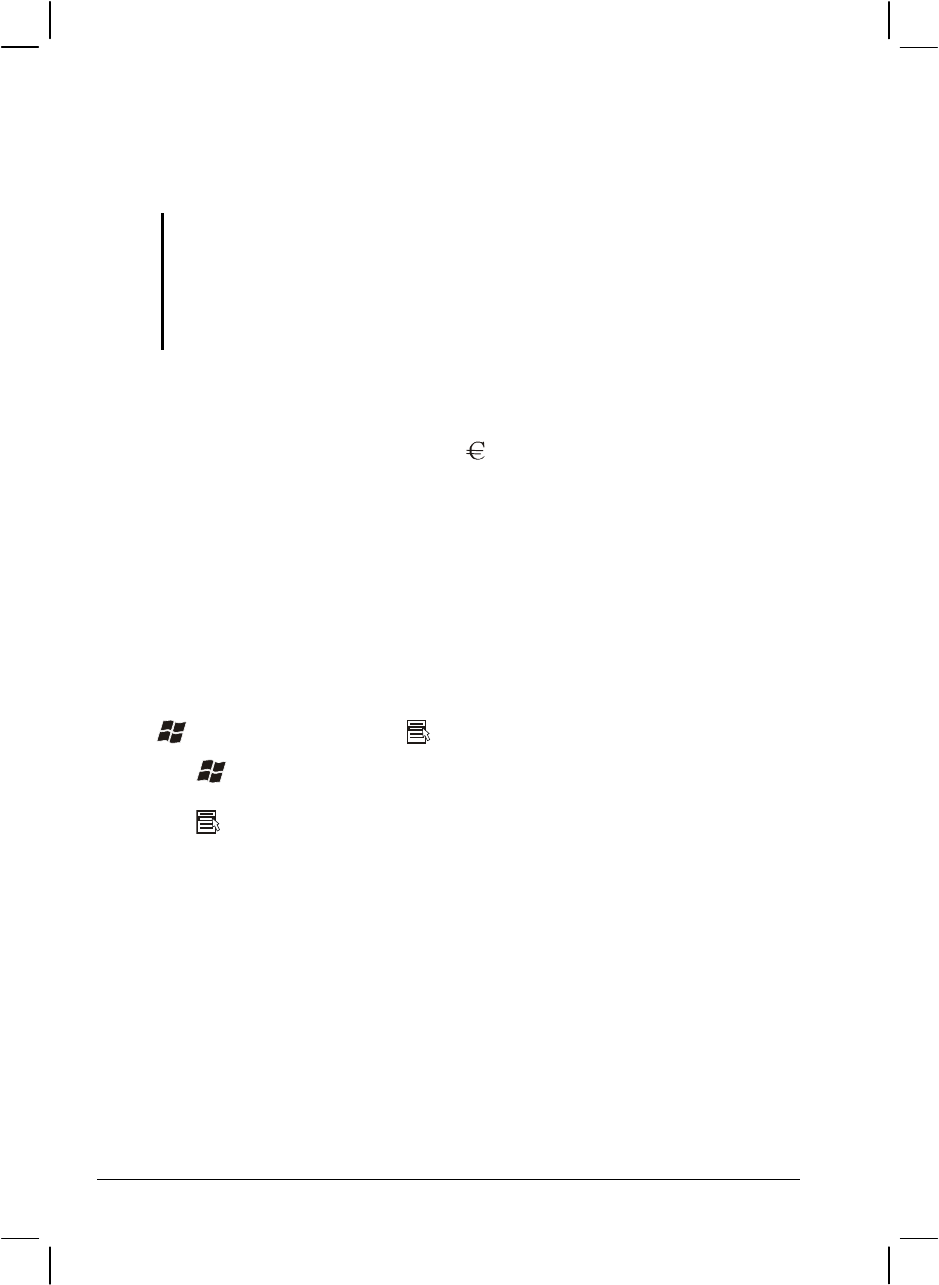
2-6 Operating Your Computer
Numeric keys facilitate entering of numbers and calculations. When Num
Lock is on, the numeric keys are activated; meaning you can use these
keys to enter numerals.
NOTES:
When the numeric keypad is activated and you need to type the English letter in the
keypad area, you can turn Num Lock off or you can press Fn and then the letter
without turning Num Lock off.
Some software may not be able to use the numeric keypad on the computer. If so,
use the numeric keypad on an external keyboard instead.
Euro Symbol
You can press the Euro dollar sign on the keyboard.
To press the Euro sign on the keyboard, hold down either of the Alt
keys and type 0128 on the numeric keypad of your keyboard.
To press the Euro sign on an UK keyboard, hold down the Alt Gr key
and press 4 (which has an Euro sign on it).
Windows Keys
The keyboard has two keys that perform Windows-specific functions:
Windows Logo key and Application key.
The Windows Logo key opens the Start menu and performs
software-specific functions when used in combination with other keys.
The Application key usually has the same effect as a right mouse
click. (See your Windows manual for more information.)
Function Keys
On the top row of the keys are the function keys: F1 to F12. Function keys
are multi-purpose keys that perform functions defined by individual
programs.
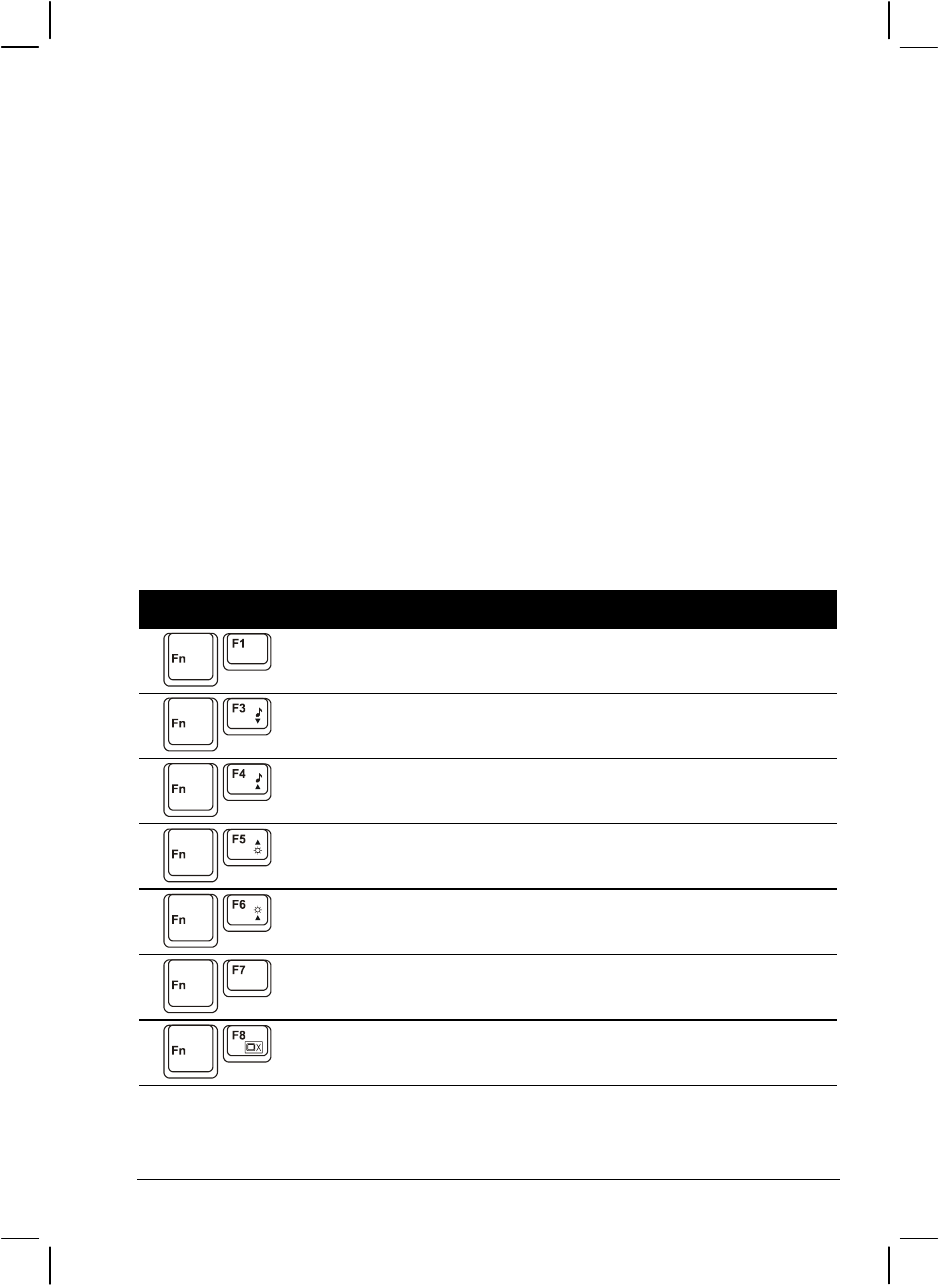
Operating Your Computer 2-7
Fn Key
The Fn key, at the lower left corner of the keyboard, is used with another
key to perform the alternative function of a key. The letter “Fn” and the
alternative functions are identified by the color of blue on the keytop. To
perform a desired function, first press and hold Fn, then press the other
key.
Hot Keys
Hot keys refer to a combination of keys that can be pressed any time to
activate special functions of the computer. Most hot keys operate in a
cyclic way. Each time a hot key combination is pressed, it shifts the
corresponding function to the other or next choice.
You can easily identify the hot keys with the icons imprinted on the
keytop. The hot keys are described next.
Key Description
Switches the optional keyboard backlight function on/off with
10 levels of brightness in-between.
Decreases the sound volume.
Increases the sound volume.
Decreases the LCD brightness.
Increases the LCD brightness.
Switches the touchpad on and off.
Switches LCD off and on.
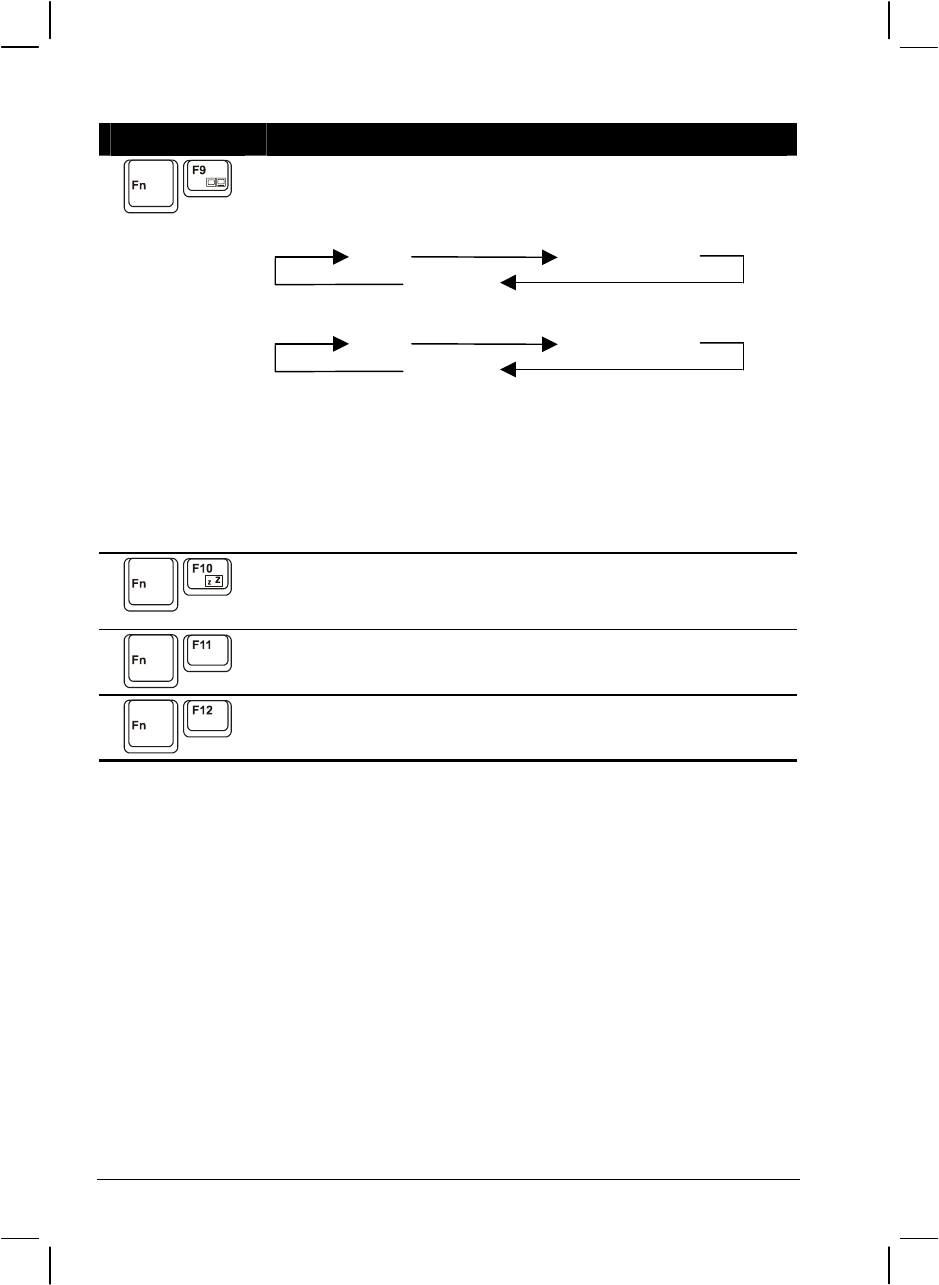
2-8 Operating Your Computer
Key Description
Switches the display output to one of the following when an
external device is connected.
Upon booting the system with CRT:
LCD LCD & CRT
CRT
Upon booting the system with DVI:
LCD LCD & DVI
DVI
NOTES:
When in full screen DOS mode, or when playing DVD or
MPEG file, display switching is not allowed.
If the display mode is set to 256 colors or lower, or in DOS
mode, there will be only two modes for selecting: CRT only
and LCD & CRT.
This function only applies to Plug & Play CRT monitors.
Serves as the sleep button that you can define with Windows’
Power Management. (See the “Power Management” in
Chapter 3.)
Switches the LCD backlight on and off.
Switches the optional GPS function on and off.
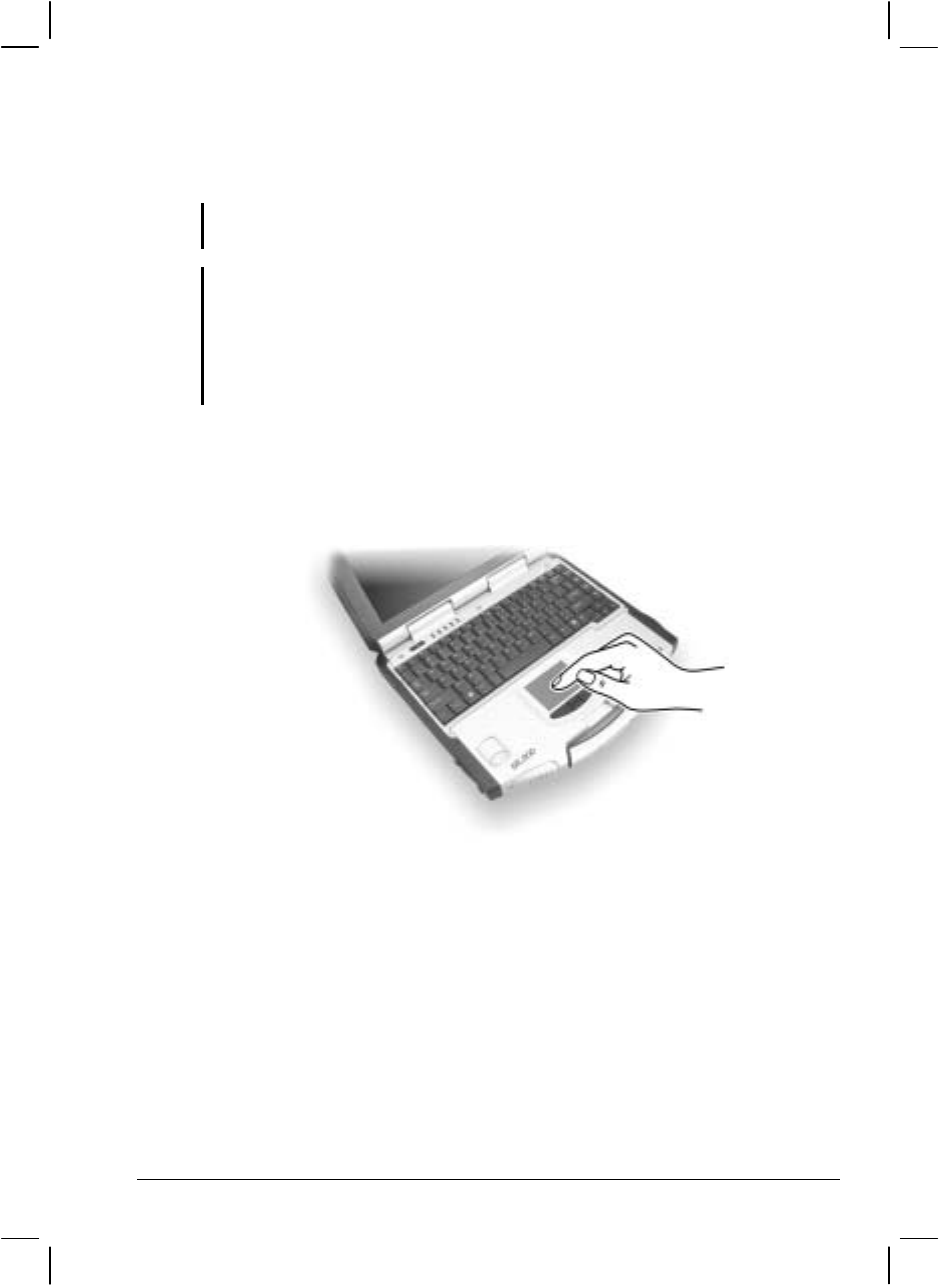
Operating Your Computer 2-9
Using the Touchpad
CAUTION: Do not use a sharp object such as a pen on the touchpad. Doing so may
damage the touchpad surface.
NOTES:
By default, the touchpad is disabled. Use the Fn+F7 hot keys to enable/disable this
function. The touchpad indicator found on the keyboard panel glows red when it is
disabled.
For optimal performance of the touchpad, keep your fingers and the pads clean and
dry. When tapping on the pad, tap lightly. Do not use excessive force.
The touchpad is a pointing device that allows you to communicate with
the computer by controlling the location of the pointer on the screen and
making selection with the buttons.
The touchpad consists of a rectangular pad and four buttons. To use the
touchpad, place your forefinger or thumb on the pad. The rectangular pad
acts like a miniature duplicate of your display. As you slide your fingertip
across the pad, the pointer (also called cursor) on the screen moves
accordingly. When your finger reaches the edge of the pad, simply
relocate yourself by lifting the finger and placing it on the other side of
the pad.
Here are some common terms that you should know when using the
touchpad:

2-10 Operating Your Computer
Term Action
Point Move your finger on the pad until the cursor points to the
selection on the screen.
Click Press and release the left button.
–or–
Tap gently anywhere on the pad.
Double-
click Press and release the left button twice in quick succession.
–or–
Tap twice on the pad rapidly.
Drag
and
drop
Press and hold the left button, then move your finger until you
reach your destination (drag). Finally, release the button (drop)
when you finish dragging your selection to the destination. The
object will drop into the new location.
–or–
Gently tap twice on the pad and on the second tap, keep your
finger in contact with the pad. Then, move your finger across the
pad to drag the selected object to your destination. When you lift
your finger from the pad, the selected object will drop into place.
Scroll To scroll is to move up and down or left and right in the working
area on the screen.
The scroll button located between the two buttons under the
touchpad can be used to move vertically in a convenient way.
Press the upper part of the scroll button to move up and the lower
part of the scroll button to move down.
–or–
To move vertically, place your finger on the right edge of the
pad and slide your finger up and down along the edge. To move
horizontally, place your finger on the bottom edge of the pad and
slide your finger left and right.
This function works only after you install the touchpad driver
supplied with the computer and it may not work for all
applications.
TABLE NOTE: If you swap the left and right buttons, “tapping” on the touchpad
as an alternative method of pressing the left button will no longer be valid.

Operating Your Computer 2-11
Configuring the Touchpad
You may want to configure the touchpad to suit your needs. For example,
if you are a left-handed user, you can swap the two buttons so that you
can use the right button as the left button and vise versa. You can also
change the size of the on-screen pointer, the speed of the pointer, and so
on.
To configure the touchpad, you can use the standard Microsoft or IBM
PS/2 driver if you are using Windows. However, you can install the
touchpad driver supplied with your computer to take advantage of more
powerful features. (For information on installing the driver, see “How to
Use the Driver CD” in Chapter 6.)

2-12 Operating Your Computer
Using the Touchscreen (option)
CAUTION: Do not use a sharp object such as a ballpoint pen or pencil on the
touchscreen. Doing so may damage the touchscreen surface.
The touchscreen is a touch-sensitive device that allows you to
communicate with the computer by controlling the location of the pointer
on the screen and making selection with the buttons.
The touchscreen needs a special device driver support that allows you to
easily use the computer without a mouse or touchpad.
Here are some common terms that you should know when using the
touchscreen:
Term Action
Click/Point Tap gently on the touchscreen.
Double-click Tap twice on the touchscreen rapidly.
Drag and
drop Press lightly on the touchscreen and move your finger
until you reach your destination (drag). Finally, release
your finger (drop) when you finish dragging your selection
to the destination. The object will drop into the new
location.
Scroll To scroll is to move up and down or left and right in the
working area on the screen.
To move vertically, place your finger on the right edge of
the touchscreen and slide your finger up and down along
the edge. To move horizontally, place your finger on the
bottom edge of the touchscreen and slide your finger left
and right.
This function works only after you install the touchscreen
driver supplied with the computer and it may not work for
all applications.
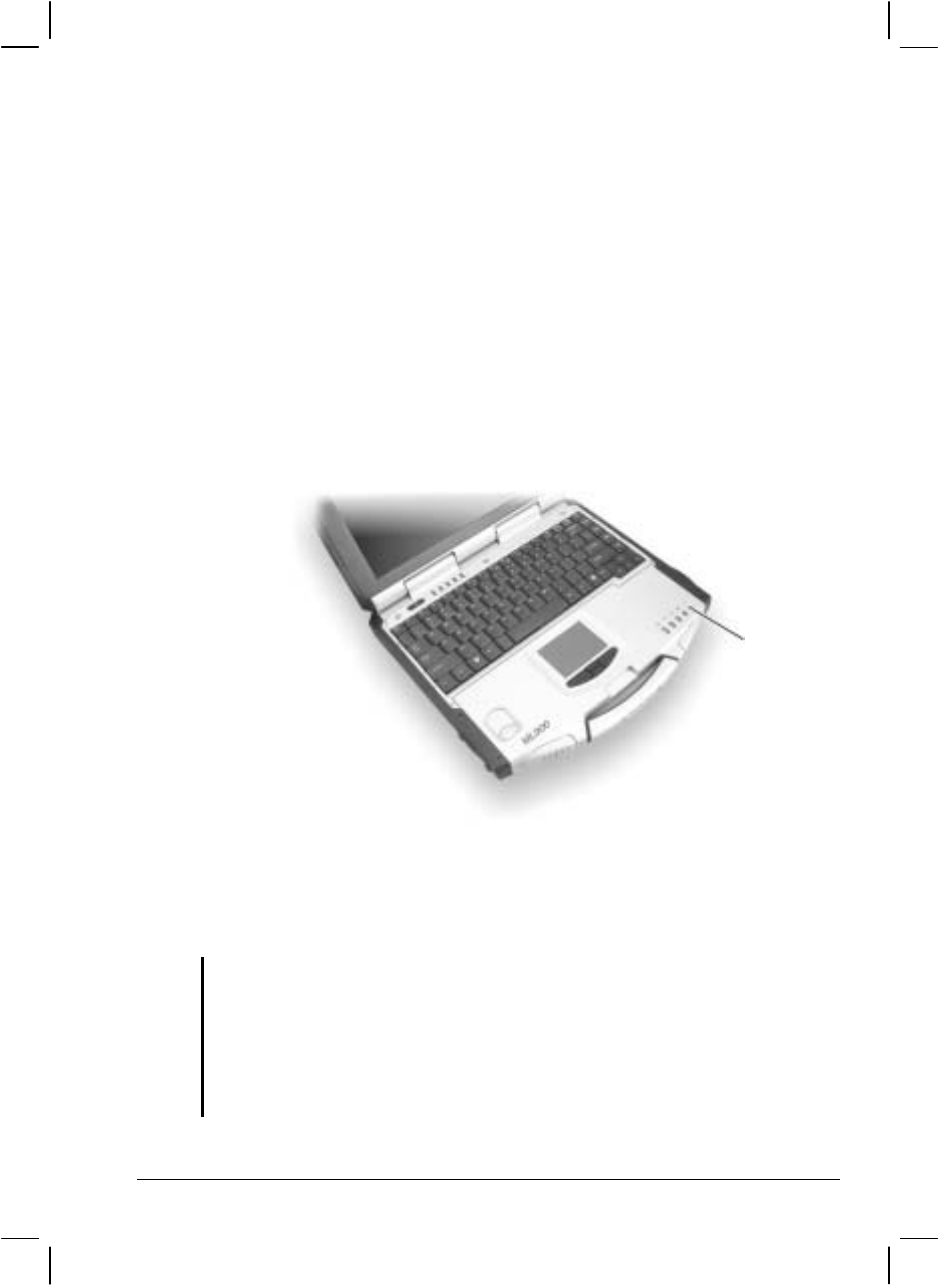
Operating Your Computer 2-13
Using the Hard Disk Drive
Your computer comes with a hard disk drive as drive C. A hard disk drive
is a storage device with non-removable, rotating, magnetic storage
platters inside it. It is where your operating system and application
software programs are stored.
Your hard disk drive is a 2.5-inch IDE (Integrated Drive Electronics) hard
disk drive. This type of drive embodies the latest in fast, reliable mass
storage by integrating all the control circuitry necessary for operation
directly onto the drive itself. This allows the drive manufacturer to
carefully optimize drive performance.
The system comes with a built-in heater that automatically turns on for
low temperature operation. The AC in / HDD heater on indicator blinks
red when heater is on.
CAUTION:
Make regular backups of your data files from your hard disk drive to CD discs or
other storage media.
Never try to remove or install the hard disk drive while the computer is powered on.
Doing so can result in loss of data, and can damage the computer and the hard disk
drive’s sensitive circuitry.
Never turn off or reset the computer while the hard disk drive in-use indicator is on.
A
C in /
HDD heater on
indicator

2-14 Operating Your Computer
Using the DVD/Combo/DVD Dual Drive
Depending on the model, your computer comes with a DVD, Combo, or
DVD Dual drive located on the right side of the computer. This drive is
usually configured as drive D.
The drive uses removable 5.25-inch silver discs, which look like standard
music CDs. It is an ideal medium to use for distributing multimedia
because of the huge amount of data that a disc can store.
Depending on the model, your drive is one of the following:
DVD drive can read DVD (Digital Versatile Disc) discs in addition
to CDs, audio CDs, CD-R, and CD-RW discs.
Combo drive can work both as a DVD drive and CD-RW drive.
DVD Dual drive aside from working as a Combo drive, can also
write to DVD-R, DVD-RW, DVD+R, DVD+RW discs.
NOTE: If the DVD/Combo/DVD Dual drive would be operating for more than half an
hour (such as showing a DVD title), use the AC power source instead of the battery. If
not, the battery may run out of power before the operation is complete.
CAUTION:
1. When inserting a disc, do not use force.
2. Make sure the disc is correctly inserted into the tray, and then close the tray.
3. Do not leave the DVD tray open. Also, avoid touching the lens in the tray with your
hand. If the lens becomes dirty, the drive may malfunction.
4. Do not wipe the lens using materials with rough surface (such as paper towel).
Instead, use a cotton swab to gently wipe the lens.
FDA regulations require the following statement for all laser-based devices:
“Caution, Use of controls or adjustments or performance of procedures other than
those specified herein may result in hazardous radiation exposure.”
NOTES:
This product incorporates copyright protection technology that is protected by
method claims of certain U.S. patents and other intellectual property rights owned
by Macrovision Corporation and other rights owners. Use of this copyright
protection technology must be authorized by Macrovision Corporation, and is
intended for home and other limited viewing uses only unless otherwise authorized
by Macrovision Corporation. Reverse engineering or disassembly is prohibited.
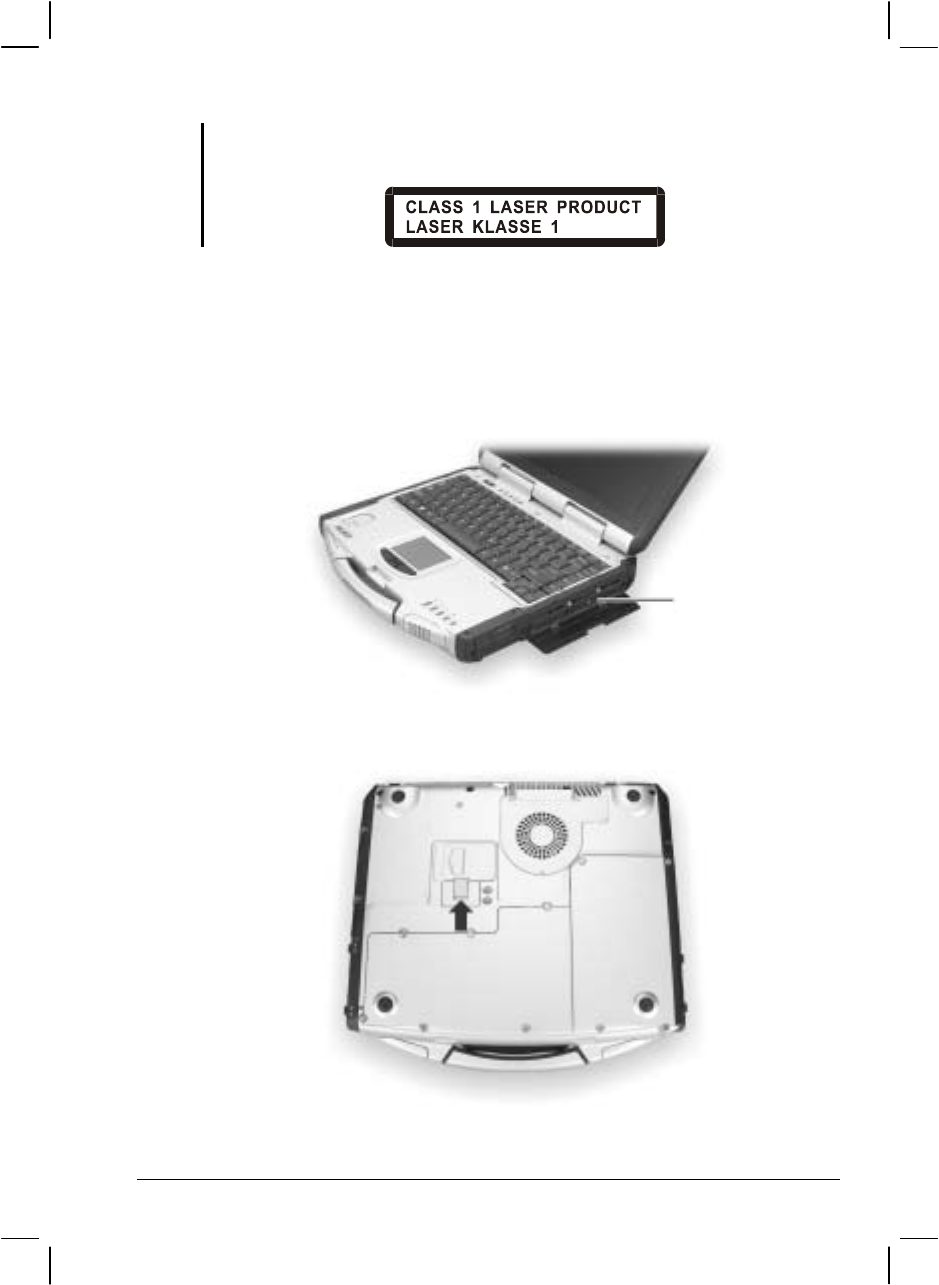
Operating Your Computer 2-15
The DVD/Combo/DVD Dual drive is classified as a Class 1 laser product. This label
is located on the DVD/Combo/DVD Dual drive.
Installing the DVD/Combo/DVD Dual Drive
To install the DVD/Combo/DVD Dual drive:
1. Insert the DVD/Combo/DVD Dual drive into the DVD drive bay
located on the right side of the computer.
2. Slide the DVD drive lock/unlock switch to the lock position to secure
the DVD/Combo/DVD Dual drive in place.
DVD drive
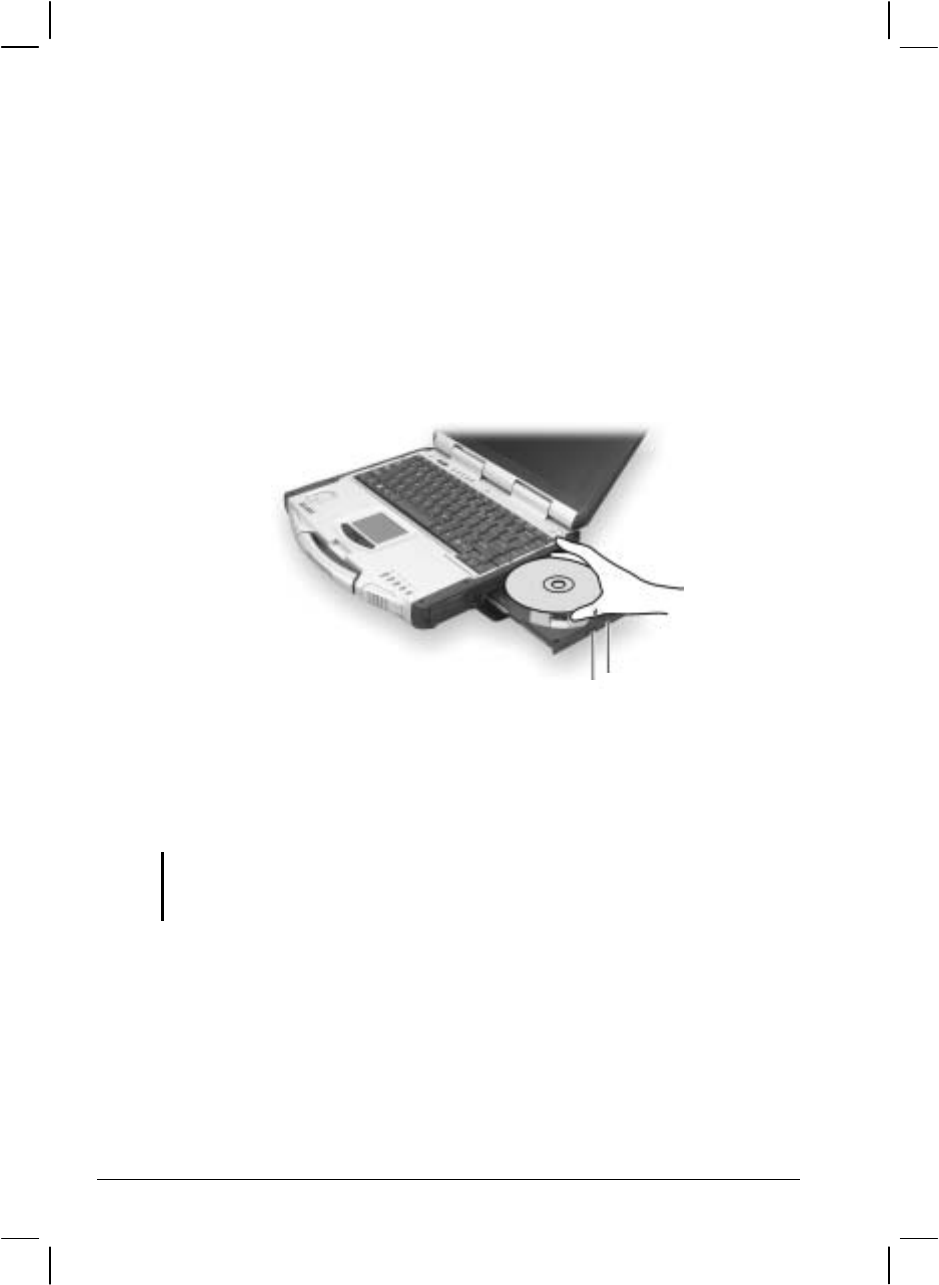
2-16 Operating Your Computer
Inserting and Removing a Disc
Follow this procedure to insert or remove a disc.
1. Turn on the computer.
2. Press the eject button and the DVD tray will slide out partially.
Gently pull on it until it is fully extended.
3. To insert a disc, place down the disc in the tray with its label facing
up. Slightly press the center of the tray until it clicks into place.
To remove a disc, hold the disc by its outer edge and lift it up from
the tray.
4. Gently push the tray back into the drive.
NOTE: In the unlikely event that you are unable to release the DVD tray by pressing the
eject button, you can manually release the DVD. (See “DVD/Combo/DVD Dual Drive
Problems” in Chapter 8.)
Eject button In-use
indicator

Operating Your Computer 2-17
Using the Video Features
The video subsystem of your computer features:
12.1-inch TFT (Thin-Film Transistor) color LCD display with
1024×768 XGA (eXtended Graphics Array) resolution
64 MB integrated video memory
Simultaneous display on LCD and external monitor, which is useful
when you have a presentation as you can control the screen from your
computer and face the audience at the same time.
Dual view capability, which allows you to expand your desktop on
the screen to another display device so that you have more desktop
space to work on.
Power Management.
Polarizer touchscreen function (option).
Transmissive and hi-contrast LCD display (option).
NOTES:
Before using the dual view capability, the video driver supplied with your computer
must be installed.
System enters Standby/Hibernation mode when the LCD is closed. If you want to
use the computer with the LCD closed, set Do Nothing to the “When I close the lid
of my portable computer” option in the Power Options Properties. Thus the
computer does not enter Standby or Hibernation mode when the LCD is closed.
Configuring the Display Modes
NOTE: To take advantage of the enhanced video capabilities, the video driver supplied
with your computer must be installed.
Your computer has been set to a default resolution and number of colors
before shipment. You can view and change display settings through your
operating system. See your operating system documentation or online
help for specific information.

2-18 Operating Your Computer
For displaying in higher resolutions, you can connect an external CRT
monitor that supports higher resolutions. (See “Connecting an External
Monitor” in Chapter 4 for more information.)
The following table lists the display modes supported by your computer.
Display Mode LCD Only CRT Only Simultaneous Display
Resolution Colors
16-bit √ √ √
800×600
32-bit √ √ √
16-bit √ √ √
1024×768
32-bit √ √ √
TABLE NOTES:
16-bit = High Color or 65,536 (64 K) colors; 32-bit = True Color 16,770,000 (16 M)
colors.
When using CRT only, the resolution would depend on the supported resolution by
the CRT.
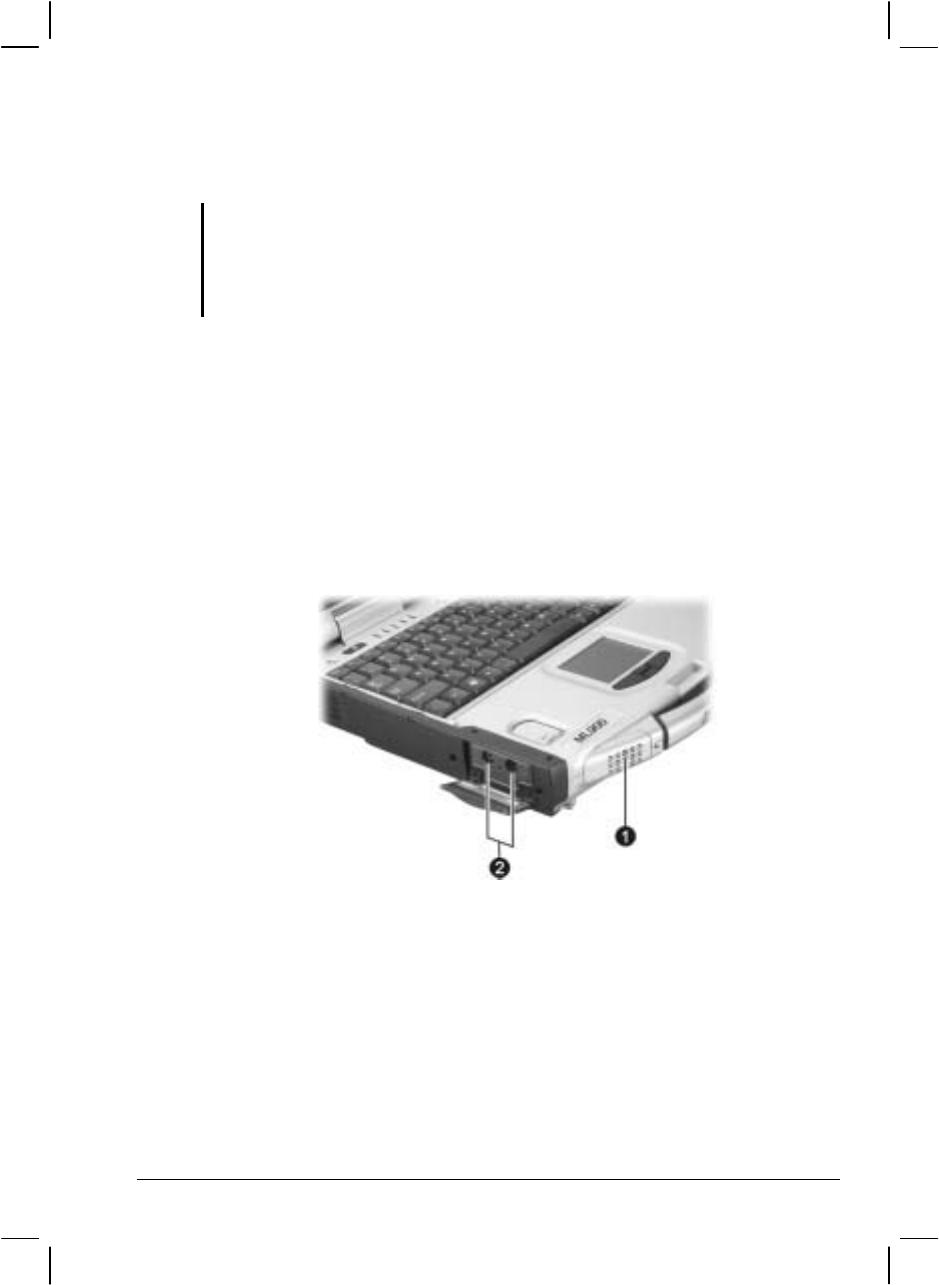
Operating Your Computer 2-19
Using the Audio Features
NOTES:
To take advantage of the enhanced audio capabilities, the audio driver supplied
with your computer must be installed (see chapter 6 for details).
If you experience interference while recording, try lowering the microphone
recording volume.
The audio subsystem of your computer features:
Digital audio and analog mixing functions required for recording and
playing sound on your computer
Microsoft Windows Sound System support
A set of speakers ()
External audio connectors ()
Ways of playing and recording sound vary with the operating system
used. See your operating system documentation or online help for
specific information.

2-20 Operating Your Computer
Connecting Audio Devices
For higher audio quality, you can send or receive sound through external
audio devices.
Microphone Connector ( ) can be connected to an external
microphone for recording voice or sound.
Audio Output Connector ( ) can be connected to the line-in
connector of powered speakers with built-in amplifiers, headphones,
or earphone set.
NOTE: When using external speakers/headphones or microphone, you cannot use the
internal one.

Operating Your Computer 2-21
Using the Communication Features
Using the LAN
NOTE for Windows 2000: To take advantage of the LAN feature, the LAN driver
supplied with your computer must be installed.
The internal 10/100Base-T Ethernet LAN (Local Area Network) module
allows you to connect your computer to a network. It supports data
transfer rate up to 100 Mbps.
To connect the network cable to the LAN module, connect one end of the
LAN cable to the RJ-45 connector on the computer and the other end to
the network hub.
Link Indicator Glows green when the system has an available
connection to LAN.
Active Indicator Blinks green when the system is accessing the LAN.
A
ctive
indicator
Lin
k
indicato
r

2-22 Operating Your Computer
Using the Wireless LAN (option)
Depending on your model, an internal Mini PCI wireless LAN (WLAN)
card may have been pre-installed by your computer manufacturer at the
factory. This card allows you to access corporate networks or the Internet
in a wireless environment.
The WLAN features include:
2.4 GHz DSSS (Direct Sequence Spread Spectrum) technology
Peer-to-Peer (Ad-Hoc) and Access Point (Infrastructure) modes
support
WEP (Wired Equivalent Privacy) 64/128-bit data encryption
Transmission rate at 9 / 18 / 36 / 54 Mbps (802.11g mode), with
automatic data rating at 1 / 2 / 11 Mbps (802.11b mode)
It takes approximately 30 seconds for your computer to make a successful
WLAN connection and approximately 10 seconds to disconnect.
NOTE: The FAA (Federal Aviation Agency) has deemed it unsafe to operate wireless
devices in aircraft as this may interfere with flight safety. Remember to select turn off
wireless LAN when using your computer in the airplane.
Connecting to a Wireless Network
1. Double-click the Wireless Network Connection icon located on
your Windows system tray. If any wireless network is detected, the
following window appears on screen.
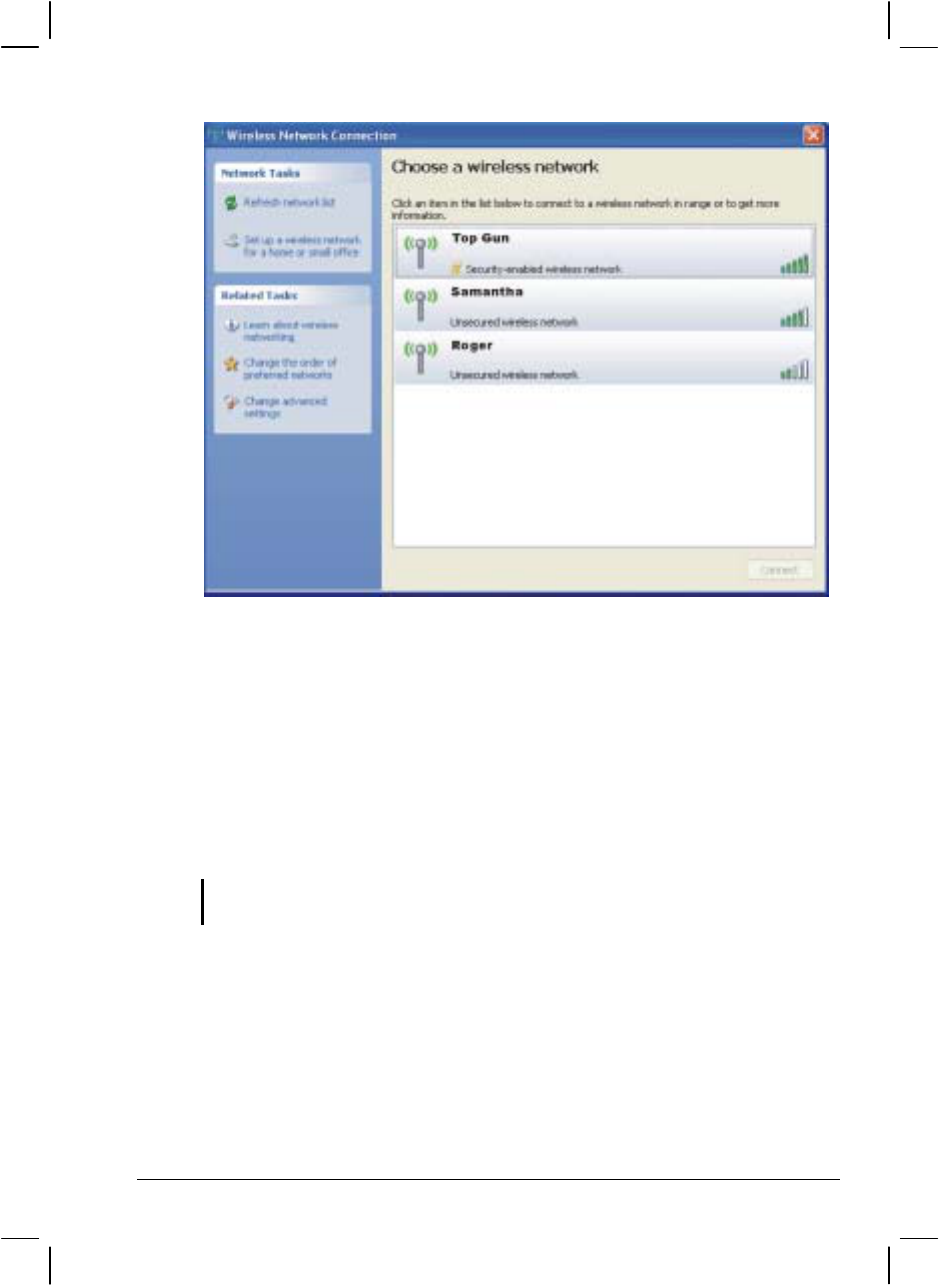
Operating Your Computer 2-23
2. Select a wireless network to connect to by clicking on a selection,
then click on Connect.
3. Depending on the settings, you may be asked to enter a WEP key
(refer to your Windows online help for more information on setting a
wireless network connection).
Using the Modem
NOTE: To take advantage of the modem feature, the modem driver supplied with your
computer must be installed.
The internal 56 K fax/data modem allows you to use the telephone line to
communicate with others by fax, email, or connect to an online service or
bulletin board.
To connect the telephone line to the modem, connect one end of the
modem cable to the RJ-11 connector on the computer and the other end to
the phone line.
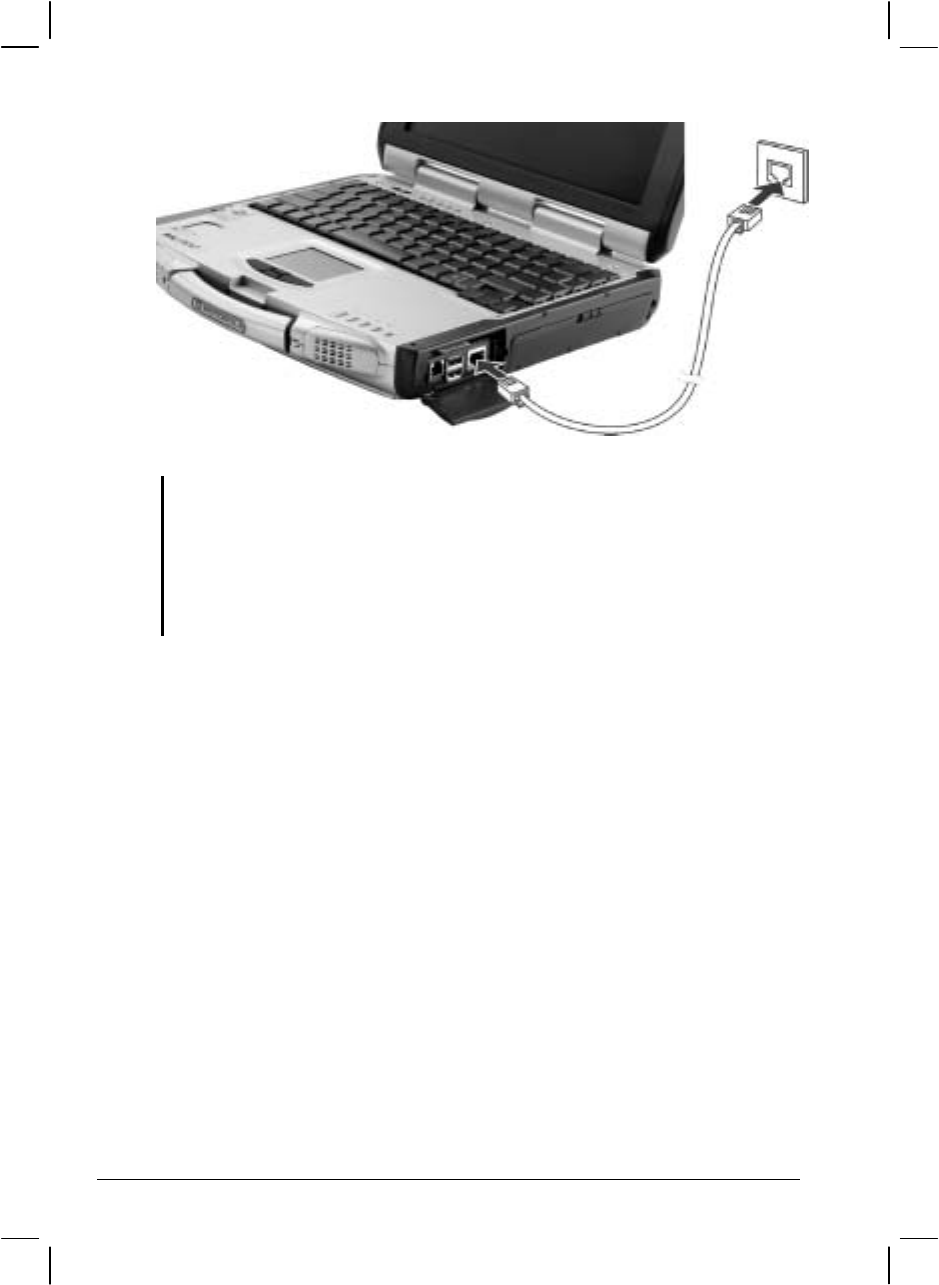
2-24 Operating Your Computer
NOTES:
When using communication software, you may have to disable power
management.
Set the COM port of the modem to COM3.
Set parameters such as modem speed (baud rate) and line type (pulse dialing or
tone dialing).
Do not enter Standby mode when using communication software.
Using the Wireless Modem (option)
Depending on your model, your computer includes an integrated GSM
(Global System for Mobile Communications) / GPRS (General Packet
Radio Service) feature.
After you establish a subscription with a GSM/GPRS service provider,
you can use the wireless data features of your computer. Check with your
service provider for a list of available wireless data services. Your service
provider may charge additional fees for use of data services.
There are two methods for wirelessly connecting to an ISP or network:
GSM data transmission (circuit-switched data)
GSM data services enable you to use the GSM component of your
computer as a built-in modem. You can use the service to connect to
the Internet through an ISP or dial in to a corporate network to browse
the Web or send and receive e-mail messages.

Operating Your Computer 2-25
GPRS data transmission
GPRS is a high-speed data-on service that enables you to transmit
data over a mobile network. Subscribing to a GPRS service allows
you to transfer files, browse the Web and receive streaming audio and
video on your computer.
Connecting Using the GSM Modem
Your computer can send and receive data via a mobile network using the
GSM protocol.
To send or receive data over a GSM network, you must have an account
with a service provider that supports GSM data services, and the service
provider must enable the data features on your account.
Configuring a GSM Modem Connection
Before you can use the GSM modem connection, make sure that you have
a subscription to the Circuit-Switched Data (CSD) network with your
service provider and you have an account with your service provider or
corporate network you are connecting to.
To connect to an ISP or dial in to a specific computer, you must configure
a connection for that service on your computer.
Connecting Using GPRS
Your computer can receive General Packet Radio Services (GPRS), a
high-speed data-only service that transmits data over a mobile telephone
network. In addition, GPRS provides permanent on-line connection.
To use GPRS, you must have a subscription to the function with a service
provider that supports GPRS.
Configuring a GPRS Connection
To connect to a GPRS network, you must configure a connection for that
service on your computer.

2-26 Operating Your Computer
Using the GPS (option)
Navigation and positioning are crucial to so many activities and yet the
process has always been quite cumbersome. To try to figure out where
you are and where you are going, you need GPS technology.
The Global Positioning System (GPS) is a worldwide radio-navigation
system formed from a constellation of 24 satellites and their ground
stations. GPS uses these "man-made stars" as reference points to calculate
positions accurate to a matter of meters. In fact, with advanced forms of
GPS you can make measurements to better than a centimeter! In a sense it
is like giving every square meter on the planet a unique address.
Here's how GPS works in five logical steps:
The basis of GPS is "triangulation" from satellites.
To "triangulate," a GPS receiver measures distance using the travel
time of radio signals.
To measure travel time, GPS needs very accurate timing that it
achieves with some tricks.
Along with distance, you need to know exactly where the satellites are
in space. High orbits and careful monitoring are the secret.
Finally you must correct for any delays the signal experiences as it
travels through the atmosphere.
Five broad categories of GPS application:
Location – determining a basic position
Navigation – getting from one location to another
Tracking – monitoring the movement of people and things
Mapping – creating maps of the world
Timing – bringing precise timing to the world

Operating Your Computer 2-27
Using the Bluetooth (option)
NOTE: To take advantage of the Bluetooth feature, the Bluetooth driver supplied with
your computer must be installed.
Your computer is compliant with Bluetooth Class 1. To ensure
interoperability between other devices supporting Bluetooth technology,
check with the manufacturers of other devices to determine their
compatibility with your computer.
NOTES:
There may be restrictions on using Bluetooth technology in some locations. Check
with your local authorities or service provider.
Features using Bluetooth technology, or allowing such features to run in the
background while using other features, increase the demand on battery power and
reduces the battery life.
Bluetooth technology enables wireless connections between electronic
devices. A Bluetooth connection can be used to send files or to connect
wirelessly to compatible devices using Bluetooth technology, such as
cellular phones and PDAs.
Since devices using Bluetooth technology communicate using radio
waves, your computer and the other devices do not need to be in direct
line-of-sight. Your computer and the other device only need to be within
a maximum of 10 meters of each other, although the connection can be
subject to interference from obstructions such as walls or from other
electronic devices.

CHAPTER 3
Managing Power
Your computer operates either on external AC power or internal battery
power.
This chapter tells you how you can effectively manage power. To
maintain optimal battery performance, it is important that you use the
battery in the proper way.
The topics in this chapter include:
What is an AC adapter
How to charge the battery pack
When and how to initialize the battery pack
How to check the battery level
How to replace the battery pack
What happens when the battery is low and what actions to take
What is Power Management
How to save power

3-2 Managing Power
AC Adapter
CAUTION:
The AC adapter is designed for use with your computer only. Connecting the AC
adapter to another device can damage the adapter.
The AC power cord supplied with your computer is for use in the country where you
purchased your computer. If you plan to go overseas with the computer, consult
your dealer for the appropriate power cord.
When you disconnect the AC adapter, disconnect from the electrical outlet first and
then from the computer. A reverse procedure may damage the AC adapter or
computer.
When unplugging the connector, always hold the plug head. Never pull on the cord.
The AC adapter serves as a converter from AC (Alternating Current) to
DC (Direct Current) power because your computer runs on DC power,
but an electrical outlet usually provides AC power. It also charges the
battery pack when connected to AC power.
The AC adapter operates on any voltage in the range of 100 ~ 240 V AC.

Managing Power 3-3
Battery Pack
The battery pack is the internal power source for the computer. It is
rechargeable using the AC adapter.
The operating time of a fully charged battery pack depends on how you
are using the computer. When your applications often access peripherals,
you will experience a shorter operating time.
NOTE: Care and maintenance information for the battery is provided in the “Battery
Pack Guidelines” section in Chapter 7.
Charging the Battery Pack
NOTES:
Charging will not start if the battery’s temperature is below -5 °C (32 °F) or above
46 °C (122 °F).
The thermal protection of battery pack is 75 °C (147°F) for both Charge and
discharger mode. In any case, once the temperature of battery pack reach to
75°C(147°F), the battery pack will cut off the output and input MOSFET
immediately, the means is battery stop the charge and discharge. If this happens,
the battery pack may be damaged. Please contact your dealer.
During charging, do not disconnect the AC adapter before the battery has been fully
charged; otherwise you will get a prematurely charged battery.
To charge the battery pack, connect the AC adapter to the computer and
an electrical outlet. Battery status indicator ( ) will light amber when
battery is charging, and light green when battery is charged full. You are
advised to keep the computer power off while the battery is being
charged. Battery low indicator will blink amber when battery capacity is
below 10 percentages.
It takes approximately 180 minutes (3 hours) to charge the battery pack
when the computer is off and 240 minutes (4 hours) to fully charge the
battery pack when the computer is on.
CAUTION: After the computer has been fully recharged, do not immediately disconnect
and reconnect the AC adapter to charge it again. Doing so may damage the battery.
NOTE: The battery level may automatically lessen due to the self-discharge process
(0.21% per day), even when the battery pack is fully charged (100%). This happens no
matter if the battery pack is installed in the computer.
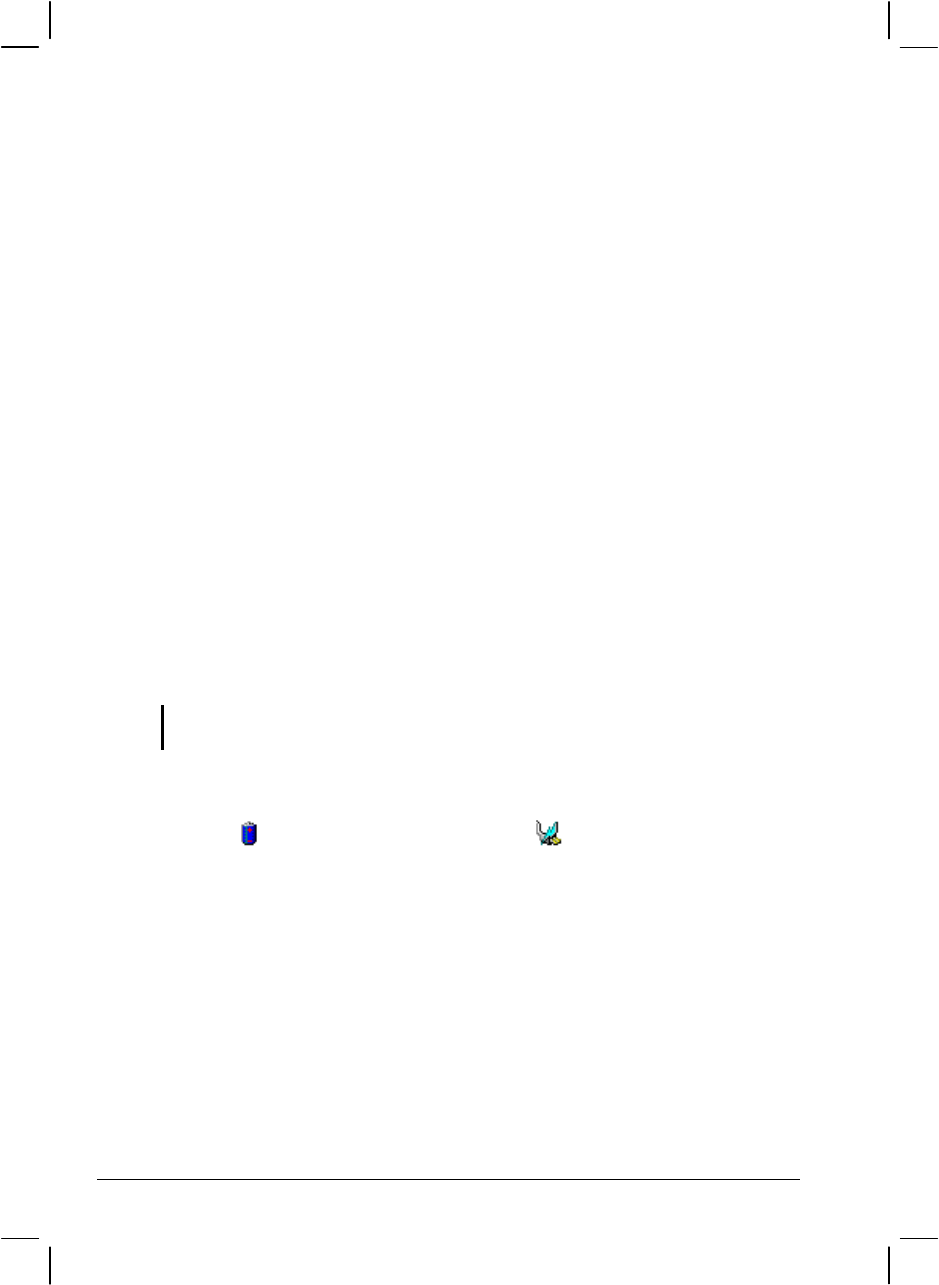
3-4 Managing Power
Initializing the Battery Pack
You need to initialize a new battery pack before using it for the first time
or when the actual operating time of a battery pack is much less than
expected.
Initializing is the process of fully charging, discharging, and then
charging. It can take several hours.
1. Make sure the computer power is turned off. Connect the AC adapter
to fully charge the battery pack.
2. After the battery pack is fully charged, turn on the computer.
3. Disconnect the AC adapter and leave the computer on until the
battery is fully discharged. The computer will shut down
automatically.
4. Connect the AC adapter to fully charge the battery pack.
Checking the Battery Level
NOTE: Any battery level indication is an estimated result. The actual operating time can
be different from the estimated time, depending on how you are using the computer.
You can check the approximate battery level using the battery meter
function of the operating system. To read the battery level in Windows,
click the icon on the taskbar. (Click the icon if the computer is
using AC power.)
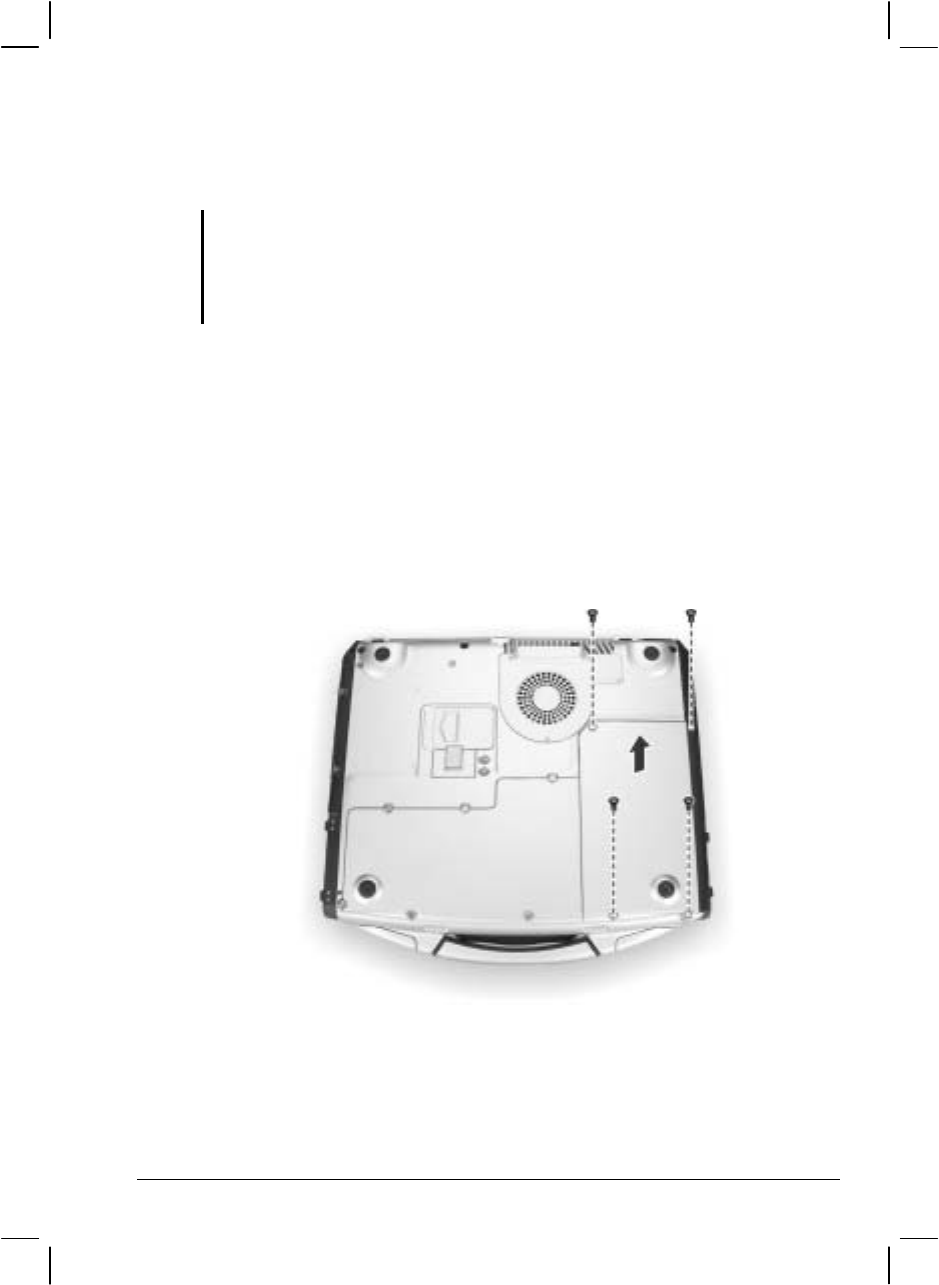
Managing Power 3-5
Replacing the Battery Pack
CAUTION:
There is danger of explosion if the battery is incorrectly replaced. Replace the
battery only with the computer manufacturer’s optional battery packs. Discard used
batteries according to the dealer’s instructions.
Do not attempt to disassemble the battery pack.
If you often rely on battery power for a long period of time while
traveling, you may consider the purchase of an additional battery pack
from your dealer and keep it with you in a fully charged state as a backup.
To replace the battery pack, follow these steps:
1. Make sure the computer is not turned on or connected to AC power.
2. Remove the four screws and lift the battery pack compartment cover
to take it off the computer.
3. Pull on the ribbon and take the battery pack off the computer.
4. Insert the new battery pack into the compartment.

3-6 Managing Power
5. Replace the battery pack compartment cover and secure the four
screws.
Battery Low Signals and Actions
Battery Low occurs when the battery has approximately 10% (Windows
default setting) of its charge remaining. The computer gives warning
beeps or messages and the Battery Power Indicator ( ) blinks amber
(orange) to alert you to take actions.
NOTE: You can set up your threshold and signals of Battery Low under Windows.
Immediately save your data upon Battery Low. The remaining operating
time depends on how you are using the computer. If you are using the
audio subsystem, hard or DVD/Combo/DVD Dual drives, the battery
might run out of charge very quickly.
Always respond to Battery Low by placing your computer on Standby or
Hibernation mode, turning off the computer, or connecting the AC
adapter.
If you do not take any action, the computer will automatically hibernate
and turn off.
CAUTION: If you fail to save your data when the battery completely runs out of charge,
then you lose your data.

Managing Power 3-7
Power Management
Your computer supports ACPI (Advanced Configuration and Power
Interface) for power management. The power management feature allows
you to reduce the power consumption for energy saving.
With an ACPI-compliant operating system such as Windows 2000 and
Windows XP, power supply to different computer components is
controlled on an as-needed basis. This allows maximum power
conservation and performance at the same time.
In general, Windows’ power management works in this way:
What… When…
Power to the hard disk is turned off When the hard disk has been idle for a
set period.
Power to the display is turned off When the display has been idle for a set
period.
When the entire system has been idle
for a set period.
When you press Fn+F10. *
When you close the cover. *
The computer enters Standby mode.
The hard disk and display are turned
off and the entire system consumes
less power.
When you press the power button. *
When you press the power button. *
When you press Fn+F10. *
The computer enters Hibernation
mode. (See the next subsection for
more information.) When you close the cover. *
* depends on your settings in Windows.
For detailed information on power management, see Windows’ Help.

3-8 Managing Power
Hibernation
Hibernation is a very useful feature. People frequently open many
applications when they use computers. It takes some time to get all these
applications open and running, and normally they all have to be closed
before the system can be turned off.
When you use the hibernation feature, you do not have to close the
applications. The computer stores the state of your computer to a file on
the hard disk and then shut down. The next time you turn on your
computer, you return to exactly where you left off.

Managing Power 3-9
Power-Saving Tips
In addition to your computer’s automatic power management, you can do
your part to maximize the battery’s operating time by following these
suggestions.
Do not disable Power Management.
Decrease the LCD brightness to the lowest comfortable level.
Disable the serial port if no device is connected to this port. (See
“Advanced Menu” in Chapter 5.)
If you work with an application that uses the serial port or features
wireless connectivity (LAN/WLAN/modem/GPS/Bluetooth), exit
the application when you finish using it.
Turn off the computer when you are not using it.

3-10 Managing Power

CHAPTER 4
Expanding Your Computer
You can expand the capabilities of your computer by connecting other
peripheral devices. When using a device, be sure to read the instructions
accompanying the device together with the relevant section in this
chapter.
This chapter gives guidelines on installing and using these devices:
External monitor
USB device
Serial device
IR device
Video capture device
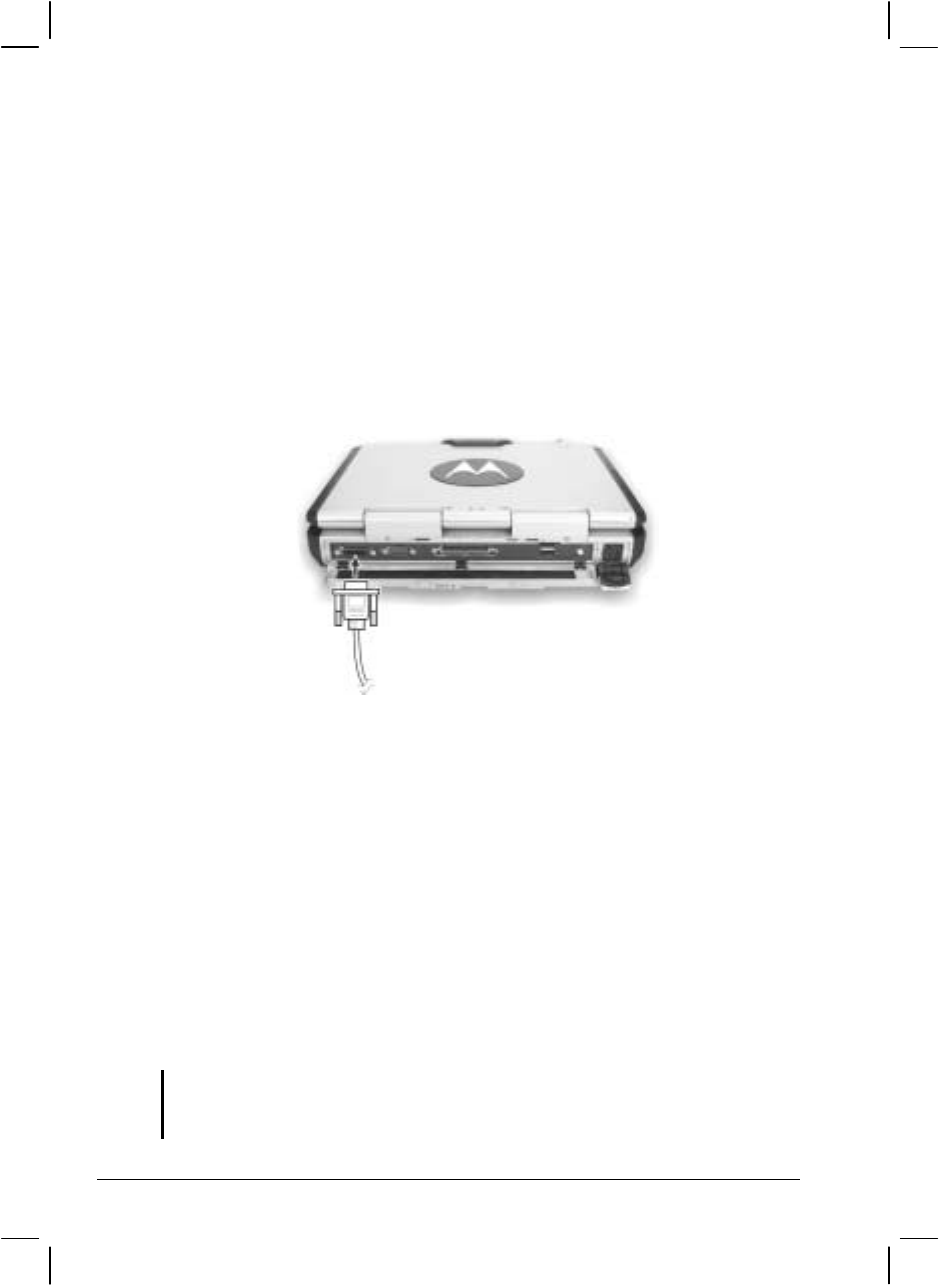
4-2 Expanding Your Computer
Connecting an External Monitor
If you want the benefits of a larger display screen with higher resolution,
you can connect an external CRT monitor that supports the DVI interface
to your computer.
Follow this procedure to connect an external monitor:
1. Make sure that the computer is not turned on.
2. Plug the monitor’s signal connector to the computer’s DVI-I port.
3. Plug one end of the monitor’s power cord into the power socket on
the monitor and the other end to an electrical outlet.
4. To use the monitor, turn on the monitor before turning on the
computer.
5. The monitor should respond by default. If not, you can switch the
display to the monitor or to both (simultaneous display), or to
multi-display by pressing Fn+F9. In Windows, you can also change
the display through the settings in Display Properties.
6. You can change display settings through your operating system. See
your operating system documentation or online help for specific
information.
CAUTION: Do not disconnect the external monitor while the computer is in Standby
mode or Hibernation mode. If no external monitor is connected when the computer
resumes, the LCD remains blank and the output is not displayed.
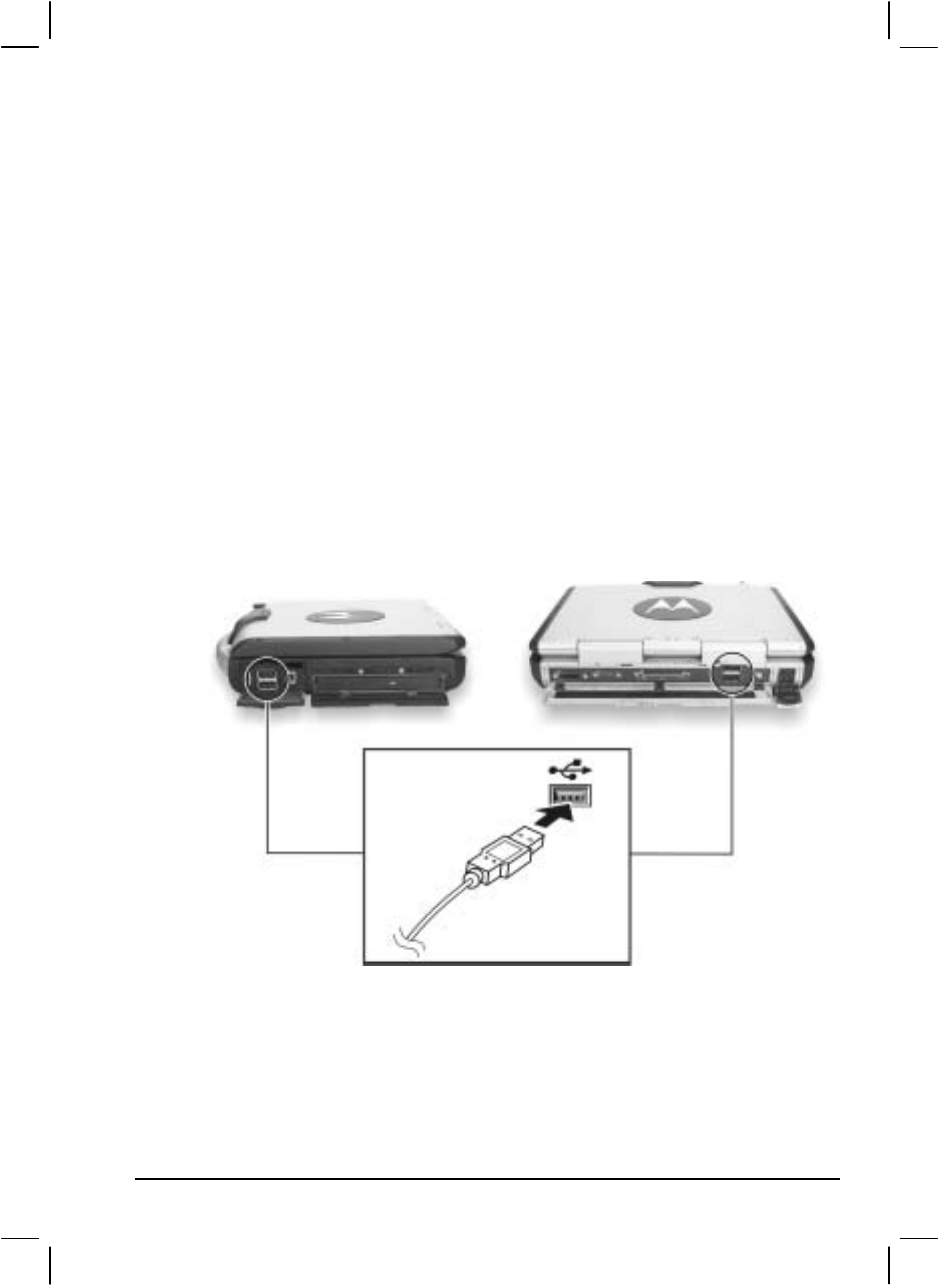
Expanding Your Computer 4-3
Connecting a USB Device
Your computer has two USB ports that supports transfer rates up to 12
MB/s for USB 1.1 devices and 480 MB/s for USB 2.0 devices, such as
digital camera, scanner, printer, modem, and mouse.
USB is specified to be an industry standard extension to the PC
architecture. It supports “Plug-and-Play” technology so you can install
and remove USB devices without turning off the computer. With its
multiple connection capability, up to 127 devices can be connected in a
daisy-chain configuration. In addition, you can use a USB hub that
converts a single USB connector into multiple ports where USB devices
can be connected.
To connect a USB device, simply plug the device cable to one of the USB
ports.
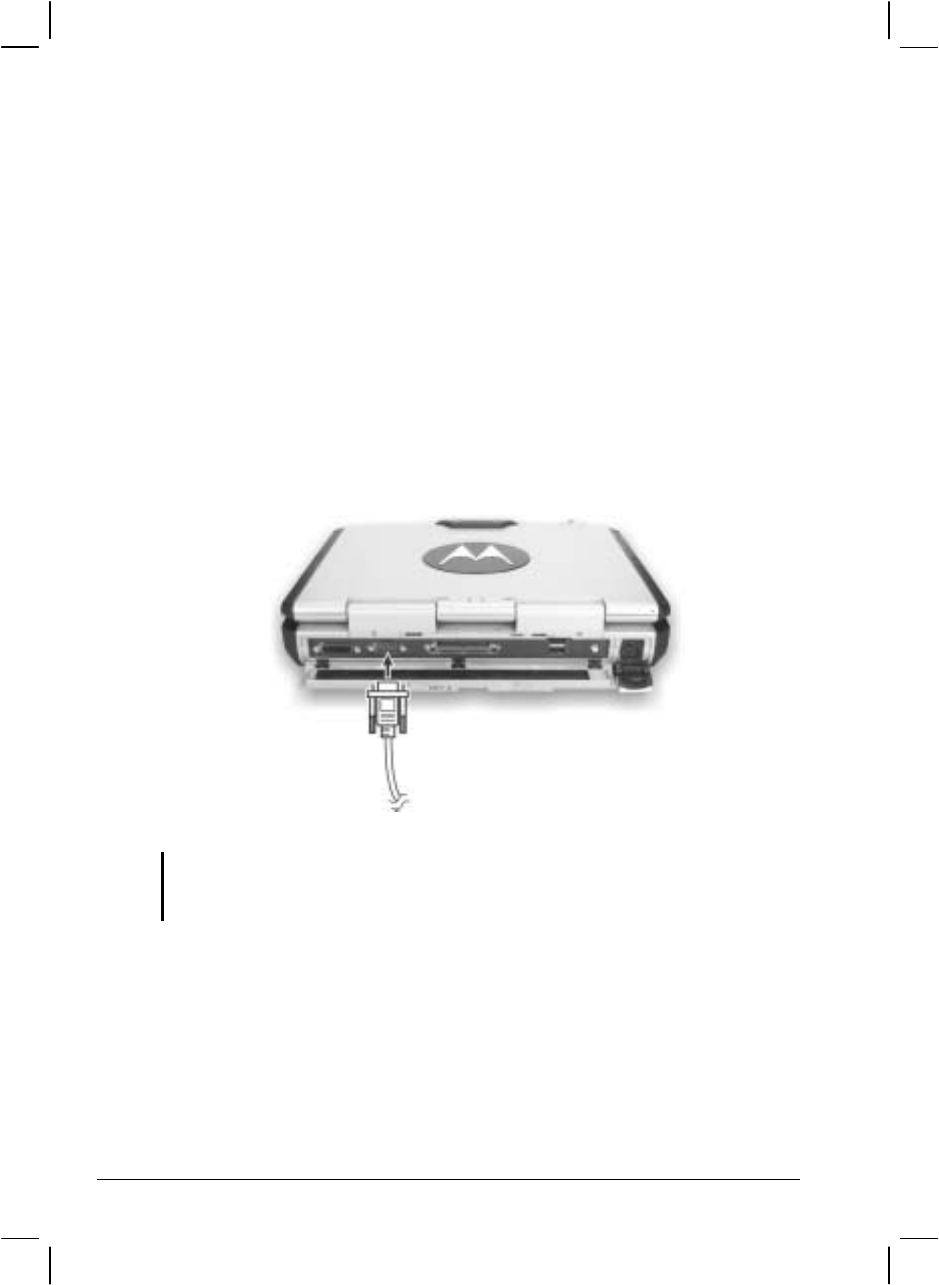
4-4 Expanding Your Computer
Connecting a Serial Device
Your computer has a serial port for connecting a serial device such as an
external modem.
Follow this procedure to connect a serial device:
1. Make sure the “COM1 Settings” item is set properly in the SCU
program. (See “Advanced Menu” in Chapter 5 for information.)
2. Make sure the computer is not turned on.
3. Plug the device cable to the serial port on the rear of the computer.
4. Turn on the computer.
NOTE: Portable modems that derive power through the serial port cannot be used with
the computer. Instead, use a modem that is powered by its own internal battery or
external AC power.

Expanding Your Computer 4-5
Connecting an IR Device
Your computer has an IR (infrared) port for connecting an
infrared-equipped device wirelessly such as another computer, printer, or
PDA (Personal Digital Assistant).
Follow this procedure to connect an IR device:
1. Under Windows, make sure that the IrDA Fast Infrared Port is set to
HP HSDL-2300/3600.
2. Make sure that the “COM Ports” and its “COM2 (FIR) Settings”
items are set properly in the SCU program. (See “Advanced Menu”
in Chapter 5 for information.)
3. When using the IR port:
Place the transmitting device where its IR port faces the IR port of
your computer within the effective range − within ±20-degrees
vertical angle and within ±20-degrees horizontal angle at no greater
than 0.8~1.0 meter distance.
Place the receiving device where the IR port of your computer faces
its IR port within the effective range − within ±15-degrees vertical
angle and within ±15-degrees horizontal angle at no greater than
0.8~1.0 meter distance.
4. To take advantage of IR communications, you need a third party
software.
NOTES: During infrared communication, take note of the following:
Do not move the computer and IR device.
Do not enter Standby mode.
Do not use a cell phone or another IR device near the computer.
Avoid strong light such as sunlight or fluorescent light.
Disable the screen saver.
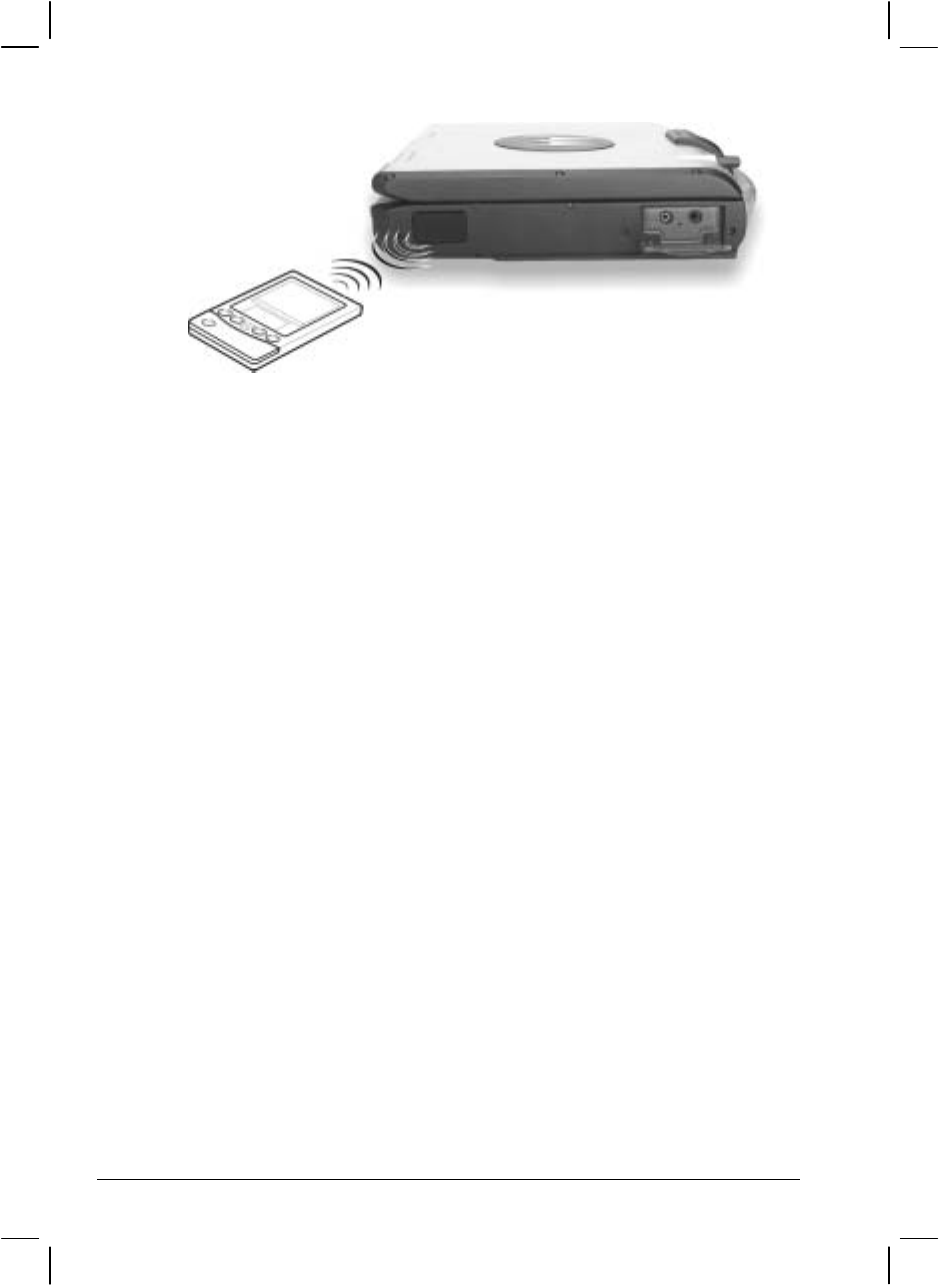
4-6 Expanding Your Computer
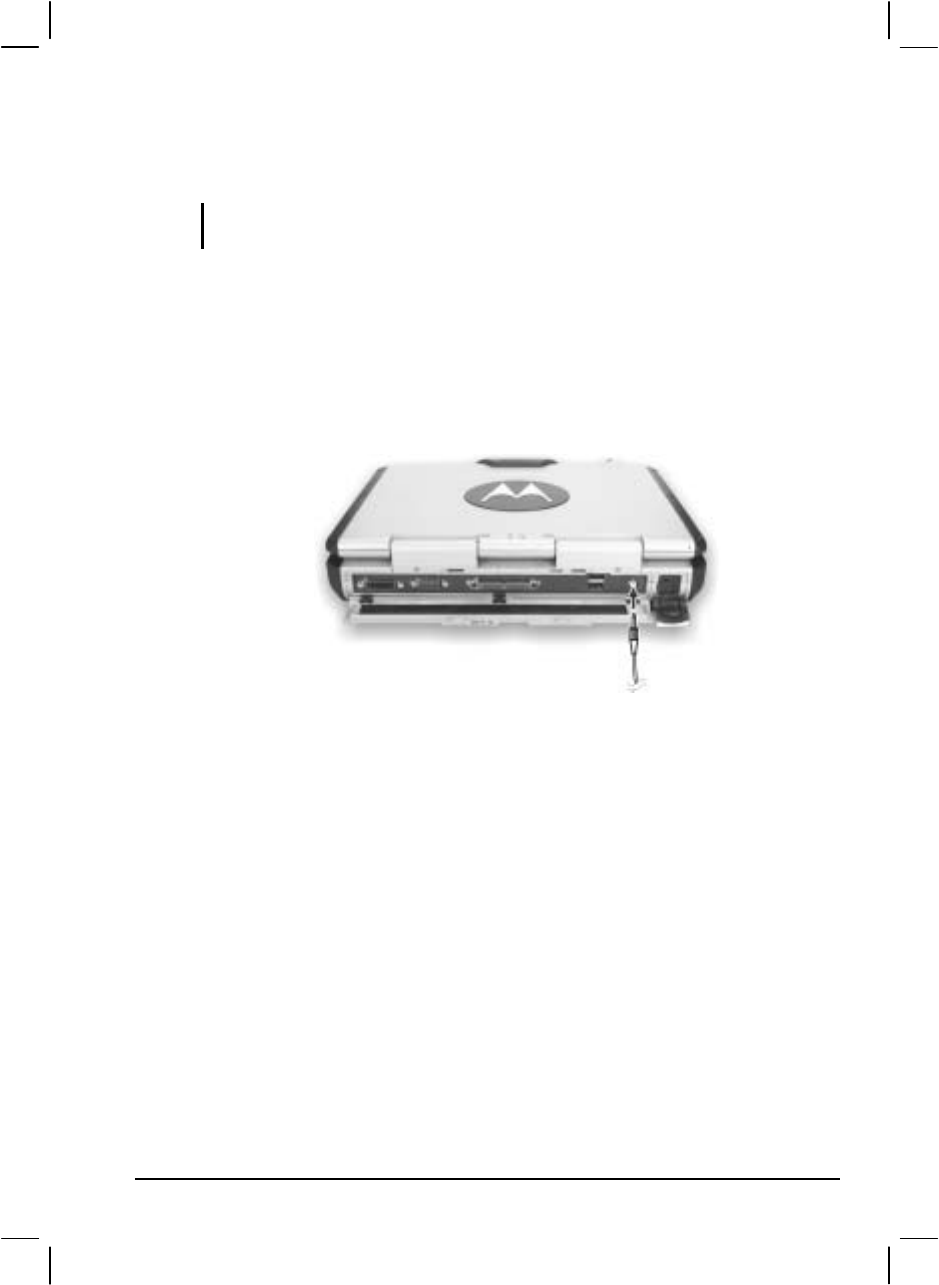
Expanding Your Computer 4-7
Connecting a Video Capture Device
NOTE: To take advantage of the AV input port, the Video Capture driver supplied with
your computer must be installed (see chapter 6 for details).
Your computer has an AV input port on the rear of the computer for
connecting a video capture device such as high-quality CCD, as well as
consumer electronic equipment such as DVCAM and VCR.
To connect a video capturing device, simply plug the device cable to the
AV input port (conexant 878A PCI; BNC-type) of the system.

4-8 Expanding Your Computer
System Memory Upgrade
You can upgrade your computer by changing system memory to a
maximum of 2 GB on the two 200-pin DDR SO-DIMM slots. However,
to avoid damage during the installation procedure, please ask your dealer
for help.

CHAPTER 5
Setup Configuration Utility (SCU)
SCU is a program for configuring the BIOS (Basic Input/Output System)
settings of the computer.
BIOS is a layer of software, called firmware, that translates instructions
from other layers of software into instructions that the computer hardware
can understand. The BIOS settings are needed by your computer to
identify the types of installed devices and establish special features.
This chapter tells you how to use the SCU program.

5-2 Setup Configuration Utility (SCU)
When and How to Use the SCU Program
When to Use
You need to run the SCU program when:
You see an error message on the screen requesting you to run Setup.
You want to restore the factory default settings.
You want to modify some specific settings according to the hardware.
You want to modify some specific settings to optimize system
performance.
Starting SCU
NOTES:
The Setup screens shown in this chapter are for your reference only. The actual
items or settings on your computer may differ.
The Setup program may have been updated after the publication of this manual.
The settings you select in your operating system might override similar settings in
Setup.
To run SCU, press F2 when the prompt appears in the lower left corner of
the screen during system startup. The prompt shows up on the screen for
only a few seconds. You must press F2 quickly. The SCU menu appears
as shown next.
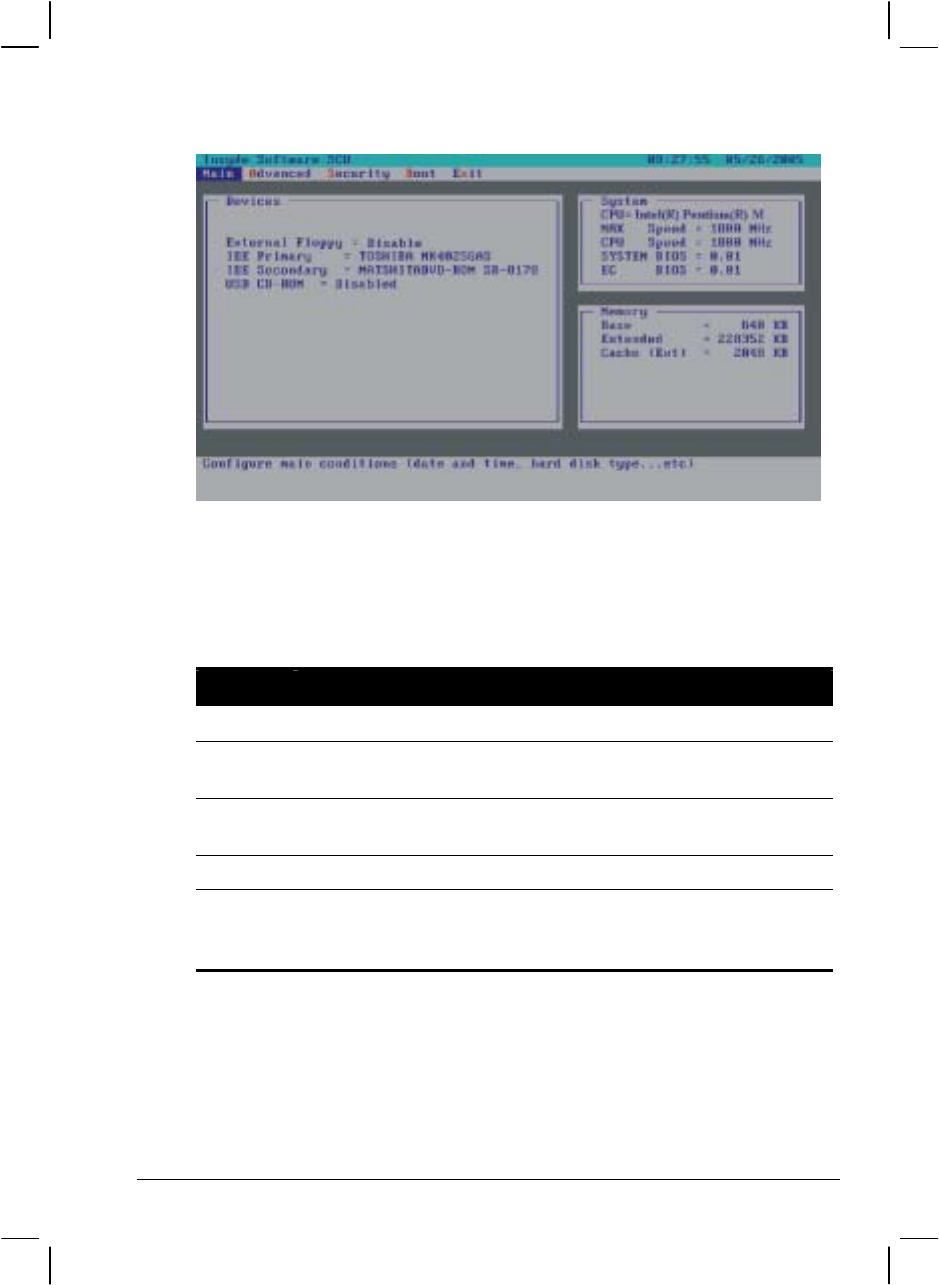
Setup Configuration Utility (SCU) 5-3
Moving Around and Making Selections
A brief description of keyboard usage is listed next:
Key Function
←, → Selects a menu title.
↑, ↓ 1) Selects an item or option.
2) Brings up/down the value.
Enter 1) Brings up the sub-menu when available.
2) Opens or closes the options window when an item is selected.
Tab Jumps from one item to another.
Esc 1) Exits the SCU program.
2) Returns to the previous menu if in a sub-menu.
3) Closes the options window if one is open.
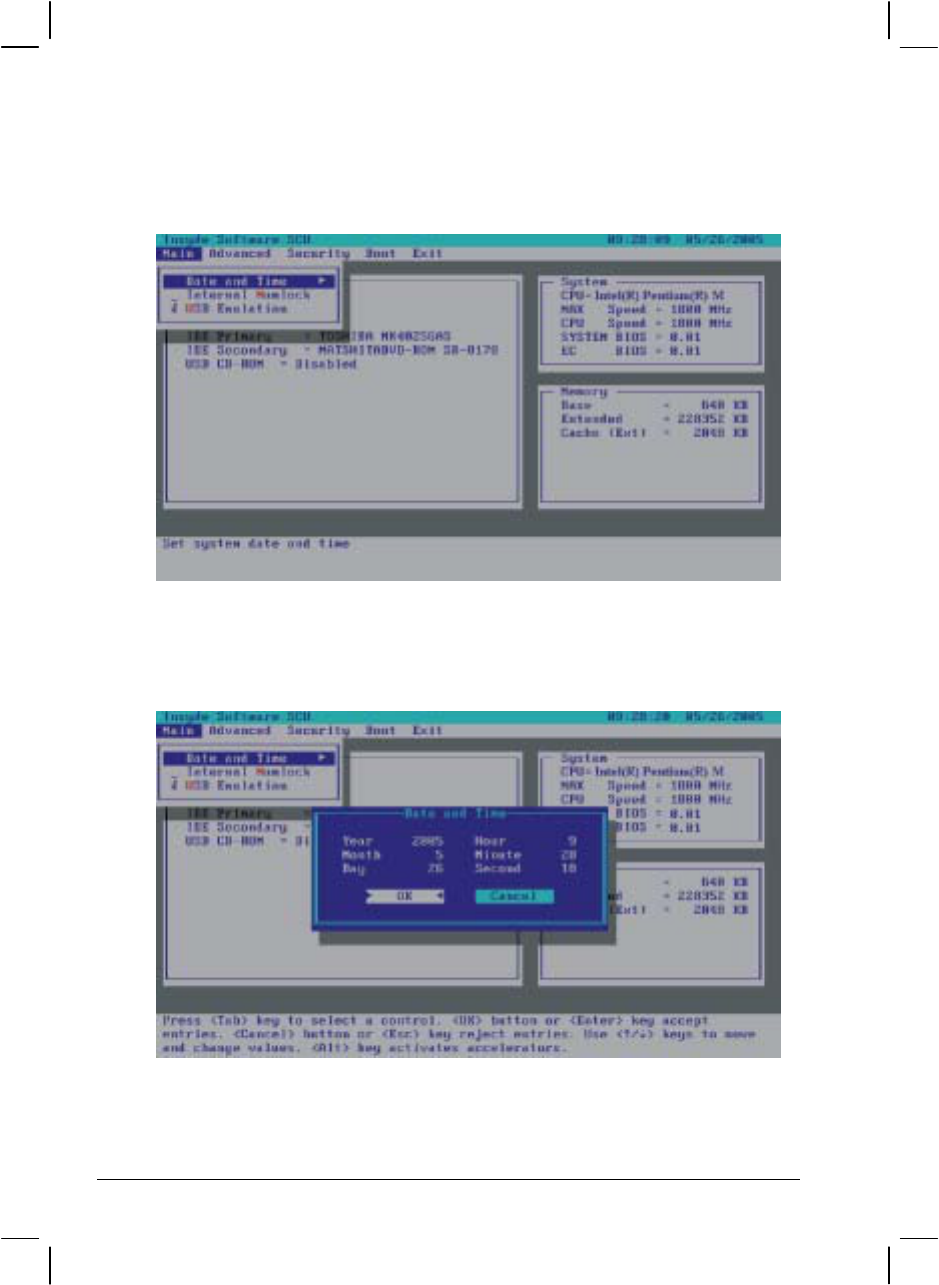
5-4 Setup Configuration Utility (SCU)
Main Menu
Date and Time
Sets the system time (Hour, Minute, Second) and date (Month, Day,
Year).

Setup Configuration Utility (SCU) 5-5
Internal Numlock
Sets if you can enter a number when Num Lock is turned off. When this
item is enabled, you can press and hold Fn, and then press a letter key to
enter a number even if Num Lock is turned off. When this item is disabled,
you cannot enter a number with the above method. A check mark ()
indicates enabled while underline (_) indicates disabled. Default setting is
enabled.
USB Emulation
Enables or disables the system’s support for the USB port in DOS mode.
A check mark () indicates enabled while underline (_) indicates
disabled. Default setting is enabled.
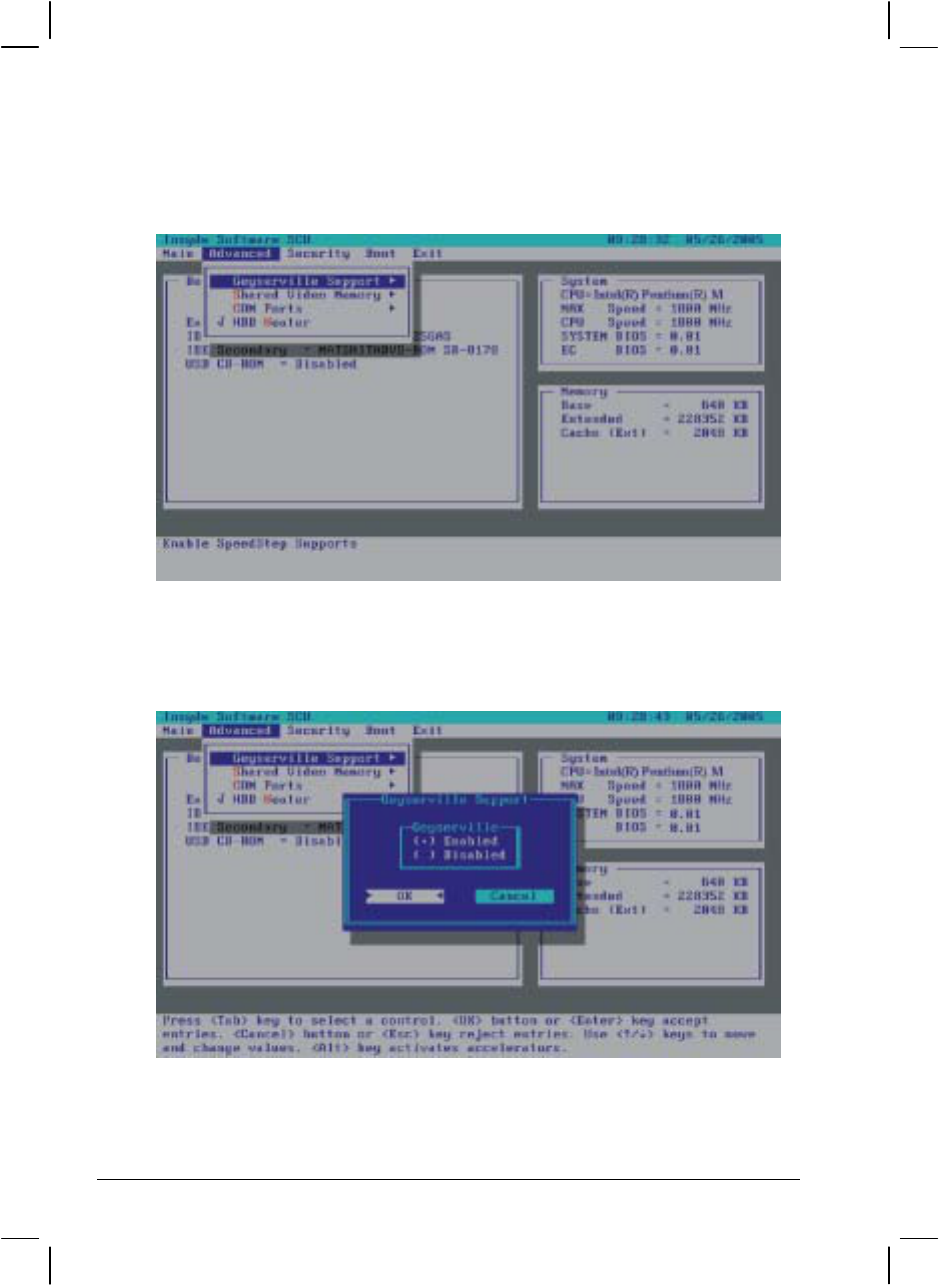
5-6 Setup Configuration Utility (SCU)
Advanced Menu
Geyserville Support
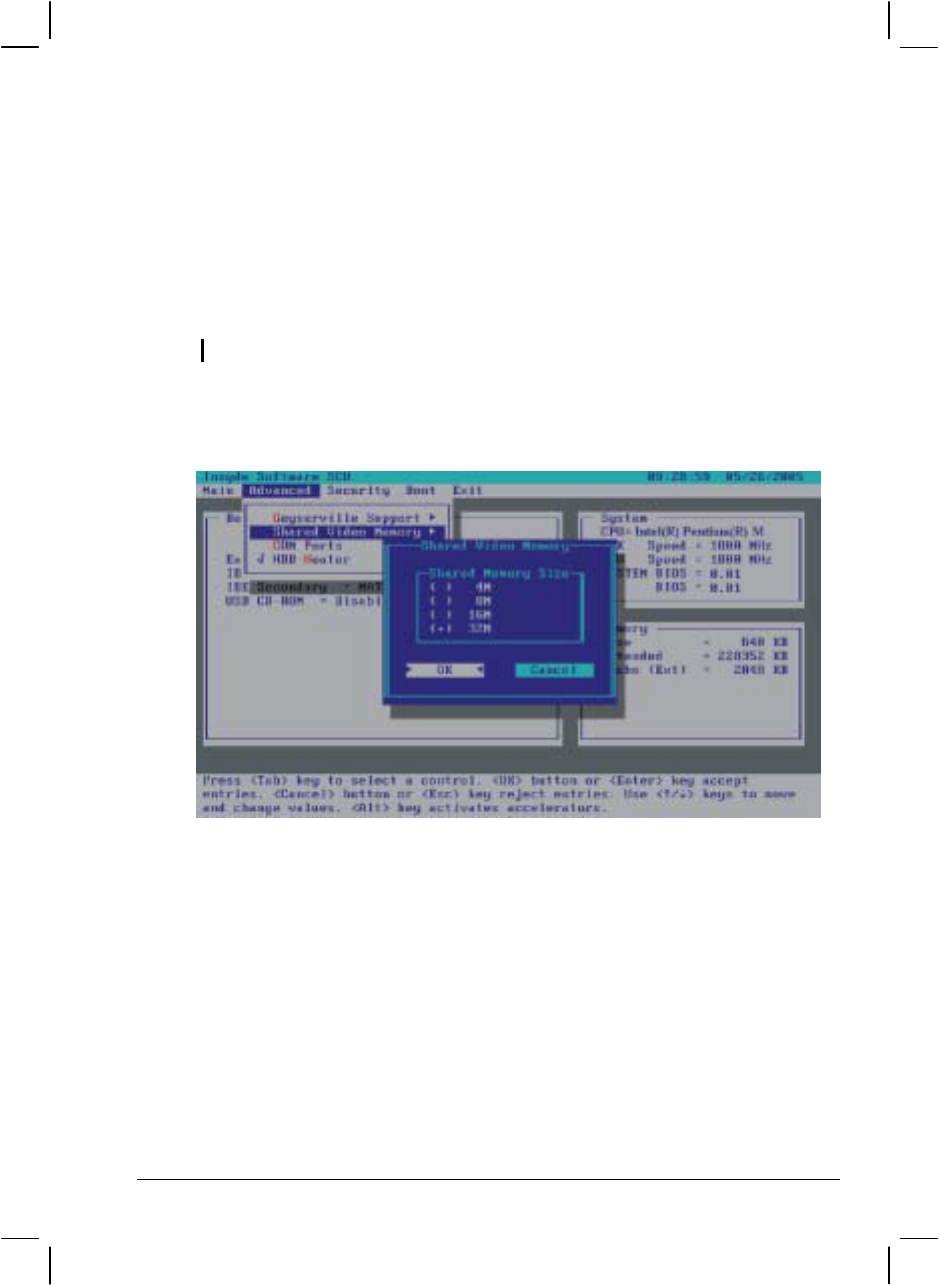
Setup Configuration Utility (SCU) 5-7
Enables or disables the Geyserville feature of the CPU. The Geyserville
feature helps conserve battery life by decreasing the CPU’s running speed
under certain conditions while still maintaining a high performance. If
this item is enabled, the CPU will automatically change its speed
whenever necessary based on the “Power Scheme” setting in Windows’
Control Panel. If this item is disabled, the CPU will always run in the
lowest speed. The options are Enabled and Disabled. The default setting
is Enabled.
NOTE: This item is available only when the CPU supports the Geyserville feature.
Shared Video Memory
Sets the shared memory size of the video controller. The options are 4M,
8M, 16M, and 32M. Default setting is 32M.
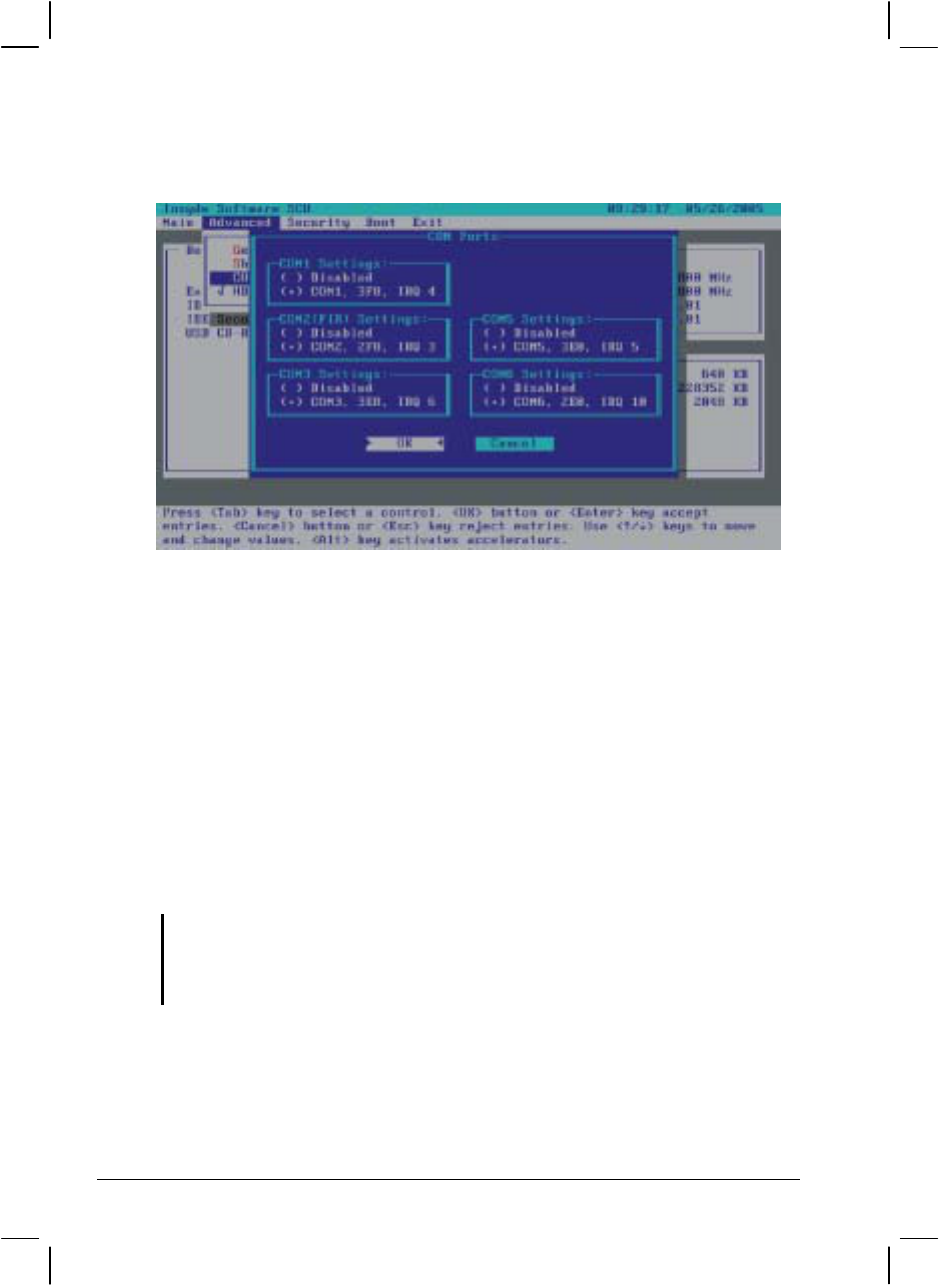
5-8 Setup Configuration Utility (SCU)
COM Ports
Allows you to configure the COM ports of the computer.
COM1 / 2 (FIR) / 3 / 5 / 6 Settings sets the I/O (Input/Output)
address and the Interrupt ReQuest line (IRQ) settings of the COM
ports. The options are Disabled; COM1, 3F8, IRQ4; COM2, 2F8,
IRQ3; COM3, 3E8, IRQ6; COM5, 3E0, IRQ5; COM6, 2E0, IRQ10.
HDD Heater
Sets if the system automatically turns on the built-in hard disk drive
heater for low temperature operation. A check mark (√) indicates
enabled, while underline (_) indicates disabled.
NOTES:
To use the HDD heater feature, the MTCCTRL driver supplied with your computer
must be installed (see chapter 6 for details).
Disable this item to conserve energy when using battery power.
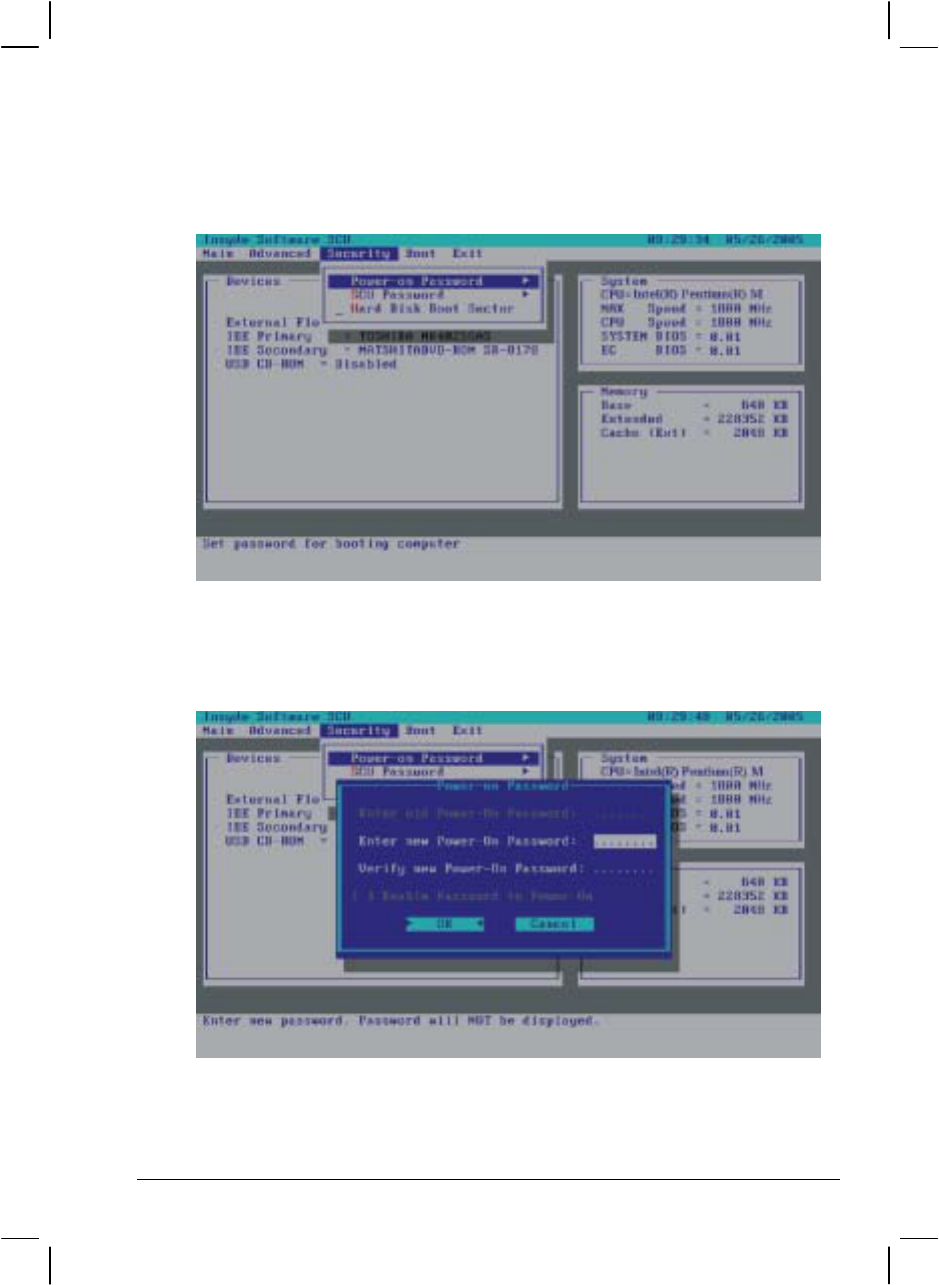
Setup Configuration Utility (SCU) 5-9
Security Menu
Power-on Password
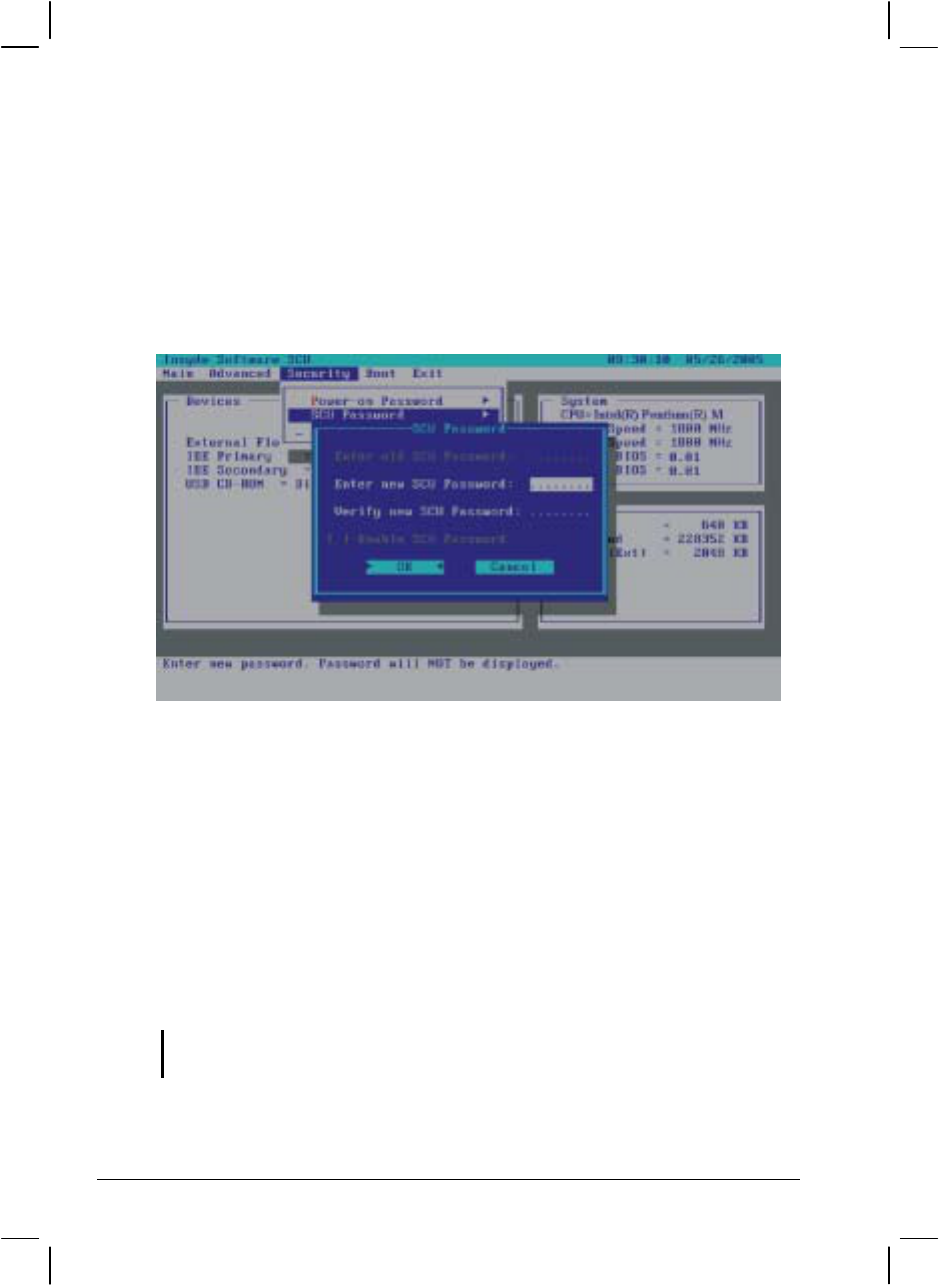
5-10 Setup Configuration Utility (SCU)
Allows you to set the password for your system. When typing the
password, first make sure that Num Lock is off, then type your password in
the entry fields and press Enter. Confirm your password by typing it again
and pressing Enter. If the Enable Password to Power-on sub-item is
enabled, the set password is always required to boot the computer.
SCU Password
Allows you to set the password for entering SCU Setup. When typing the
password, first make sure that Num Lock is off, then type your password in
the entry fields and press Enter. Confirm your password by typing it again
and pressing Enter. If the Enable SCU Password sub-item is enabled, the
SCU password is always required to enter SCU Setup.
Hard Disk Boot Sector
Sets if a warning message will appear when the hard disk boot sector
(partition table) has been changed. A checkmark () indicates enabled,
while an underline (_) indicates disabled. The default setting is disabled.
CAUTION: Set this item to disabled before installing an operating system, running
Fdisk or Format program. Otherwise, the intended action will fail.
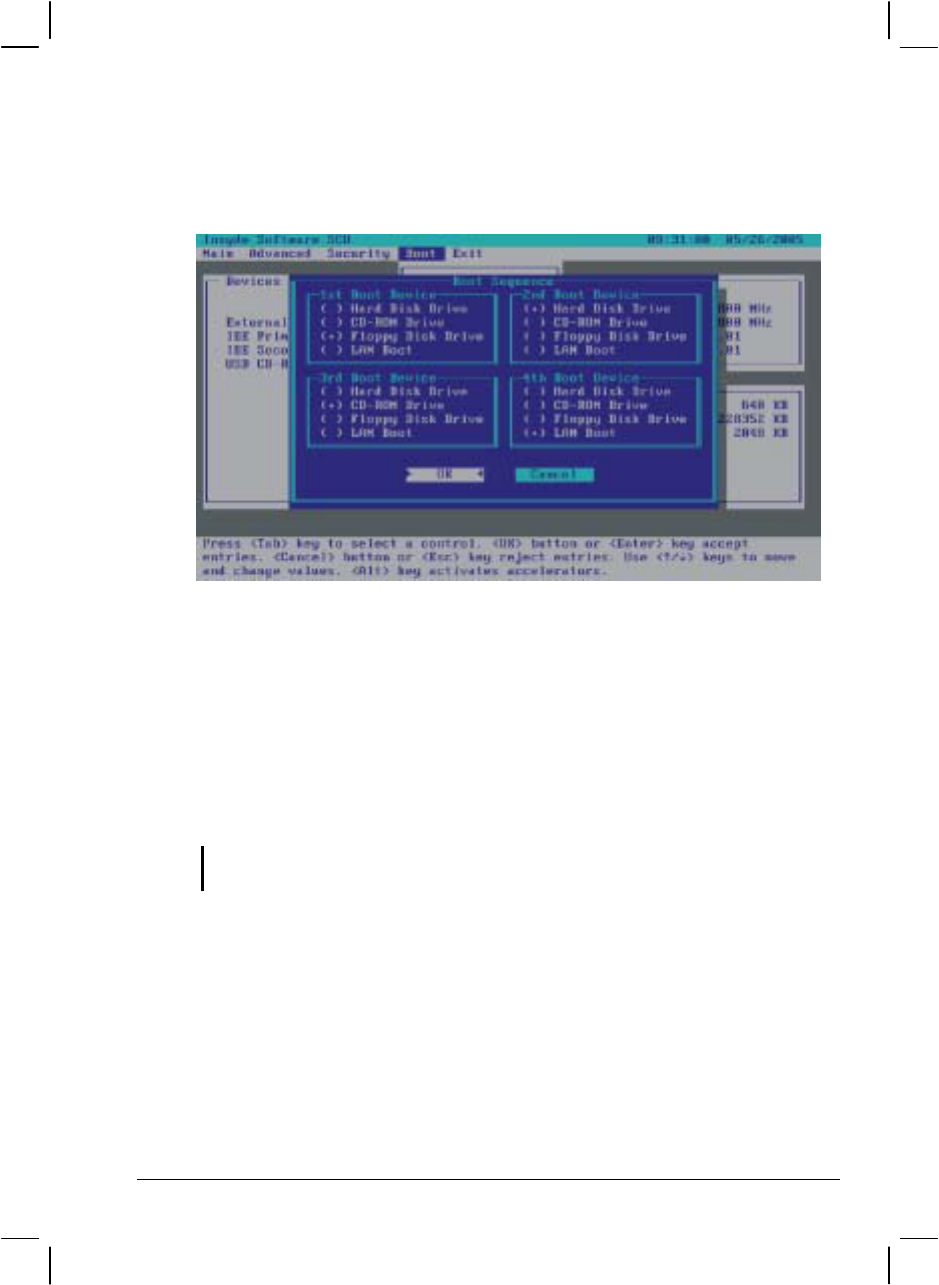
Setup Configuration Utility (SCU) 5-11
Boot Menu
Boot Sequence
Sets the first, second, third, and fourth booting device. The system will
try to boot from the first device but if it is not available, will try the next
boot device. If you set the first boot device to LAN Boot, the system will
boot from the LAN server first. The options are Hard Disk Drive,
CD-ROM Drive, Floppy Disk Drive, and LAN Boot. The default setting is
Floppy Disk Drive, Hard Disk Drive, CD-ROM Drive, then LAN Boot.
NOTE: If you set all booting options to the same device, then the computer will try to
boot from that device only.
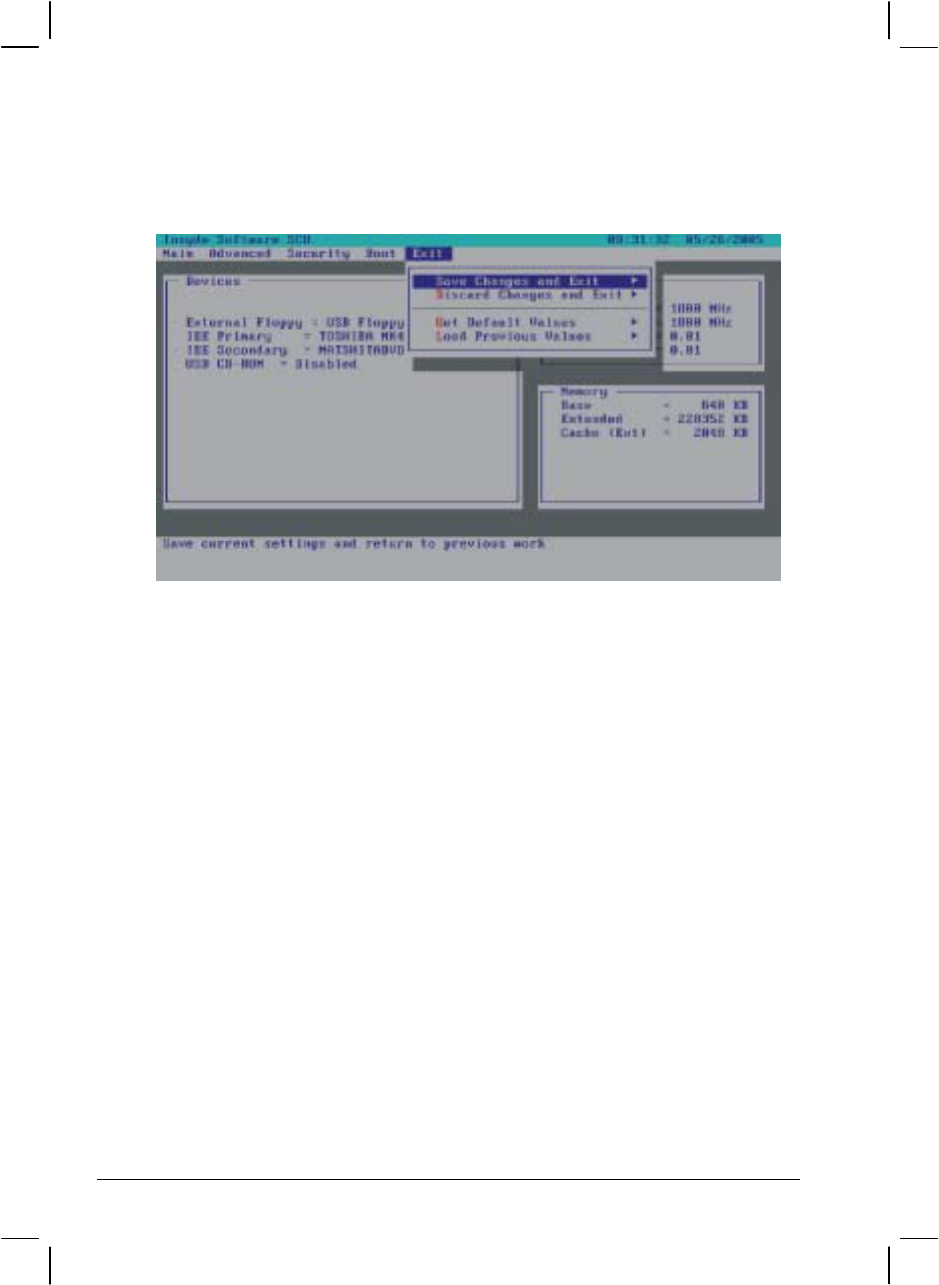
5-12 Setup Configuration Utility (SCU)
Exit Menu
Save Changes and Exit
Saves the changes you have made and exit the SCU program.
Discard Changes and Exit
Exits the SCU program without saving the changes you have made.
Get Default Values
Loads factory default values for all the items.
Load Previous Values
Restores previous values for all the items.

CHAPTER 6
Installing Software Drivers
To take full advantage of the unique features of your computer, some
operating systems require custom software, known as drivers, to be
installed.
If you purchased the computer with Windows pre-installed, your dealer
may have already installed the drivers. If not, you need to install the
drivers using the driver CD supplied with your computer.
This chapter describes how to install the drivers.
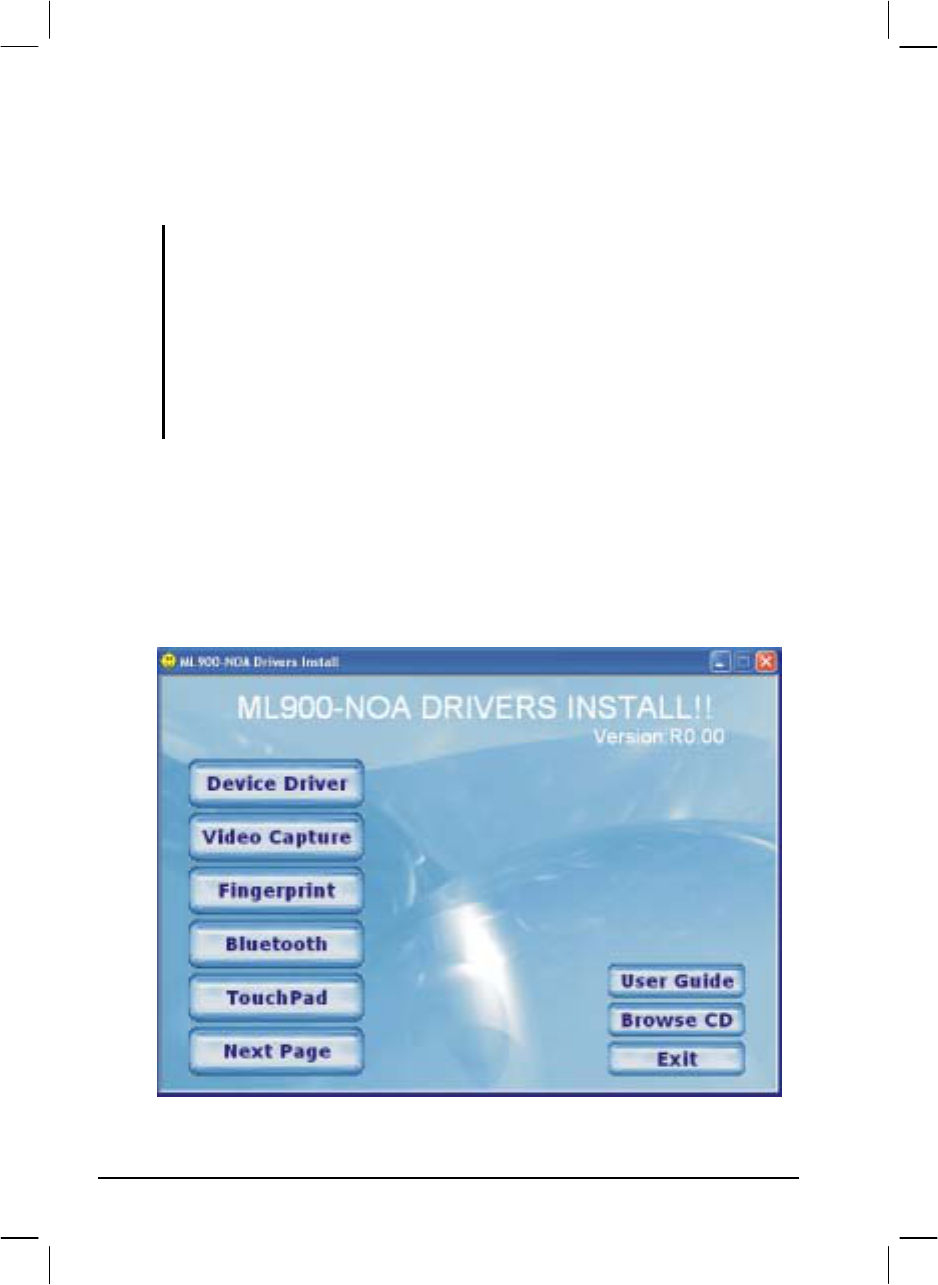
6-2 Installing Software Drivers
How to Use the Driver CD
NOTES:
• The drivers may have been updated after this manual was published. For driver
upgrade, please contact your dealer.
• You can always find README or document files on the driver CD. These files
contain the latest information from the software supplier. Please read the files
together with this chapter.
• This driver CD supports Windows 2000 and Windows XP only.
• The available items may differ according to your computer model and operation
system.
An autorun program is provided on the driver CD to help you easily
install the drivers. As you insert the driver CD, the autorun program
automatically starts. If you need to start the program manually, run the
Autorun.exe program from the Setup directory of the driver CD.
The main screen appears as shown next:

Installing Software Drivers 6-3
Drivers on the First Page
To install the necessary driver, just click on the particular option and
follow the onscreen instructions to continue and complete installation.
Device Driver Installs the device drivers (chipset, VGA, LAN, audio,
modem, etc.).
Video Capture Shows you the instructions on installing the driver that
allows you to connect a video capture device through
the AV input port.
Fingerprint Shows you the instructions on installing the driver that
allows you to use the fingerprint recognition system
and its application software.
Bluetooth Allows you to connect to Bluetooth-compliant
devices.
Touchpad Allows you to take full advantage of the touchpad and
the scroll button features.
User Guide Allows you to view the Operation Manual on screen.
Browse CD Browses the contents of this CD.
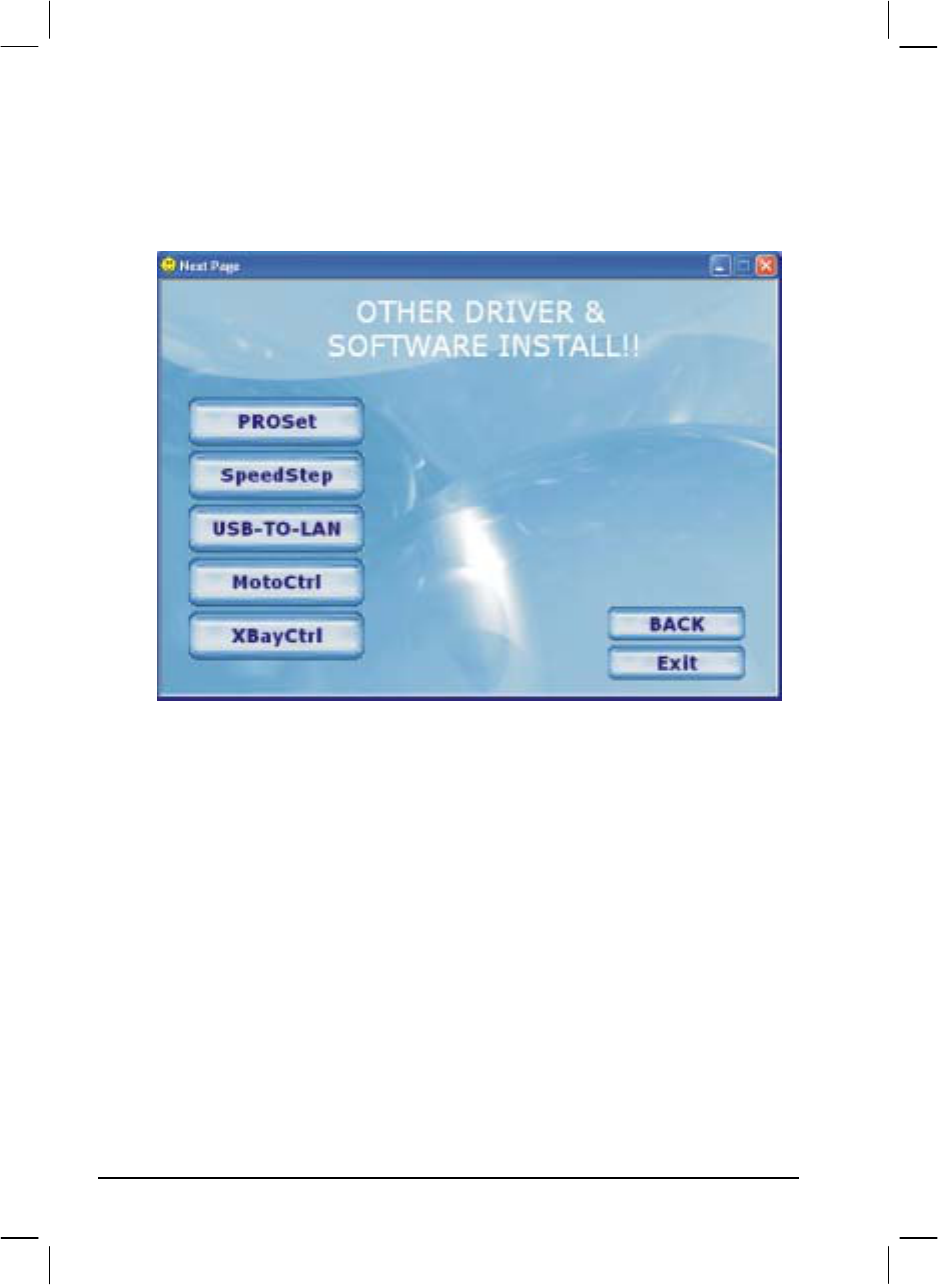
6-4 Installing Software Drivers
Upon clicking “Next Page,” the following screen appears:
Drivers on the Second Page
PROSet Installs the WLAN Utility that allows your system to
connect wirelessly to the Internet.
SpeedStep Allows you to use the SpeedStep function of the
computer (for Windows 2000 only).
USB-to-LAN Allows you to use the network function of the
computer when the optional docking station is
connected.
MotoCrtl Installs the Motorola proprietary control utility
XBayCtrl Installs the X-bay control utility.
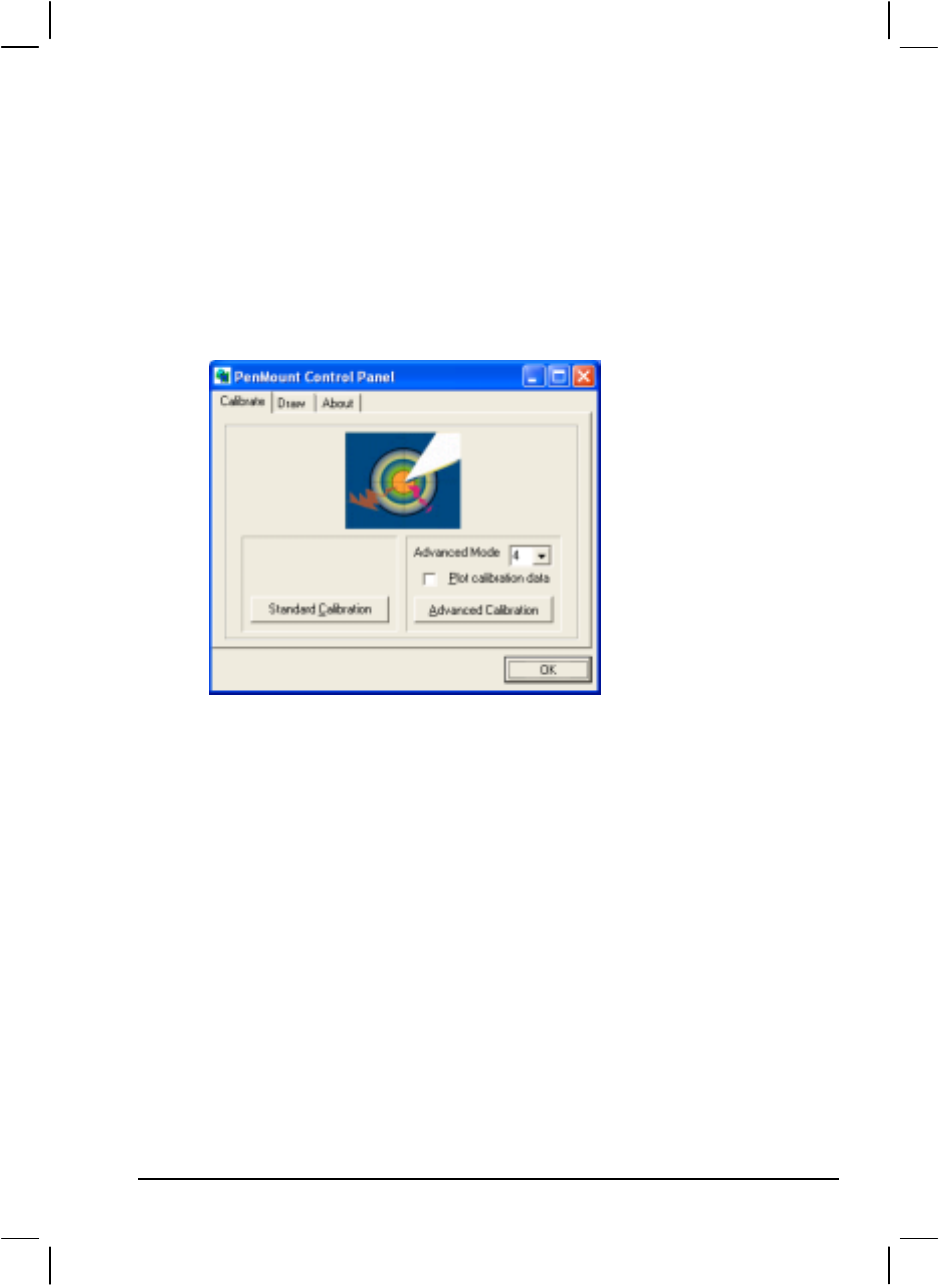
Installing Software Drivers 6-5
Install Touch Screen Driver for Windows 2000, Windows XP
1. After the system has finished rebooting, click on the
“PenMount Monitor icon located on the taskbar to bring up the
“PenMount Control Panel.”
2. Select the “ Standard Calibration” folder and click on “OK” button.
When the “PENMOUNT Control Panel” dialog box appears, click
on the “Calibrate” folder and click on the “Standard Calibration” button.
3. If you need 4,9,16,25 dot of the calibrate, we suggest select “Advanced
Calibration” button to calibrate.
4. Click on the four sides (points) and the plus-sign “+” on the screen
to calibrate your “PENMOUNT” pen for use on the computer.

CHAPTER 7
Caring for the Computer
Taking good care of your computer will ensure a trouble-free operation
and reduce the risk of damage to your computer.
This chapter gives you guidelines covering these areas of maintenance:
How to protect the computer
What to note when using and storing the computer
How to clean the computer
What to note when using the battery pack
What to note when traveling with the computer

7-2 Caring for the Computer
Protecting the Computer
To safeguard the integrity of your computer data as well as the computer
itself, you can protect the computer in several ways as described in this
section.
Using the Password
The power-on password protects your computer against unauthorized
use. If the password is set, the prompt requesting for the password
appears on the screen whenever the computer is turned on.
The password is set via the SCU program. See “Security Menu” in
Chapter 5 for instructions.
Using an Anti-Virus Strategy
New viruses are always being developed nowadays and they are attacking
computers even more easily with emails so commonly used worldwide.
The Security feature of the SCU program protects the boot sector of the
hard disk. To enable the function, see “Security Menu” in Chapter 5 for
instructions.
You can also install a virus-detecting program to monitor potential
viruses that could damage your files.

Caring for the Computer 7-3
Taking Care of the Computer
Location Guidelines
Use the computer where the temperature is between 0 °C (32 °F) and
50 °C (122 °F).
Avoid placing the computer in a location subject to high humidity,
extreme temperatures, mechanical vibration, direct sunlight, or heavy
dust.
Do not cover or block any ventilation openings on the computer. For
example, do not place the computer on a bed, sofa, rug, or other
similar surface. Otherwise, overheating may occur that results in
damage to the computer.
Keep the computer at least 13 cm (5 inches) away from electrical
appliances that can generate a strong magnetic field such as a TV,
refrigerator, motor, or a large audio speaker.
Do not move the computer abruptly from a cold to a warm place. A
temperature difference of more than 10 °C (18 °F) will cause
condensation inside the unit, which may damage the storage media.
Do not place the computer on an unsteady surface.
General Guidelines
Do not place heavy objects on top of the computer as this may
damage the display.
The screen surface is easily scratched. Do not use paper towels to
clean the display. Avoid touching it with a ballpoint pen or pencil.
To maximize the life of the backlight in the display, allow the
backlight to automatically turn off as a result of power management.
Avoid using a screen saver or other software that prevents the power
management from working.

7-4 Caring for the Computer
Cleaning Guidelines
Never clean the computer with its power on.
Use a soft cloth moistened with water or a non-alkaline detergent to
wipe the exterior of the computer.
Gently wipe the display with a soft, lint-free cloth. Do not use alcohol
or detergent on the display.
Dust on the IR/Bluetooth port can interfere with data transfer. Wipe
the port with a soft, dry cloth.
Dust or grease on the touchscreen can affect its sensitivity. Clean the
touchscreen by using adhesive tape to remove the dust and grease on
its surface.
Battery Pack Guidelines
Recharge the battery pack when it is nearly discharged. When
recharging, make sure the battery pack is fully charged. Doing so
may avoid harm to the battery pack.
Operate the computer with the battery pack installed even when using
external power. This ensures that the battery is fully charged.
If you will not be using the computer for a long period of time (more
than two weeks), remove the battery pack from the computer.
If you remove the battery pack, make sure the battery terminals do
not contact any conductors such as metal objects or water. Otherwise,
the battery may become unusable as a result of a short circuit.
If you need to store the battery pack, store it in a cool, dry place.
Never allow the temperature to exceed 70 °C (158 °F).
Do not leave the battery pack in storage for more than 3 months
without recharging it.

Caring for the Computer 7-5
When Traveling
Before traveling with your computer, make a backup of your hard
disk data into optical discs or other storage devices. As an added
precaution, bring along an extra copy of your important data.
Make sure the battery pack is fully charged.
Make sure the computer is turned off.
Do not leave objects that will press onto the display.
Disconnect the AC adapter from the computer and take it with you.
Use the AC adapter as the power source and as a battery-charger.
Hand-carry the computer. Do not check it in as luggage.
Allow extra time for airport security. Many airports inspect
electronic devices carefully.
If you need to leave the computer in the car, put it in the trunk of the
car to avoid exposing the computer to excessive heat.
When going through airport security, it is recommended that you
send the computer and USB disks through the X-ray machine (the
device you set your bags on). Avoid the magnetic detector (the device
you walk through) or the magnetic wand (the hand-held device used
by security personnel).
If you plan to travel abroad with your computer, consult your dealer
for the appropriate AC power cord for use in your country of
destination.

7-6 Caring for the Computer

CHAPTER 8
Troubleshooting
Hardware, software, or a combination of both can cause computer
problems. When you encounter any problem, it might be a typical
problem that can easily be solved.
This chapter tells you what actions to take when solving common
computer problems. It is divided into three sections:
Preliminary checklist
Solving common problems
Resetting the computer

8-2 Troubleshooting
Preliminary Checklist
Here are helpful hints to follow before you take further actions when you
encounter any problem:
Try to isolate which part of the computer is causing the problem.
Make sure that you turn on all peripheral devices before turning on
the computer.
If an external device has a problem, make sure that the cable
connections are correct and secure.
Make sure that the configuration information is properly set in the
SCU program.
Make sure that all the device drivers are correctly installed.
Make notes of your observations. Are there any messages on the
screen? Do any indicators light? Do you hear any beeps? Detailed
descriptions are useful to the service personnel when you need to
consult one for assistance.
If any problem persists after you follow the instructions in this chapter,
contact an authorized dealer for help.

Troubleshooting 8-3
Solving Common Problems
For easy reference, the problems are divided into these categories.
Problem Type Go to
Battery Problems P. 8-4
Bluetooth Problems P. 8-4
DVD Drive Problems P. 8-4
Display Problems P. 8-5
Fingerprint Recognition Problems P. 8-7
Hardware Device Problems P. 8-7
Hard Disk Drive Problems P. 8-8
Infrared Problems P. 8-8
Keyboard, Mouse and Touchpad Problems P. 8-9
LAN Problems P. 8-9
WLAN Problems P. 8-10
Modem Problems P. 8-10
Power Management Problems P. 8-12
Software Problems P. 8-12
Sound Problems P. 8-13
Startup Problems P. 8-13
Other Problems P. 8-14

8-4 Troubleshooting
Battery Problems
The battery does not charge (Battery Charge indicator does not light
amber).
Make sure that the AC adapter is properly connected.
Make sure that the battery is not too hot or cold. Allow time for the
battery pack to return to room temperature.
Make sure that the battery pack is installed correctly.
Make sure that the battery terminals are clean.
The operating time of a fully charged battery becomes shorter.
If you often partially recharge and discharge, the battery might not be
charged to its full potential. Initialize the battery to solve the problem.
(See “Initializing the Battery Pack” in Chapter 3 for instructions.)
The battery operating time indicated by the battery meter does not
match the actual operating time.
The actual operating time can be different from the estimated time,
depending on how you are using the computer. If the actual operating
time is much less than the estimated time, initialize the battery. (See
“Initializing the Battery Pack” in Chapter 3 for instructions.)
Bluetooth Problems
I cannot connect to another Bluetooth-enabled device.
Make sure that both devices have activated Bluetooth.
Make sure that the distance between the two devices are not over 10
meters or that there are no walls or other obstructions between the
devices.
Make sure that the other device is not in “Hidden” mode.
Make sure that both devices are compatible.
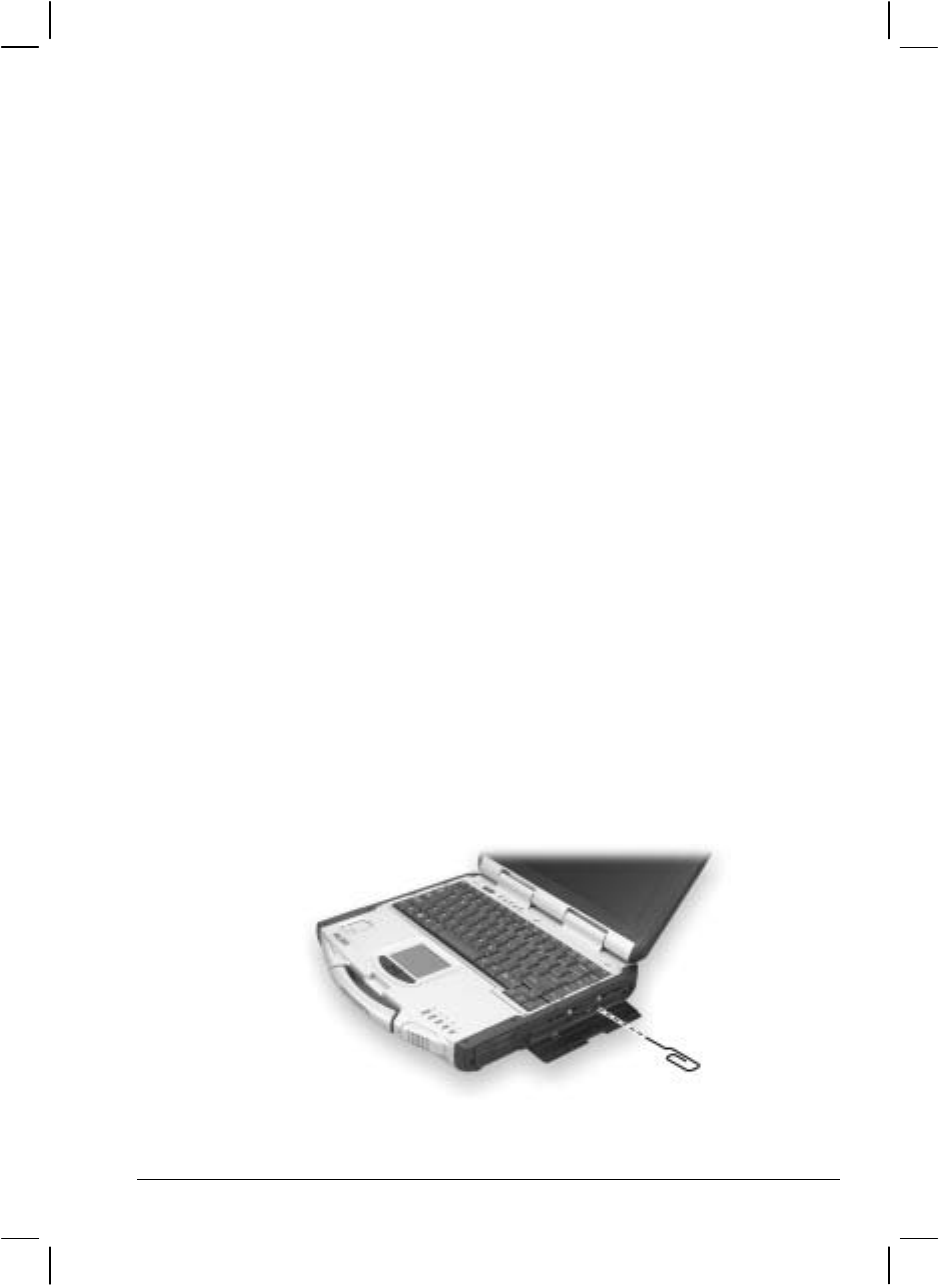
Troubleshooting 8-5
I cannot end a Bluetooth connection.
If another device is connected to your computer, you can either end
the connection using the other device or by deactivating Bluetooth.
DVD Drive Problems
The DVD drive cannot read a disc.
Make sure that the disc is correctly seated in the tray, with the label
facing up.
Make sure that the disc is not dirty. Clean the disc with a disc cleaning
kit, available in most computer stores.
Make sure that the DVD drive driver is installed correctly.
Make sure that the computer supports the disc or the files contained.
You cannot eject a disc.
The disc is not properly seated in the drive. Manually release the disc
following the method described next:
1. Turn off the system.
2. Insert a small rod, such as a straightened paperclip, into the drive’s
manual eject hole and push firmly to release the tray.
3. Pull the tray out until fully extended, and then remove the disc.

8-6 Troubleshooting
Display Problems
Nothing appears on the screen.
If the power-on indicator is not on, check the electrical outlet, the
plugs and power cords.
If the power button does not respond to a light touch, press the button
firmly.
If you are using battery power, make sure that it has a charge
remaining and that it is installed correctly.
During operation, the screen may automatically turn off as a result of
power management. Press any key to see if the screen comes back.
The brightness level might be too low. Increase brightness by pressing
Fn+F6.
The display output might be set to an external device. To switch the
display back to the LCD, press Fn+F9, or change the display through
the settings in Display Properties.
Reset the computer by pressing the keyboard BIOS reset switch on
the left side of the computer or by pressing Ctrl+Alt+Del keys.
Try turning the computer off, wait for a few seconds, then turn it back
on.
The characters on the screen are dim.
Adjust the brightness and/or contrast.
Bad dots appear on the display at all times.
A small number of missing, discolored, or bright dots on the screen
are an intrinsic characteristic of TFT LCD technology. It is not
regarded as a LCD defect. The Inspection Standard generally agreed
in the LCD industry allows a maximum of 8 bad dots on a unit.
Resolution cannot be adjusted to desired setting.
Make sure that the video driver is installed correctly.
The external monitor displays nothing.
Make sure that the monitor is turned on.

Troubleshooting 8-7
Make sure that the monitor’s signal cable is properly connected.
Switch the display to the monitor by pressing Fn+F9, or change the
display through the settings in Display Properties.
Simultaneous display/multi-display does not work.
Make sure that you turn on the external monitor before turning on the
computer.
Press Fn+F9 to toggle through the display options or change the
settings in Display Properties in Windows.
Fingerprint Recognition Problems
The fingerprint recognition application does not work.
Make sure that the necessary driver is correctly installed.
Make sure that your finger is properly placed on the surface of the
sensor.
Hardware Device Problems
The computer does not recognize a newly installed device.
The device may not be correctly configured in the SCU program. Run
the SCU program to identify the new type.
Make sure if any device driver needs to be installed. (Refer to the
documentation that came with the device.)
Make sure if the device needs any jumper or switch settings. (Refer to
the documentation that came with the device.)
Check the cables or power cords for correct connections.
For an external device that has its own power switch, make sure that
the power is turned on.

8-8 Troubleshooting
Hard Disk Drive Problems
The hard disk drive error message appears on the screen.
Insert a bootable diskette and check the integrity of your hard drive.
The hard disk drive has defects. Ask your dealer for help.
The hard disk drive operations seem slow.
The data files stored on the hard disk drive may be fragmented. Use a
tool such as Window’s Disk Defragmenter to defragment the files.
The hard disk drive in-use indicator glows without blinking.
The data files stored on the hard disk drive may be fragmented. Use a
tool such as Window’s Disk Defragmenter to defragment the files.
Infrared Problems
The IR port does not work.
Make sure that the IR ports of the two device face each other within a
±15-degrees angle and 1 meter (3 feet) distance and there are no
obstructions in between.
Make sure that the device connected is using an equivalent speed.
Make sure that the IrDA Fast Infrared Port is set to HP
HSDL-2300/3600.
Make sure that the IR port is set correctly in the SCU program.
If you are printing to an infrared printer, make sure that the
appropriate driver is installed.
If you are using any file transfer functions, make sure that both the
computer and the IR device have the appropriate software running.
Make sure that there is no device radiating infrared rays, such as
remote-controlled devices or wireless headphones, near the computer
or device.
Make sure that no direct sunlight or fluorescent lamps are near the
computer or device.

Troubleshooting 8-9
Make sure that the IR ports are clean.
Keyboard, Mouse and Touchpad Problems
The keyboard does not respond.
Try connecting an external keyboard. If it works, contact an
authorized dealer, as the internal keyboard cable might be loose.
The numeric keypad is disabled.
Make sure that the Num Lk is switched on. (Check if the Num Lock
Indicator glows or not.)
The external keyboard does not work.
Make sure that the keyboard cable is properly connected.
The USB mouse does not work.
Make sure that the mouse cable is properly connected.
The touchpad does not work, or the pointer is difficult to control
with the touchpad.
Make sure that the touchpad is clean.
LAN Problems
I cannot access the network.
Make sure that the LAN driver is correctly installed.
Make sure that the LAN cable is properly connected to the RJ-45
connector and the network hub.
Make sure that the network configuration is appropriate.
Make sure that the user name or password is correct.

8-10 Troubleshooting
WLAN Problems
I cannot use the WLAN feature.
Make sure that the Mini PCI WLAN card is correctly installed.
Make sure that the necessary driver(s) is correctly installed.
Make sure that the WLAN feature is turned on.
Transmission quality is poor.
Your computer may be in an out-of-range situation. Move your
computer closer to the Access Point or another WLAN device it is
associated with.
Check if there is high interference around the environment and solve
the problem as described next.
Radio interference exists.
Move your computer away from the device causing the radio
interference such as microwave oven and large metal objects.
Plug your computer into an outlet on a different branch circuit from
that used by the affecting device.
Consult your dealer or an experienced radio technician for help.
I cannot connect to another WLAN device.
Make sure that the WLAN feature is turned on.
Make sure that the SSID setting is the same for every WLAN device
in the network.
Your computer is not recognizing changes. Restart the computer.
Make sure that the IP address or subnet mask setting is correct.
I cannot communicate with the computer in the network when
Infrastructure mode is configured.
Make sure that the Access Point your computer is associated with is
powered on and all the LEDs are working properly.

Troubleshooting 8-11
If the operating radio channel is in poor quality, change the Access
Point and all the wireless station(s) within the BSSID to another radio
channel.
Your computer may be in an out-of-range situation. Move your
computer closer to the Access Point it is associated with.
Make sure that your computer is configured with the same security
option (encryption) to the Access Point.
Use the Web Manager/Telnet of the Access Point to check whether it
is connected to the network.
Reconfigure and reset the Access Point.
I cannot access the network.
Make sure that the necessary driver(s) is correctly installed.
Make sure that the network configuration is appropriate.
Make sure that the user name or password is correct.
You have moved out of range of the network.
Turn off power management.
Modem Problems
The modem does not work.
Make sure that the modem driver is correctly installed.
Make sure that the COM port in the communication software is
correctly set.
Turn off power management.

8-12 Troubleshooting
Power Management Problems
The computer does not enter Standby or Hibernation mode
automatically.
If you have a connection to another computer, the computer does not
enter Standby or Hibernation mode if the connection is actively in
use.
Make sure that the Standby or Hibernation time-out is enabled.
The computer does not enter Standby or Hibernation mode
immediately.
If the computer is performing an operation, it normally waits for the
operation to finish.
The computer does not resume from Standby or Hibernation mode.
The computer automatically enters Standby or Hibernation mode
when the battery pack is empty. Do any one of the following:
− Connect the AC adapter to the computer.
− Replace the empty battery pack with a fully charged one.
The computer does not enter Hibernation mode with the Fn+F10 hot
keys.
Make sure that the Hibernation function is specified for the sleep
button.
Software Problems
An application program does not work correctly.
Make sure that the software is correctly installed.
If an error message appears on the screen, consult the software
program’s documentation for further information.
If you are sure the operation has stop, reset the computer. (See
“Resetting the Computer” later in this chapter.)

Troubleshooting 8-13
Sound Problems
No sound is produced.
Make sure that the volume control is not set too low.
Make sure that the audio driver is correctly installed.
Make sure that the computer is not in Standby mode.
If using an external speaker, make sure that the speaker is properly
connected.
Distorted sound is produced.
Make sure that the volume control is not set too high or too low. In
most cases, a high setting can cause the audio electronics to distort the
sound.
The sound system does not record.
Adjust the playback or recording sound levels.
The external microphone or audio device does not work.
Make sure that the microphone is connected to the proper connector
on the computer.
Make sure that your computer is equipped with the driver needed.
Click the speaker symbol on the taskbar and check the Windows
volume control.
Check the volume control of your computer.
Startup Problems
When you turn on the computer, it does not respond and the Power
Indicator does not light green.
If you are using an external AC power, make sure that the AC adapter
is correctly and securely connected. If so, make sure that the electrical
outlet works properly.

8-14 Troubleshooting
If you are using the battery power, make sure that the battery is not
discharged.
When you turn on the computer, it stops after POST.
Restart your computer.
Other Problems
The date/time is incorrect.
Correct the date and time via the operating system or SCU program.
After you have performed everything as described above and still
have the incorrect date and time every time you turn on the computer,
the RTC (Real-Time Clock) battery is at the end of its life. Call an
authorized dealer to replace the RTC battery.
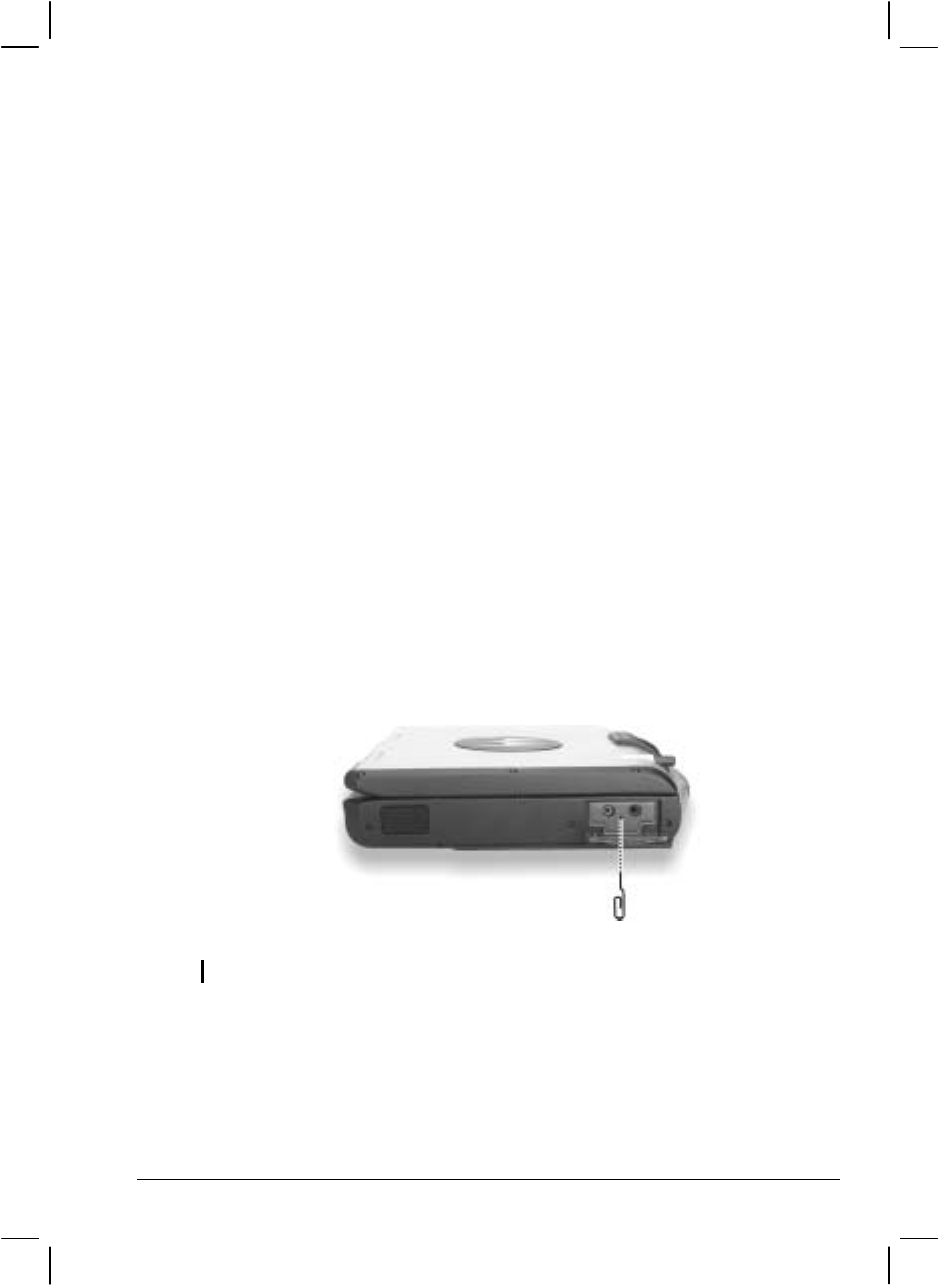
Troubleshooting 8-15
Resetting the Computer
You may have to reset (reboot) your computer on some occasions when
an error occurs and the program you are using hangs up.
If the system operation seems to hang up, first wait. It is possible that the
system is processing data. Periodically check the hard disk drive in-use
indicator, if it flashes irregularly, the program may be accessing data and
preventing you from using the keyboard. If you are sure the operation has
stopped and you cannot use the “restart” function of the operating system,
reset the computer.
Reset the computer by any one of these methods:
Press Ctrl+Alt+Del.
If the above action does not work, turn off the system. Wait for at least
five seconds and turn it on again.
If the above does not work, insert a small rod, such as a straightened
paper clip, into the keyboard BIOS reset switch on the left side of the
computer and press firmly. The system will shut down. Wait for at
least five seconds and turn it on again.
CAUTION: Resetting will cause any unsaved data to be lost.

8-16 Troubleshooting
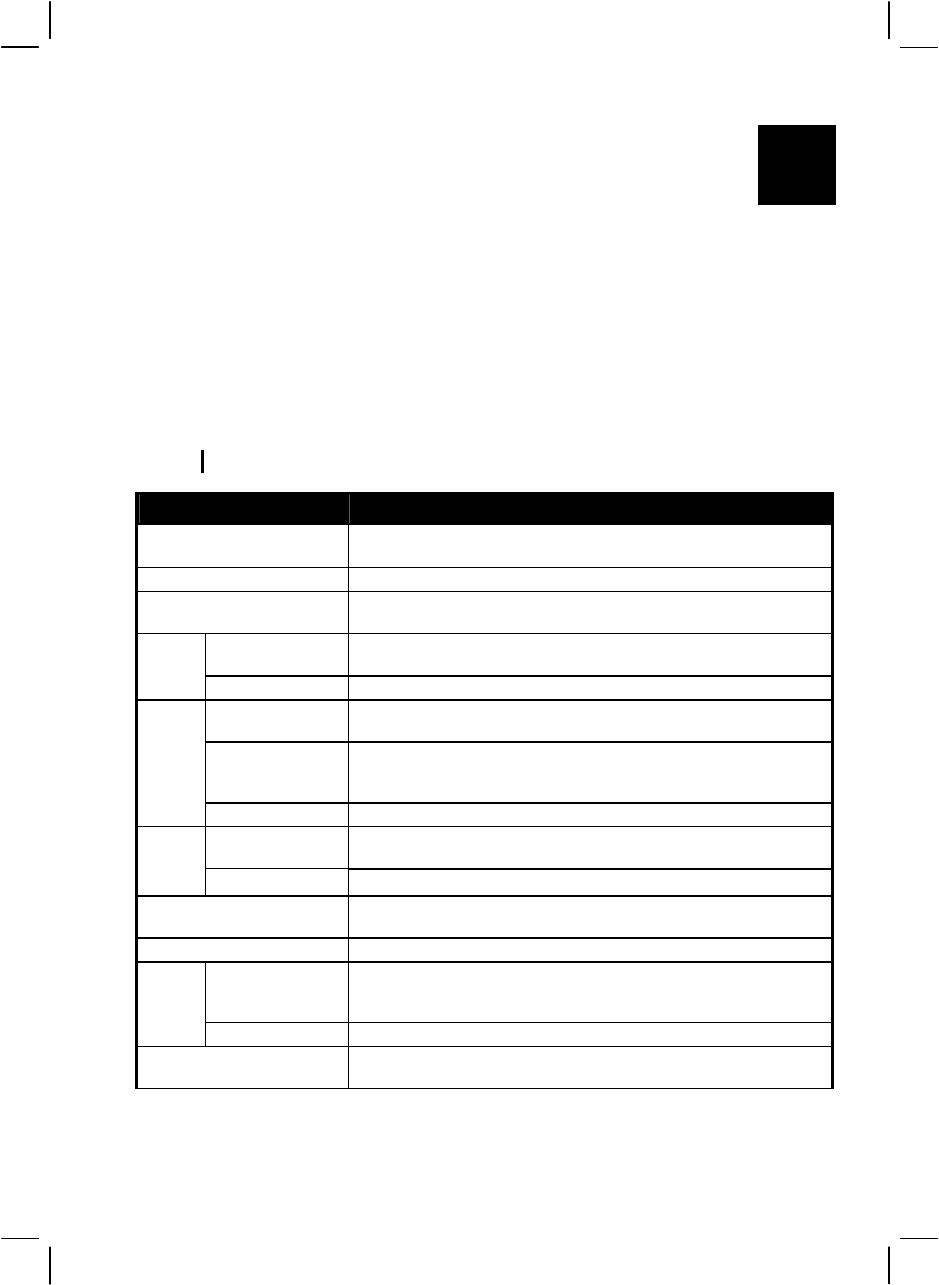
APPENDIX A
Specifications
NOTE: Specifications are subject to change without any prior notices.
Parts Specifications
CPU Intel Mobile Pentium Dothan Processor-M series, µ-FCPGA package,
1.8 GHz; Front Side Bus (FSB) 400 MHz, 21 W thermal ceiling
Cache Memory L2 2 MB on-die
ROM BIOS 512 KB Flash EEPROM, system and VGA BIOS, ACPI 2.0,
PC2001-compliant
System Two 200-pin 200/266/333 MHz DDR SO-DIMM sockets,
maximum 2 GB (standard 256 MB)
RAM
Video 64 MB (shared system memory)
Panel 12.1-inch XGA transmissive LCD, polarizer touchscreen,
high contrast (option)
Video controller 855GME, integrated 32-bit 3D/2D gfx core with Dynamic Video Memory
technology, supports DirectX® 8.1, dual view function, LCD/CRT
simultaneous display capability
Display
Video port DVI-I port, video capture
Controller ALC202 codec, AC97 Rev.2.2 support,
two 2-watt stereo speakers built-in
Audio
Ports Two audio ports for Mic-in / Line-out
Keyboard Full travel waterproof with membrane cover,
rubber keyboard and backlight feature (option)
Pointing device Four buttons touchpad
Hard disk drive 2.5-inch, Ultra DMA support, damper protection,
Flash Ultra DMA M-system (option),
built-in system heater for low temperature function (option)
Storage
device
Optical drive DVD drive / Combo drive / DVD Dual drive
I/O ports Serial port, two USB ports, IR port, docking port with guide-pin, two
antenna ports, RJ-45 port, RJ-11 port, fingerprint sensor (option)
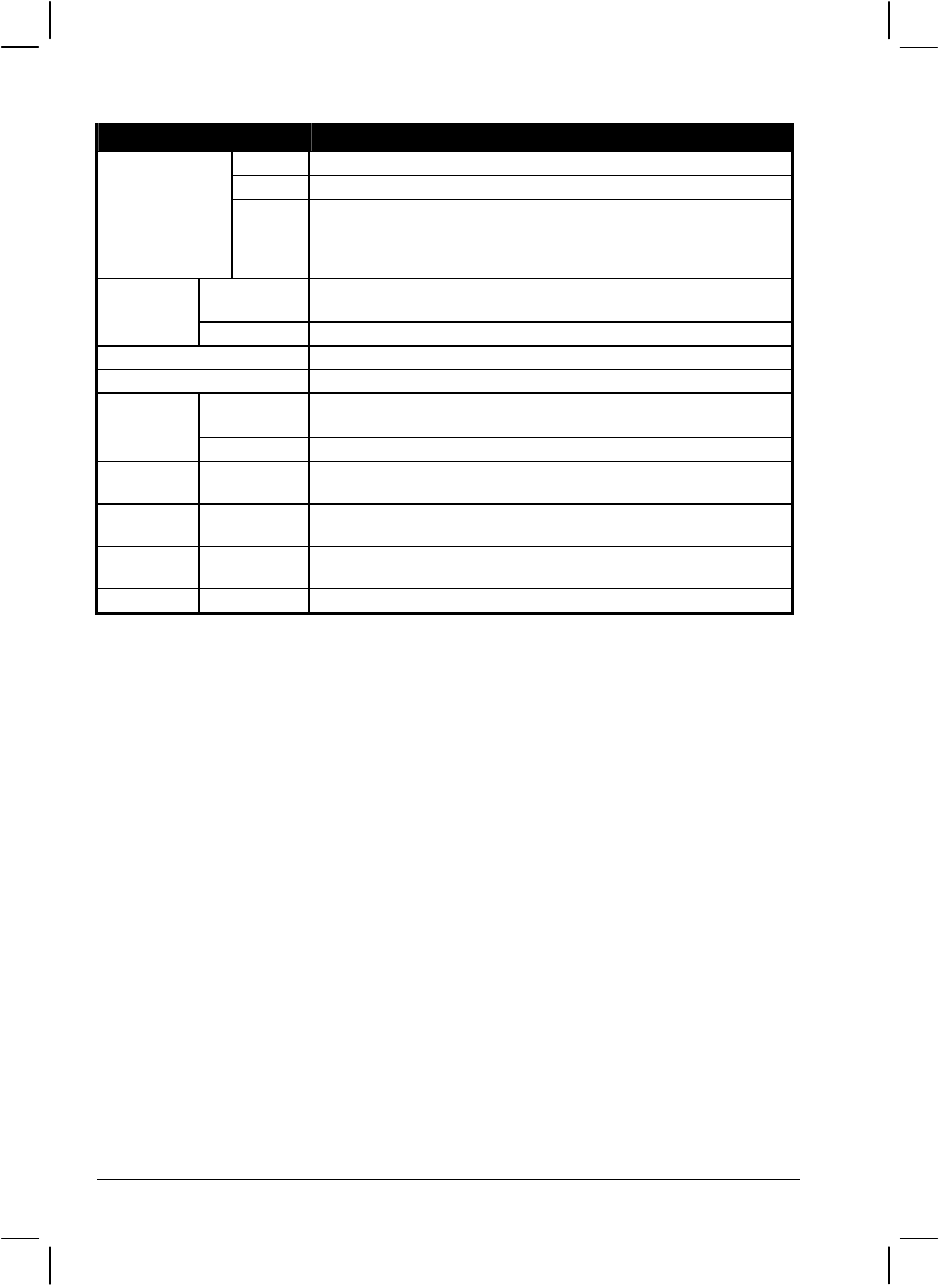
A-2 Specifications
Parts Specifications
Modem 56 K (V.90/V.92; 28,000 ~ 56,000 bits/s data rates)
LAN 10/100 Base-T Ethernet
Communications
Others
(options) Wireless LAN 802.11b/g using diversity antennas
GPS Lassen IQ module
Bluetooth Class 1
Wireless modem in X-Bay module
AC adapter Input: 100∼240 V AC, 50∼60 Hz universal adapter
Output: 19 V DC / 90 W
Power
Battery Smart Li-ion battery 11.1 V / 6000 mAH (9 cells)
Dimension (W×D×H) 11.8×9.5×2.3 inch (300×241×58 mm)
Weight 9.9 lb (4.5 kg)
Temperature Operating: 0 °C (32 °F) to 50 °C (122 °F)
Storage: –40 °C (–40 °F) to 70 °C (158 °F)
Environment
Humidity Operating: 5 % to 95 % RH, non-condensing
Altitude Operating: 15,000 ft
Storage: 40,000 ft (2,000 ft/min change rate)
Shock Operating: 20 g
Storage: 50 g
Vibration Operating: 10~55 Hz / 0.075, 55~500 Hz / 1 g
Storage: 10~55 Hz / 0.15, 55~500 Hz / 2 g
Drop Survives 3 ft drop on steel plate

APPENDIX B
Fingerprint Recognition System
Your system features a fingerprint recognition system designed for
computer security. It provides a high level of user convenience and gives
you a set of powerful tools for securing your computer and protecting
your private data. The system can:
• display fingerprint images derived from the sensor IC
• enroll new users
• extract fingerprint templates from raw images, and store them in a
local database
• match live-scan fingerprints against the local database
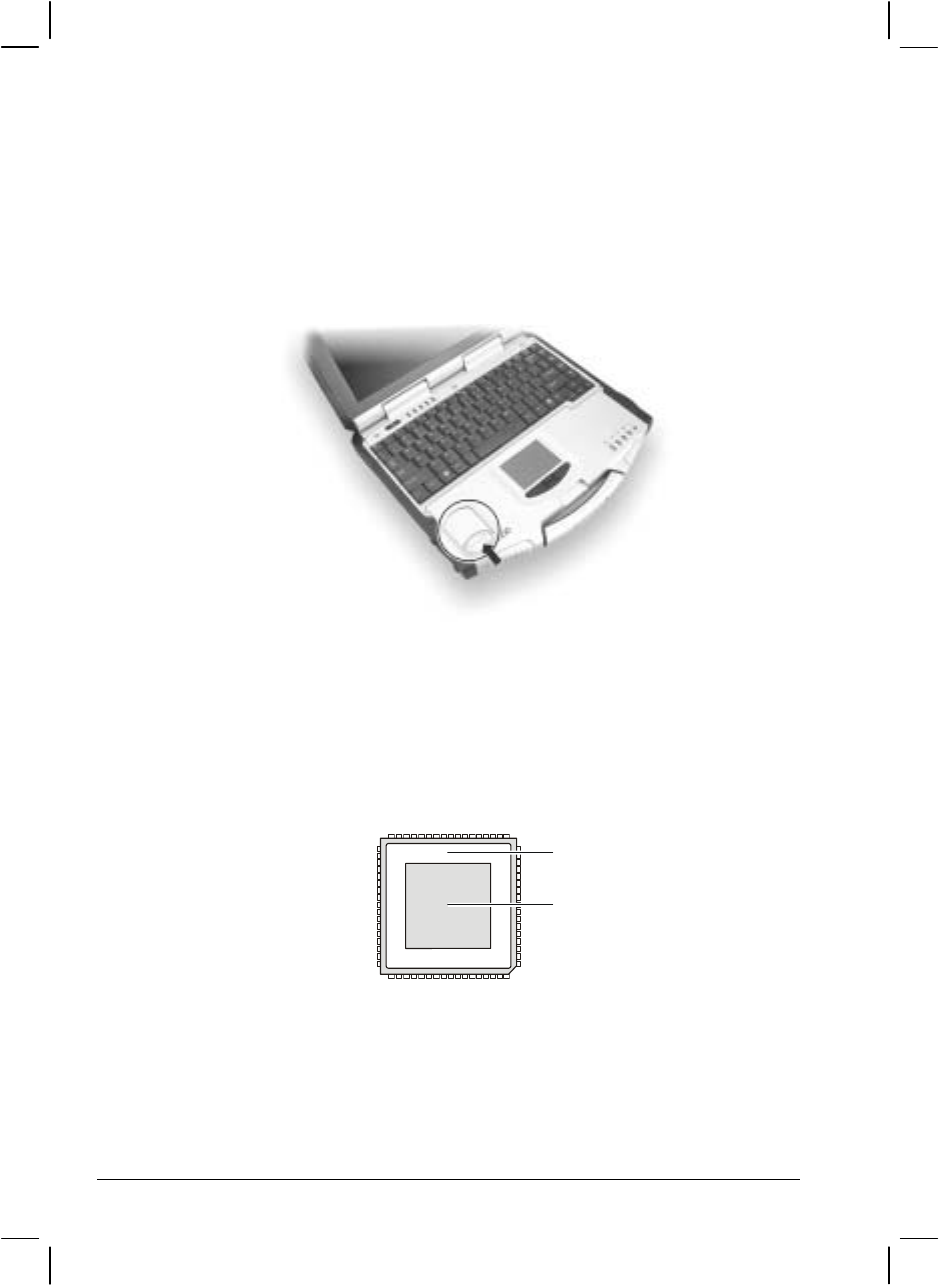
B-2 Fingerprint Recognition System
Finger Placement
When placing a finger to be enrolled or identified, slide the cover to
expose the sensor matrix surface, then use a light, but firm and steady
pressure.
Avoid moving your finger during the scan, and be sure that you are
making contact with the “sensor matrix” and with the surrounding drive
ring (the light-colored surface surrounding the matrix). The system works
best when it has a “core” image (the center of your fingerprint, which is
approximately opposite the line of the cuticle of your fingernail).
Drive ring
Sensor
matrix

Fingerprint Recognition System B-3
Using the Fingerprint Recognition System
Utility
NOTE: To take advantage of the fingerprint recognition system, the driver and utility
supplied with your computer must be installed (see chapter 6 for details).
Double-click on the icon located on your Windows’ system tray. The
main menu appears.
The following program options are available:
• Enroll – allows the sensor IC to acquire fingerprint images, process it
into the essential template data, and then insert it into the database
together with an associated User ID and other optional information.
• Identify – is used to compare the finger presented to the sensor
against all of the other fingerprints currently entered in the database
(known as one-to-many search).
• Validate ID – is used to perform a one-to-one verification to
ascertain if the person whose finger is placed on the sensor is in fact
the same as the person enrolled under a particular User ID.
• Data Capture – a viewing facility that is used to display (or capture)
a continuous series of real-time images of a fingerprint.
• Database – is used to review, delete, and otherwise manage the
contents of the database.
NOTE: For an online Help information on using the application, click on “Help” located
on the menu bar, then “Aware User’s Guide.”
A Readme.txt file is also located on your driver CD for late-breaking news, known
bugs, work-arounds, and other additions, deletions, or discrepancies in the application
program.

B-4 Fingerprint Recognition System

APPENDIX C
Regulatory Information
This appendix provides regulatory statements and safety notices on your
computer.
NOTE: Marking labels located on the exterior of your computer indicate the regulations
that your model complies with. Please check the marking labels and refer to the
corresponding statements in this appendix. Some notices apply to specific models only.

C-2 Regulatory Information
On the Use of the System
Class B Regulations
USA
Federal Communications Commission Radio Frequency Interference
Statement
NOTE:
This equipment has been tested and found to comply with the limits for a
Class B digital device pursuant to Part 15 of the FCC Rules. These limits
are designed to provide reasonable protection against harmful interference
in a residential installation. This equipment generates, uses, and can radiate
radio frequency energy and, if not installed and used in accordance with the
instructions, may cause harmful interference to radio communications.
However, there is no guarantee that interference will not occur in a
particular installation. If this equipment does cause harmful interference to
radio or television reception, which can be determined by turning the
equipment off and on, the user is encouraged to try to correct the
interference by one or more of the following measures:
Reorient or relocate the receiving antenna.
Increase the separation between the equipment and receiver.
Connect the equipment into an outlet on a circuit different from that to
which the receiver is connected.
Consult the dealer or an experienced radio/TV technician for help.
Any changes or modifications not expressly approved by the manufacturer
could void the user’s authority to operate the equipment.
Please note:
The use of a non-shielded interface cable with this equipment is
prohibited.

Regulatory Information C-3
Canada
Canadian Department of Communications
Radio Interference Regulations Class B Compliance Notice
This Class B digital apparatus meets all requirements of the Canada
Interference-Causing equipment regulations.
Cet appareil numérique de Classe B respecte toutes les exigences du
Règlement Canadien sur le matériel brouileur.
This digital apparatus does not exceed the Class B limits for radio noise
emissions from digital apparatus set out in the Radio Interference
Regulations of the Canadian Department of Communications.
Le présent appareil numérique n’émet pas de bruits radioélectriques
dépassant les limites applicables aux appareils numériques de la classe B
prescrites dans le Règlement sur le brouillage radioélectrique édicté par le
ministère des Communications du Canada.
Safety Notices
About the Battery
Caution Texts Concerning Lithium Batteries
DANISH
ADVARSEL! Lithiumbatteri – Eksplosionsfare ved fejlagtig håndtering. Udskiftning må
kun ske med batteri af samme fabrikat og type. Levér det brugte batteri tilbage til
leverandøren.
NORWEGIAN
ADVARSEL: Eksplosjonsfare ved feilaktig skifte av batteri. Benytt samme batteritype
eller en tilsvarende type anbefalt av apparatfabrikanten. Brukte batterier kasseres i
henhold til fabrikantens instruksjoner.
SWEDISH
VARNING: Explosionsfara vid felaktigt batteribyte. Använd samma batterityp eller en
ekvivalent typ som rekommenderas av apparattillverkaren. Kassera använt batteri enligt
fabrikantens instruktion.
FINNISH
VAROITUS: Paristo voi räjähtää, jos se on virheellisesti asennettu. Vaihda paristo
ainoastaan valmistajan suosittelemaan tyyppiin. Hävitä käytetty paristo valmistajan
ohjeiden mukaisesti.

C-4 Regulatory Information
ENGLISH
CAUTION: Danger of explosion if battery is incorrectly replaced. Replace only with the
same or equivalent type recommended by the equipment manufacturer. Discard used
batteries according to manufacturer's instructions.
DEUTSCH
VORSICHT: Explosionsgefahr bei unsachgemäßem Austausch der Batterie. Ersatz nur
durch denselben oder einen vom Hersteller empfohlenen gleich-wertigen Typ.
Entsorgung gebrauchter Batterien nach Angaben des Herstellers.
FRENCH
ATTENTION: II y a danger d’explosion s’il y a remplacement incorrect de la batterie.
Remplacer uniquement avec une batterie du même type ou d’un type équivalent
recommandé par le constructeur. Mettre au rebut les batteries usagées conformément aux
instructions du fabricant.
Attention (for USA Users)
The product that you have purchased contains a rechargeable battery. The battery is
recyclable. At the end of its useful life, under various state and local laws, it may be illegal
to dispose of this battery into the municipal waste stream. Check with your local solid
waste officials for details in your area for recycling options or proper disposal.
About the AC Adapter
Use only the AC adapter supplied with your computer. Use of another
type of AC adapter will result in malfunction and/or danger.
Do not use the adapter in a high moisture environment. Never touch
the adapter when your hands or feet are wet.
Allow adequate ventilation around the adapter when using it to
operate the device or charge the battery. Do not cover the AC adapter
with paper or other objects that will reduce cooling. Do not use the
AC adapter while it is inside a carrying case.
Connect the adapter to a proper power source. The voltage
requirements are found on the product case and/or packaging.
Do not use the adapter if the cord becomes damaged.
Do not attempt to service the unit. There are no serviceable parts
inside. Replace the unit if it is damaged or exposed to excess
moisture.

Regulatory Information C-5
About the Modem
Caution
Never install telephone wiring during a lightning storm.
Never install telephone jacks in wet locations unless the jack is
specifically designed for wet locations.
Never touch non-insulated telephone wires or terminals unless the
telephone line has been disconnected at the network interface.
Use caution when installing or modifying telephone lines.
Avoid using the telephone function (other than a cordless type) during
an electrical storm. There may be a remote risk of electric shock from
lightning.
Do not use the telephone function to report a gas leak in the vicinity of
the leak.
Do not use this product near water, for example near a bathtub, wash
bowl, kitchen sink or laundry tub, in a wet basement or near a
swimming pool.
Caution (for USA Users)
To reduce the risk of fire, use only No.26 AWG or larger
telecommunication line cord.

C-6 Regulatory Information
On the Use of RF Device
NOTE: The information in this section applies to models with the wireless LAN module.
USA and Canada Safety Requirements and Notices
IMPORTANT NOTE: To comply with FCC RF exposure compliance
requirements, the antenna used for this transmitter must be installed to
provide a separation distance of at least 20 cm from all persons and must
not be co-located or operating in conjunction with any other antenna or
transmitter.
Radio Frequency Interference Requirements and SAR
The FCC with its action in ET Docket 93-62 has adopted a safety
standard for human exposure to Radio Frequency (RF) electromagnetic
energy emitted by FCC certified equipment. The wireless LAN module
meets the Human Exposure limits found in OET Bulletin 65, 2001, and
ANSI/IEEE C95.1, 1992. Proper operation of this radio according to the
instructions found in this manual will result in exposure substantially
below the FCC’s recommended limits. The following safety precautions
should be observed:
Do not touch or move antenna while the unit is transmitting or
receiving.
Do not hold any component containing the radio such that the antenna
is very close or touching any exposed parts of the body, especially the
face or eyes, while transmitting.
Do not operate the radio or attempt to transmit data unless the antenna
is connected; if not, the radio may be damaged.
Use in specific environments:
The use of wireless devices in hazardous locations is limited by the
constraints posed by the safety directors of such environments.
The use of wireless devices on airplanes is governed by the Federal
Aviation Administration (FAA).

Regulatory Information C-7
The use of wireless devices in hospitals is restricted to the limits set
forth by each hospital.
Antenna use:
In order to comply with FCC RF exposure limits, low gain integrated
antennas should be located at a minimum distance of 20 cm (8 inches)
or more from the body of all persons.
High-gain, wall-mount, or mast-mount antennas are designed to be
professionally installed and should be located at a minimum distance
of 30 cm (12 inches) or more from the body of all persons. Please
contact your professional installer, VAR, or antenna manufacturer for
proper installation requirements.
Explosive Device Proximity Warning
WARNING: Do not operate a portable transmitter (such as a wireless
network device) near unshielded blasting caps or in an explosive
environment unless the device has been modified to be qualified for such
use.
Antenna Warning
WARNING: To comply with the FCC and ANSI C95.1 RF exposure
limits, it is recommended that the antenna for this device be installed so
as to provide a separation distance of at least 20 cm (8 inches) from all
persons and that the antenna must not be co-located or operating in
conjunction with any other antenna or radio transmitter. It is
recommended that the user limit exposure time if the antenna is
positioned closer than 20 cm (8 inches).
Use on Aircraft Caution
CAUTION: Regulations of the FCC and FAA prohibit airborne
operation of radio-frequency wireless devices because their signals could
interfere with critical aircraft instruments.

C-8 Regulatory Information
EMC Requirements
This device uses, generates and radiates radio frequency energy. The radio
frequency energy produced by this device is well below the maximum
exposure allowed by the Federal Communications Commission (FCC).
This device complies with the limits for a Class B digital device pursuant
to Part 15 subpart C of the FCC Rules and Regulations. Operation is
subject to the following two conditions:
(1) This device may not cause harmful interference.
(2) This device must accept any interference received, including
interference that may cause undesired operation.
The FCC limits are designed to provide reasonable protection against
harmful interference when the equipment is installed and used in
accordance with the instruction manual and operated in a commercial
environment. However, there is no guarantee that interference will not
occur in a particular commercial installation, or if operated in a residential
area.
If harmful interference with radio or television reception occurs when the
device is turned on, the user must correct the situation at the user’s own
expense. The user is encouraged to try one or more of the following
corrective measures:
Reorient or relocate the receiving antenna.
Increase the separation between the equipment and receiver.
Connect the equipment into an outlet on a circuit different from that to
which the receiver is connected.
Consult the dealer or an experienced radio/TV technician for help.
CAUTION: The Part 15 radio device operates on a non-interference
basis with other devices operating at this frequency. Any changes or
modification to said product not expressly approved by the manufacturer
could void the user’s authority to operate this device.

Regulatory Information C-9
Canada Radio Frequency Interference Requirements
To prevent radio interference to the licensed service, this device is
intended to be operated indoors and away from windows to provide
maximum shielding. Equipment (or its transmit antenna) that is installed
outdoors is subject to licensing.
Pour empêcher que cet appareil cause du brouillage au service faisant
l'objet d'une licence, il doit être utilisé à l'intérieur et devrait être placé
loin des fenêtres afin de fournir un écran de blindage maximal. Si le
matériel (ou son antenne d'émission) est installé à l'extérieur, il doit faire
l'objet d'une licence.
European Union CE Marking and Compliance Notices
Statements of Compliance
English
This product follows the provisions of the European Directive
1999/5/EC.
Danish
Dette produkt er i overensstemmelse med det europæiske direktiv
1999/5/EC.
Dutch
Dit product is in navolging van de bepalingen van Europees Directief
1999/5/EC.
Finnish
Tämä tuote noudattaa EU-direktiivin 1999/5/EC määräyksiä.
French
Ce produit est conforme aux exigences de la Directive Européenne
1999/5/EC.
German
Dieses Produkt entspricht den Bestimmungen der Europäischen
Richtlinie 1999/5/EC.

C-10 Regulatory Information
Greek
To προϊόν αυτό πληροί τις προβλέψεις της Ευρωπαϊκής Οδηγίας
1999/5/EC.
Icelandic
Þessi vara stenst reglugerð Evrópska Efnahags Bandalagsins númer
1999/5/EC.
Italian
Questo prodotto è conforme alla Direttiva Europea 1999/5/EC.
Norwegian
Dette produktet er i henhold til bestemmelsene i det europeiske direktivet
1999/5/EC.
Portuguese
Este produto cumpre com as normas da Diretiva Européia 1999/5/EC.
Spanish
Este producto cumple con las normas del Directivo Europeo 1999/5/EC.
Swedish
Denna produkt har tillverkats i enlighet med EG-direktiv 1999/5/EC.
Local Restrictions of 802.11b/g Radio Usage
CAUTION: Due to the fact that the frequencies used by 802.11b/g
wireless LAN devices may not yet be harmonized in all countries,
802.11b/g products are designed for use only in specific countries or
regions, and is not allowed to be operated in countries or regions other
than those of designated use. As a user of these products, you are
responsible for ensuring that the products are used only in the countries or
regions for which they were intended and for verifying that they are
configured with the correct selection of frequency and channel for the
country or region of use. Any deviation from permissible settings and
restrictions in the country or region of use could be an infringement of
local law and may be punished as such.
The European variant is intended for use throughout the European
Economic Area. However, authorization for use is further restricted in
particular countries or regions within countries, as follows:

Regulatory Information C-11
General
European standards dictate maximum radiated transmit power of 100
mW Effective Isotropic Radiated Power (EIRP) and the frequency range
2400 – 2483.5 MHz.
Belgium and the Netherlands
In Belgium and the Netherlands, the product may not be used outdoors.
See the instructions next under the heading “How to Turn Off the
Wireless LAN.”
France
Departments in Which the Wireless LAN Module Can Be Used
(Indoors Only)
The wireless LAN module can currently be used indoors only in the
following 38 departments of mainland France. Please turn off your
wireless LAN radio when operating the device in areas/places other than
the 38 departments listed:
01 Ain Orientales 36 Indre 66 Pyrénées
02 Aisne 37 Indre et Loire 67 Bas Rhin
03 Allier 41 Loir et Cher 68 Haut Rhin
05 Hautes Alpes 42 Loire 70 Haute Saône
08 Ardennes 45 Loiret 71 Saône et Loire
09 Ariège 50 Manche 75 Paris
11 Aude 55 Meuse 82 Tarn et Garonne
12 Aveyron 58 Nièvre 84 Vaucluse
16 Charente 59 Nord 88 Vosges
24 Dordogne 60 Oise 89 Yonne
25 Doubs 61 Orne 90 Territoire de Belfort
26 Drôme 63 Puy du Dôme 94 Val de Marne
32 Gers 64 Pyrénées Atlantique

C-12 Regulatory Information
Departments in Which the Wireless LAN Module’s Maximum EIRP
Not Shown in the Previous Table
Frequency Ranges (MHz) Indoors Outdoors
2400 – 2446.5 10 mW Not permitted
2446.5 – 2483.5 100 mW 100 mW on private property with
Ministry of Defense approval
Turning Off the Wireless LAN Radio
NOTE: Turning the wireless LAN radio off is not the same as disabling
the wireless LAN card. It is not necessary to disable the card to meet the
regulatory requirements.
While operating the computer in those French departments that do not
allow use of the wireless LAN equipment, the user of the equipment must
turn off the wireless LAN radio in order to comply with local regulations
(see chapter 2 for more information).